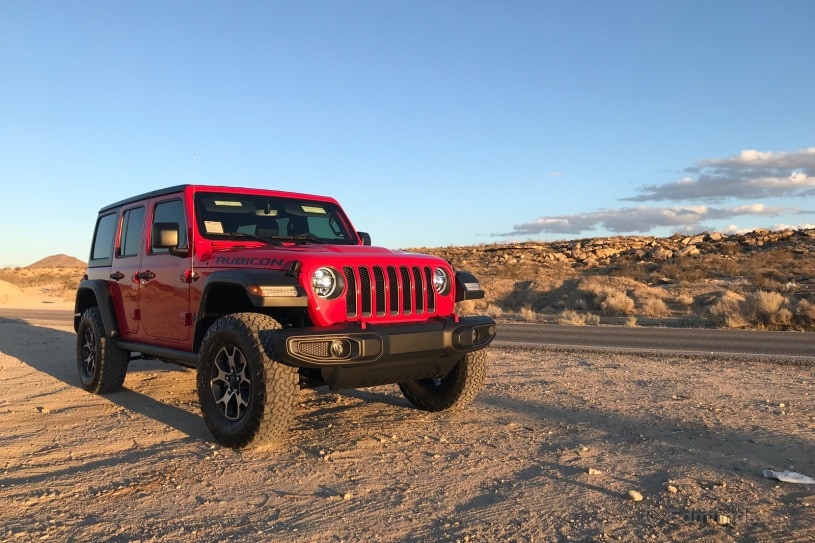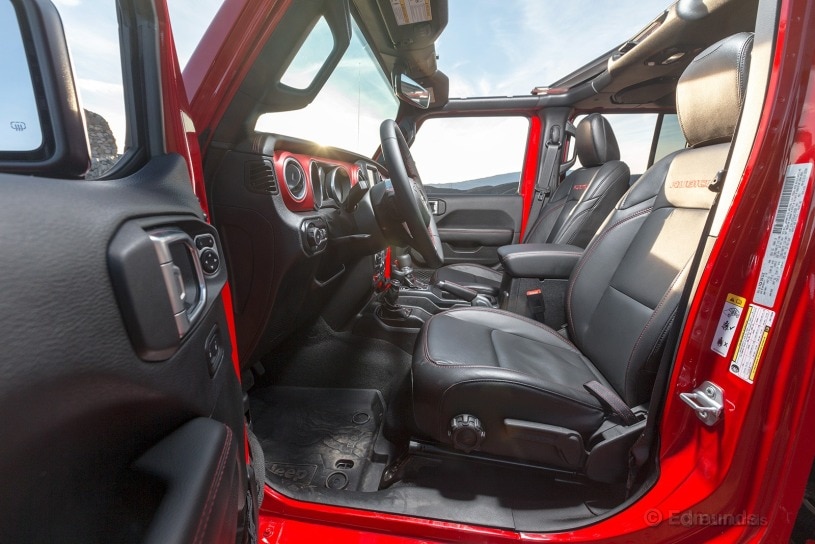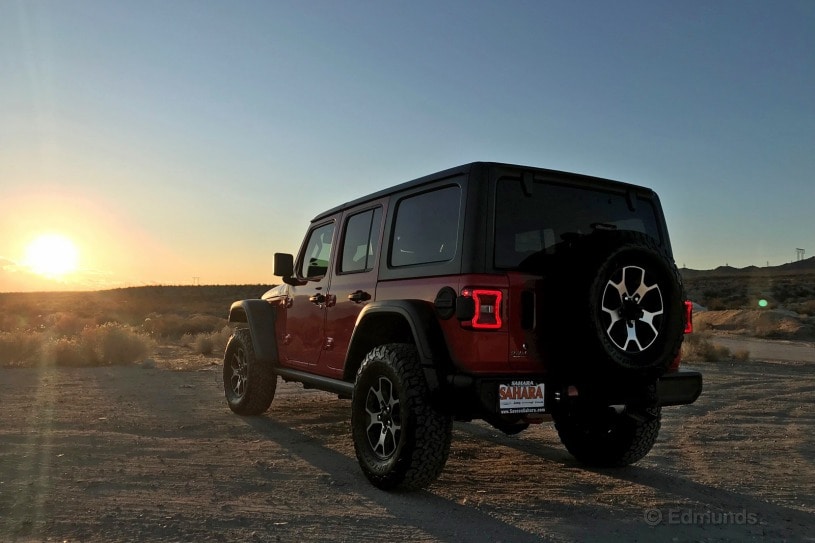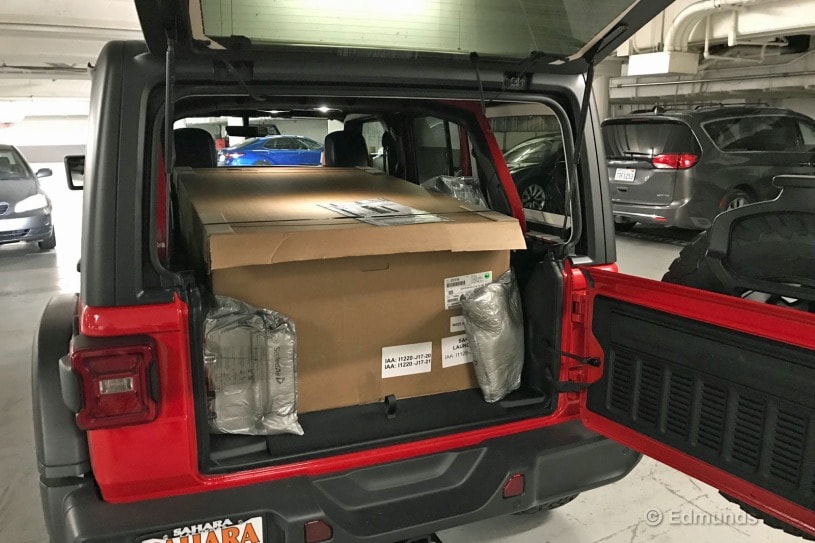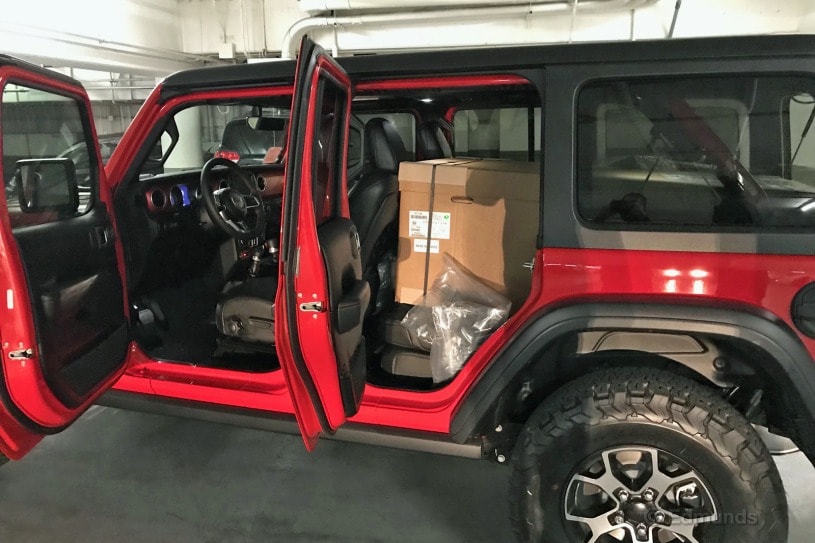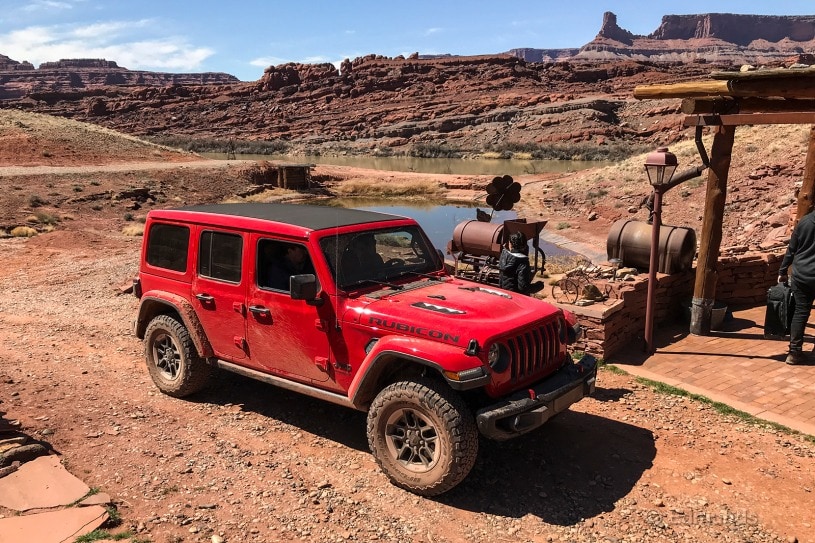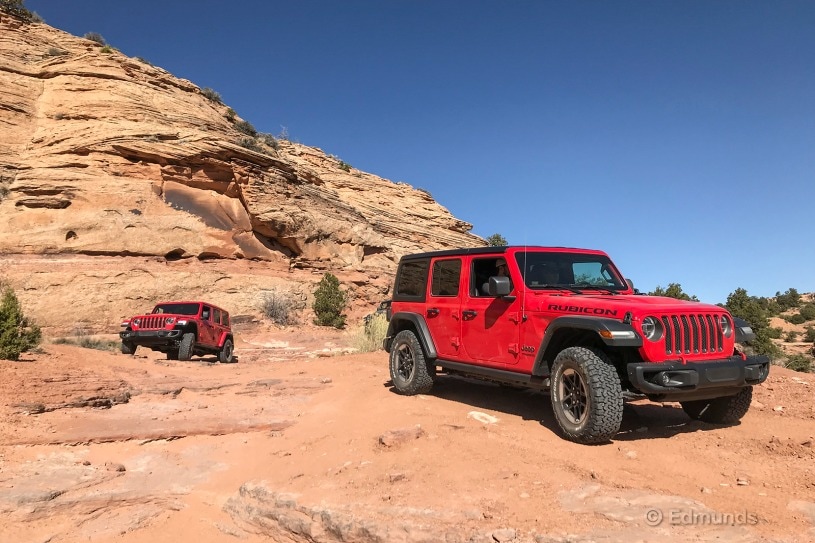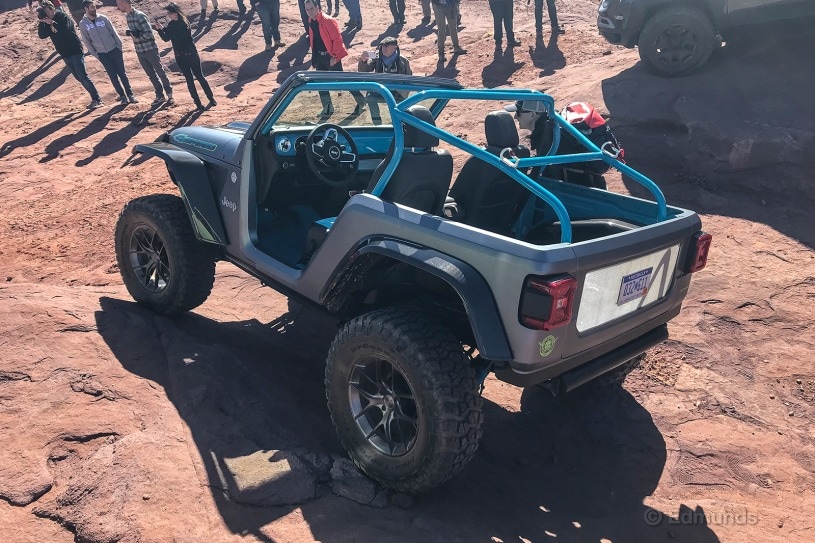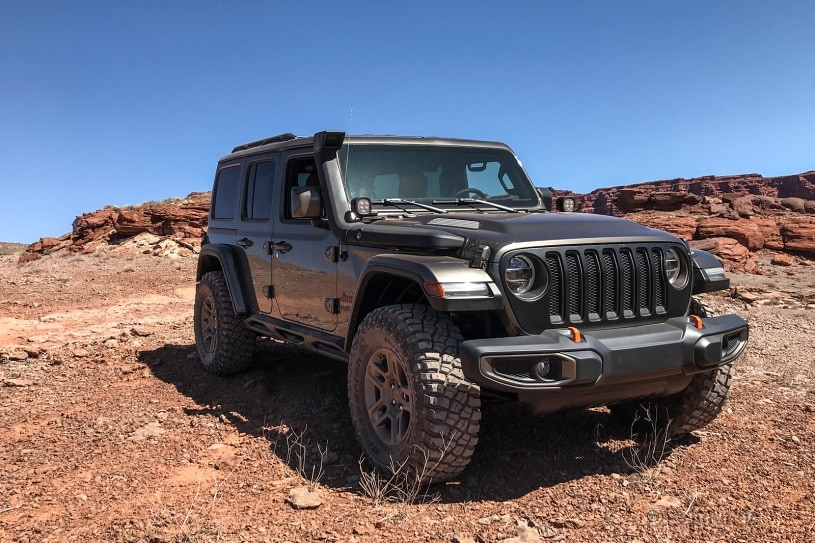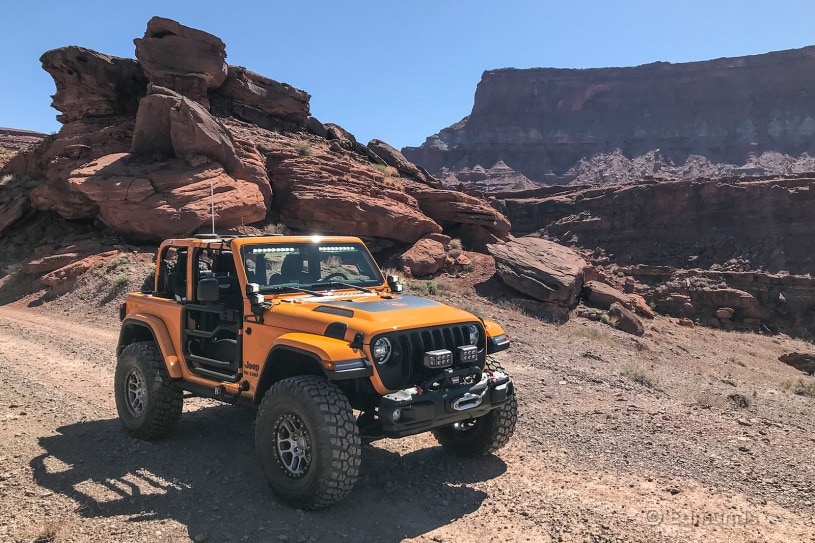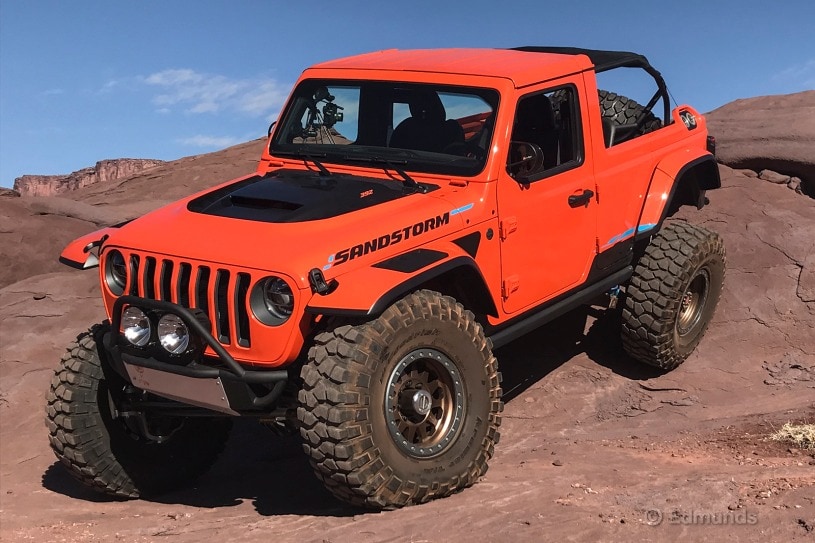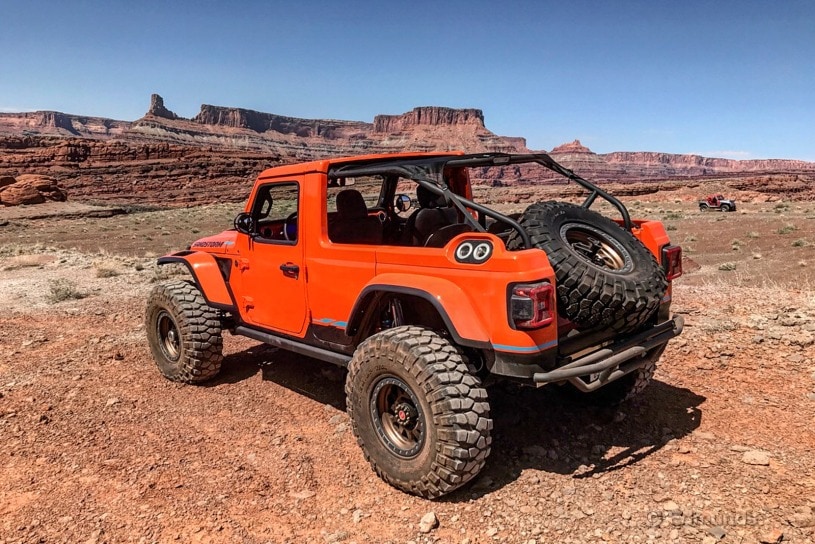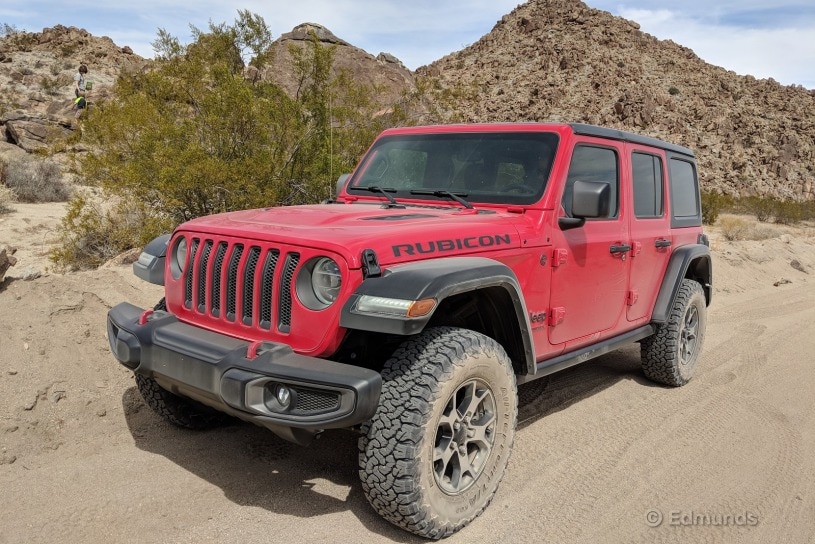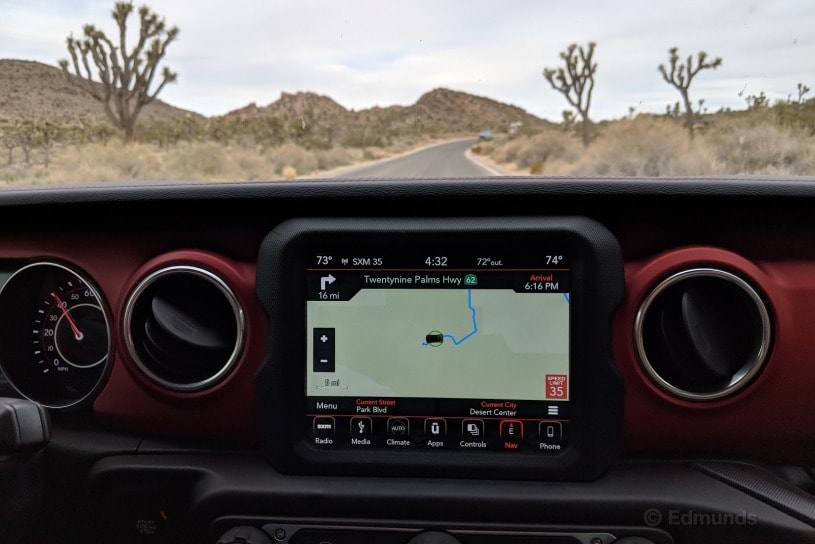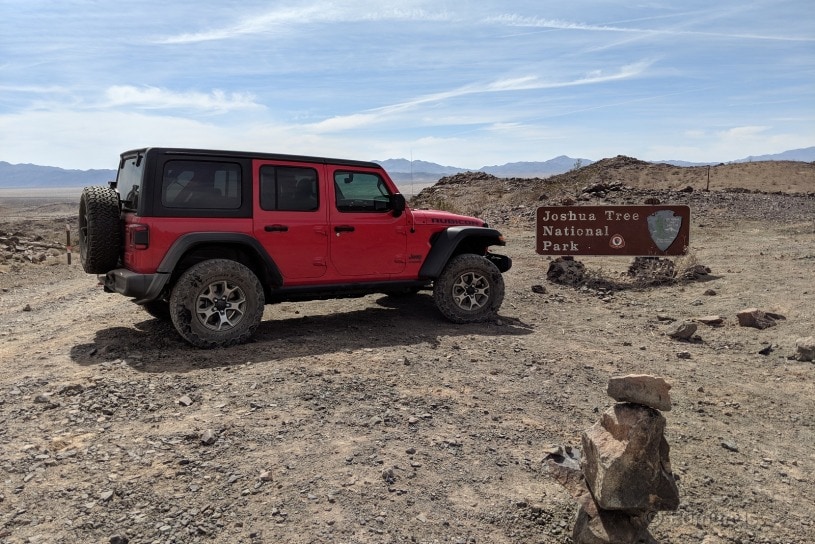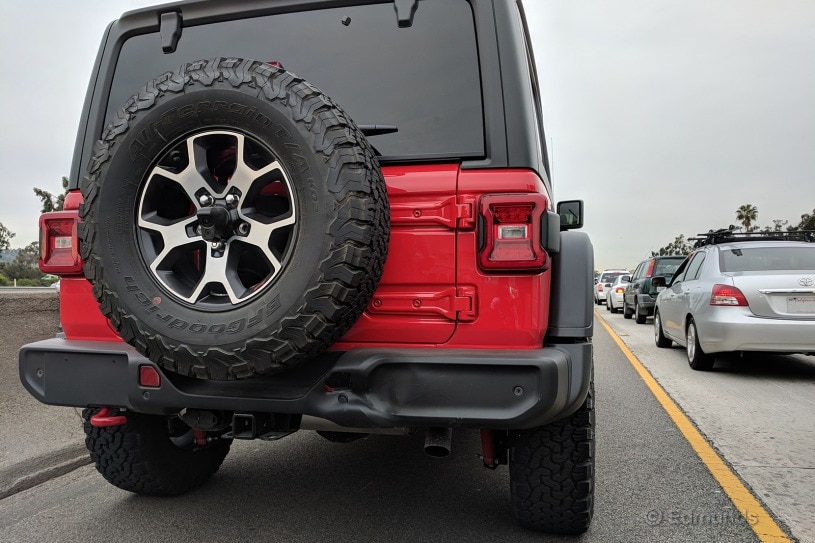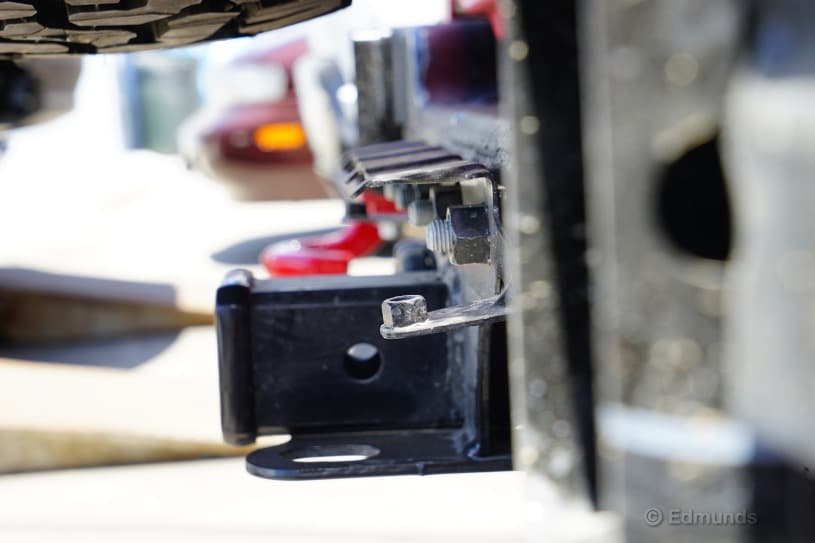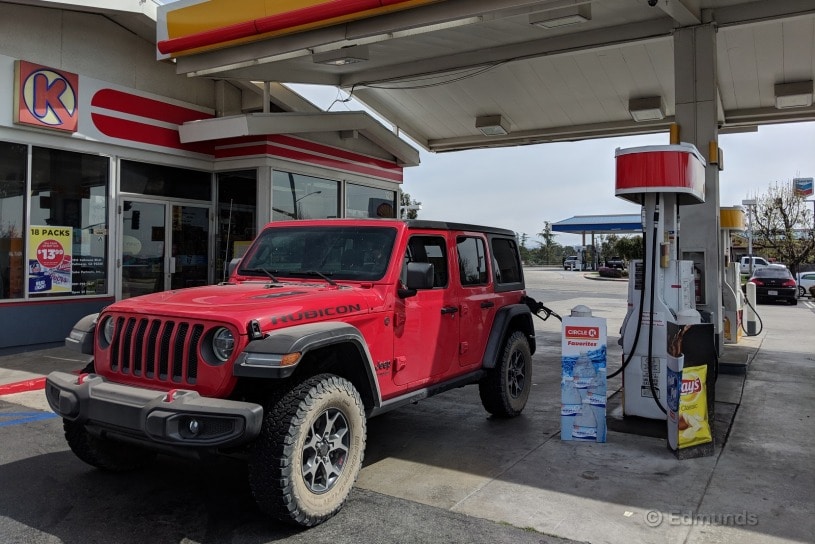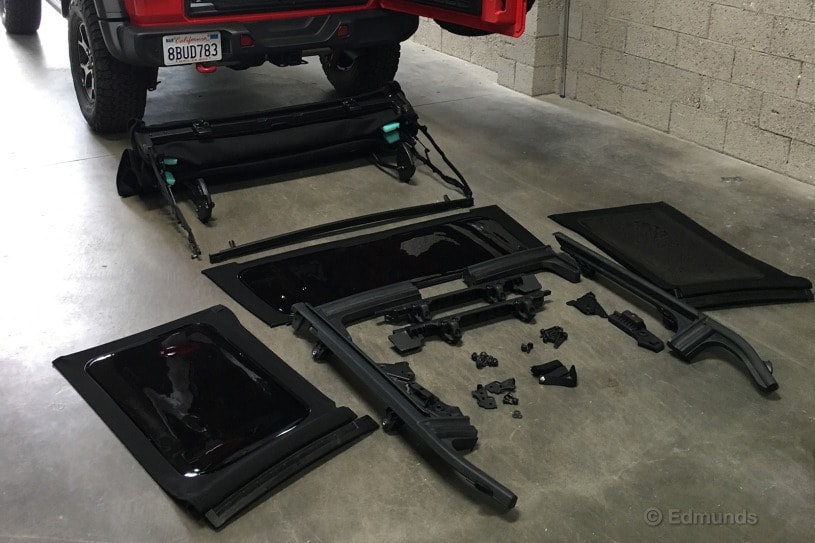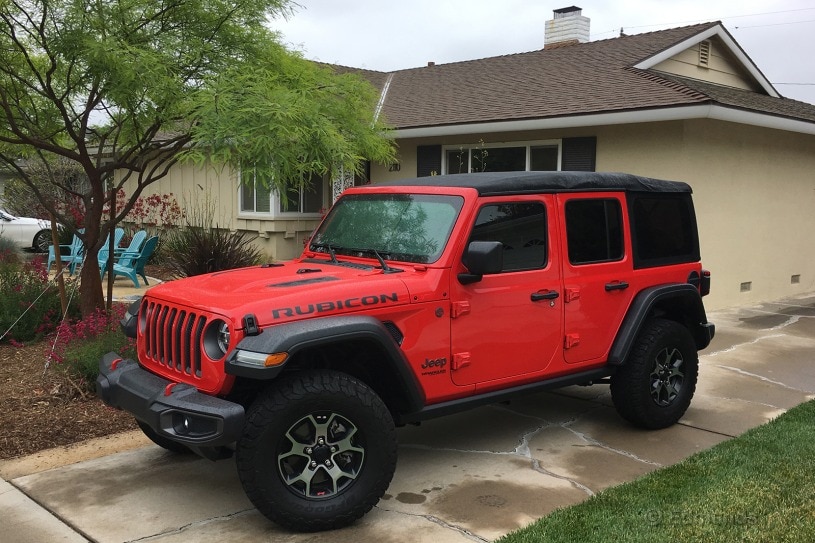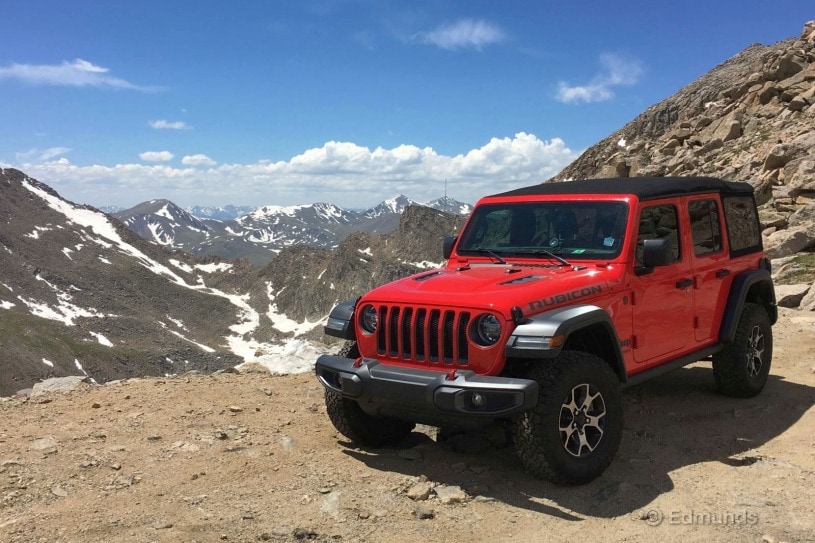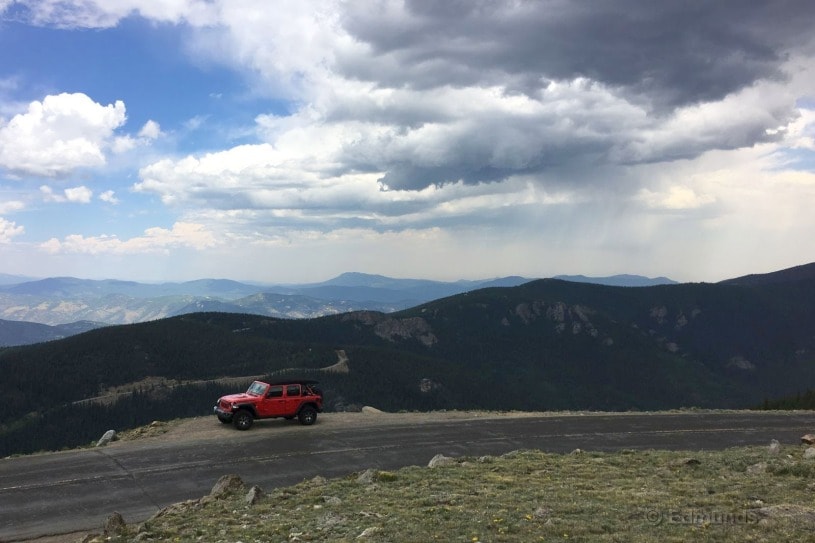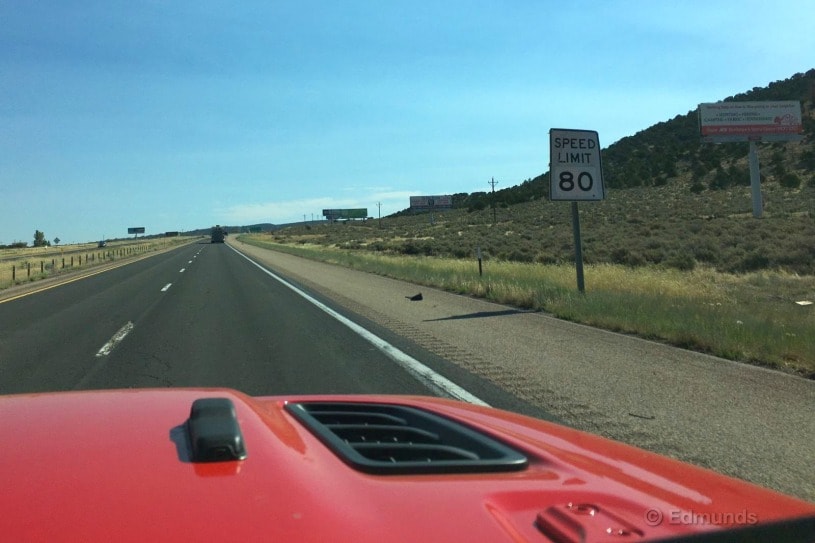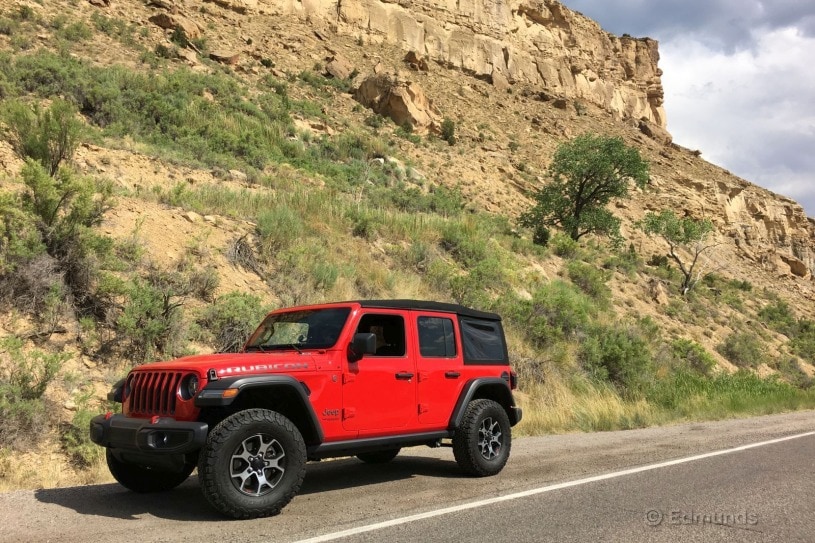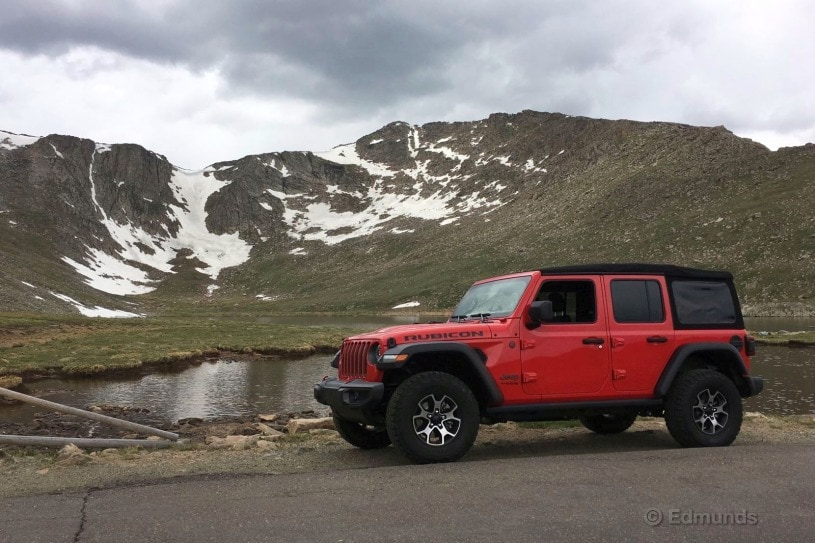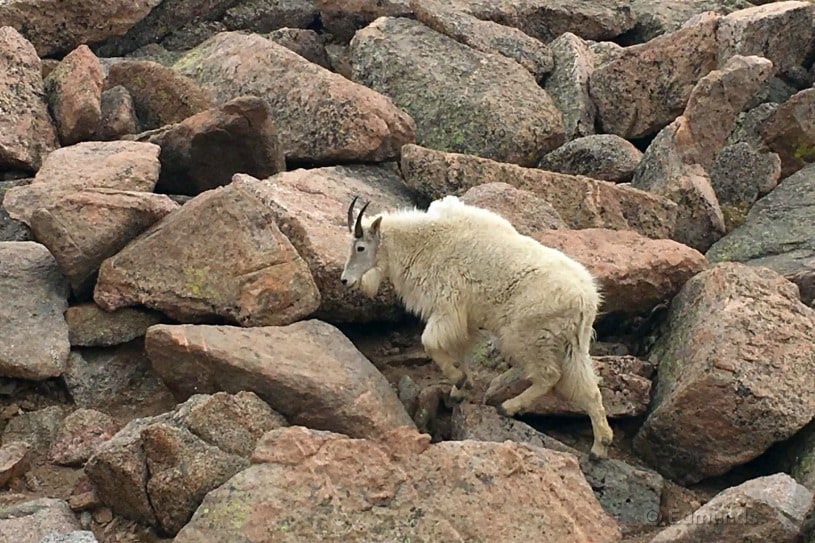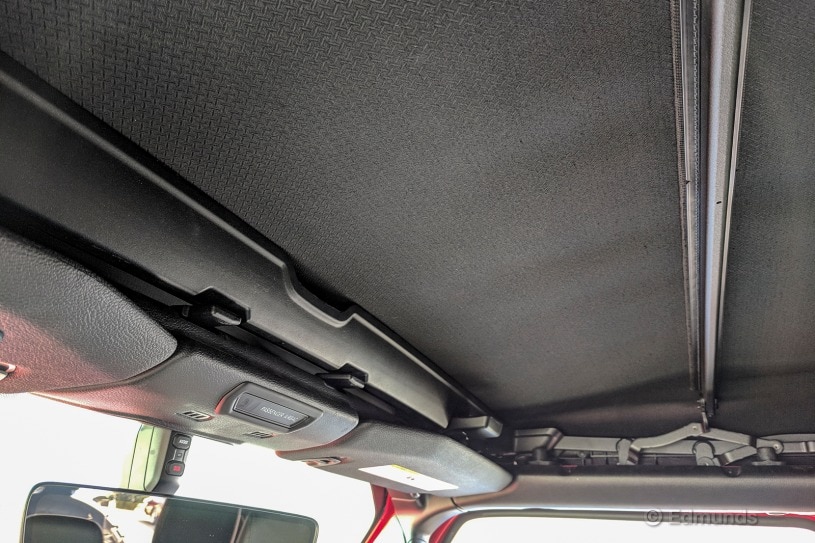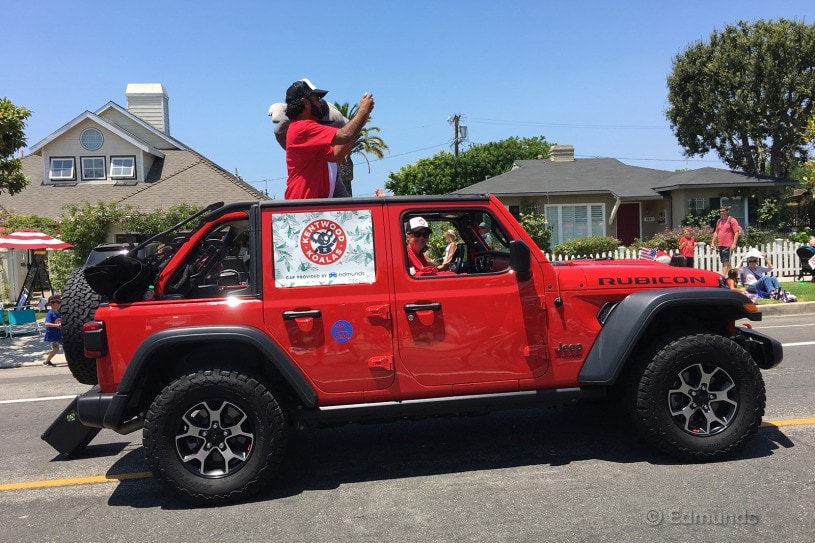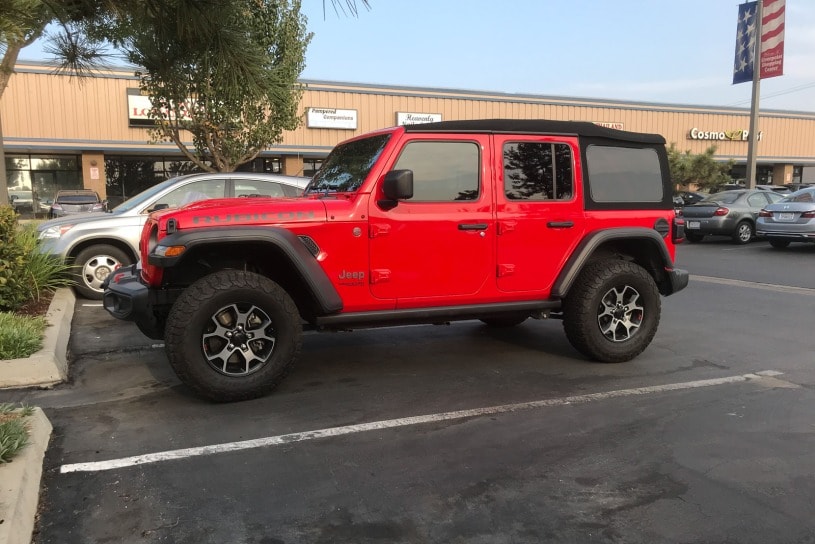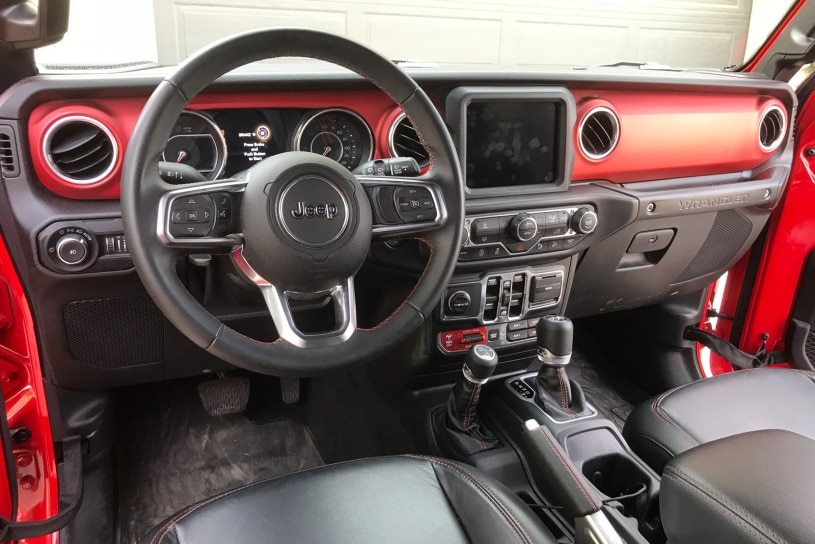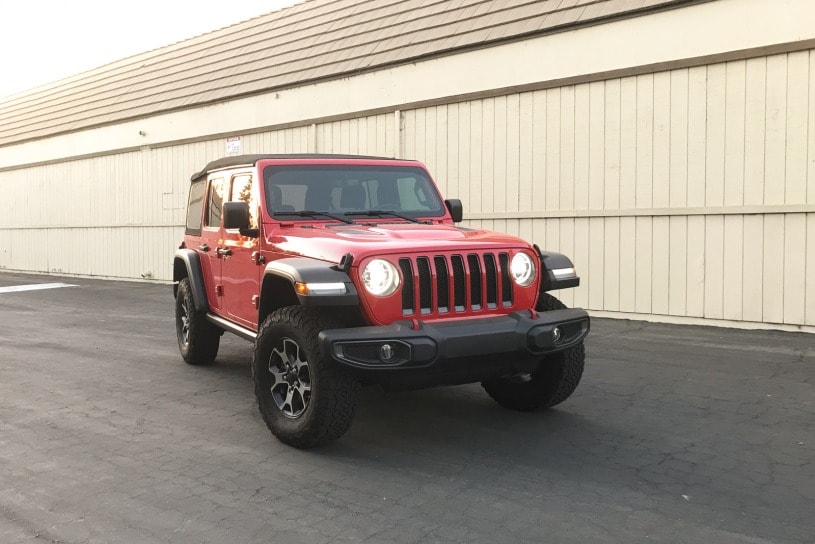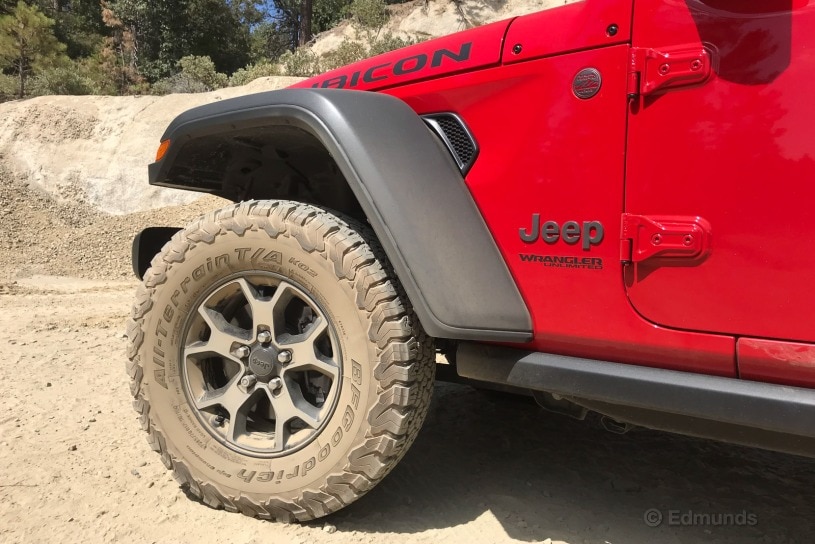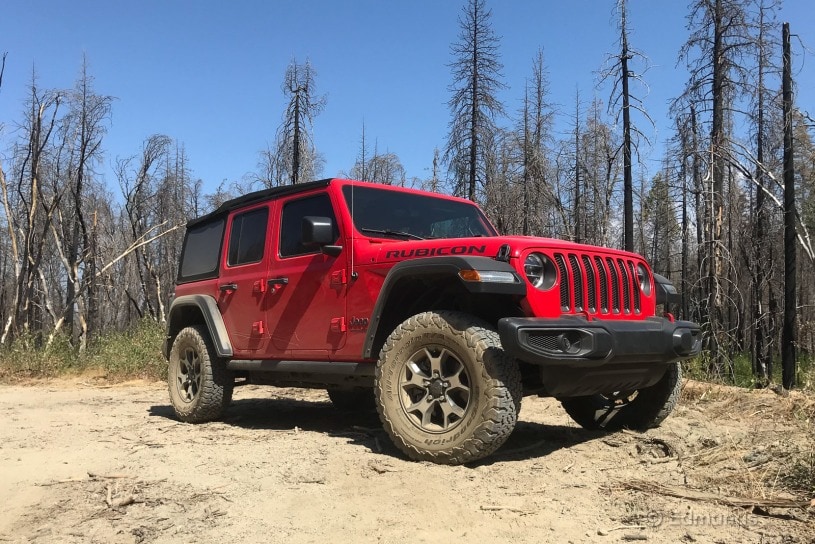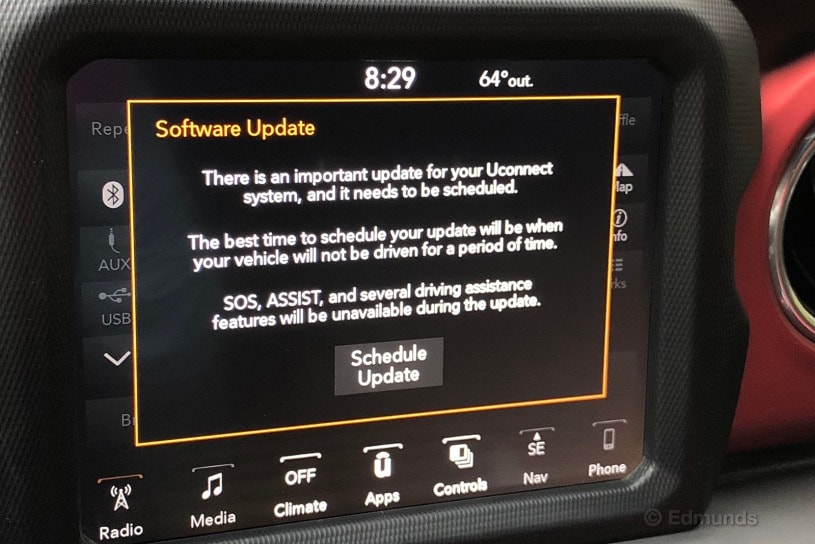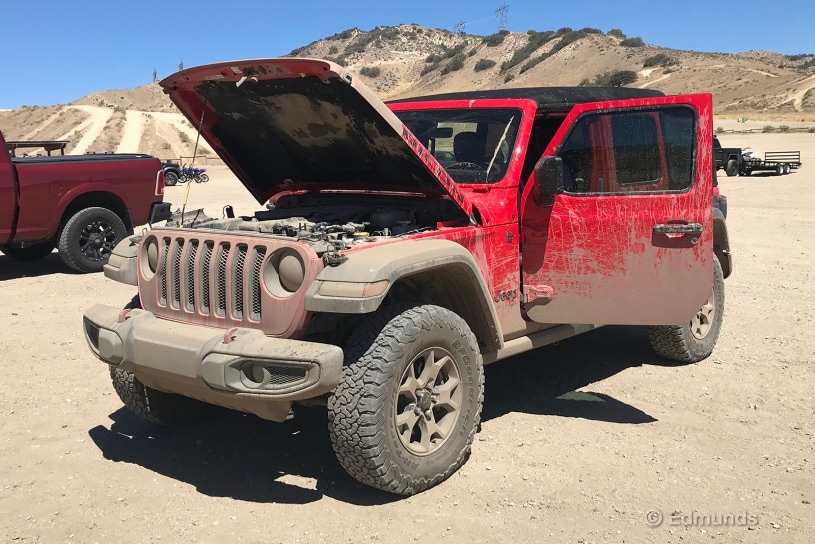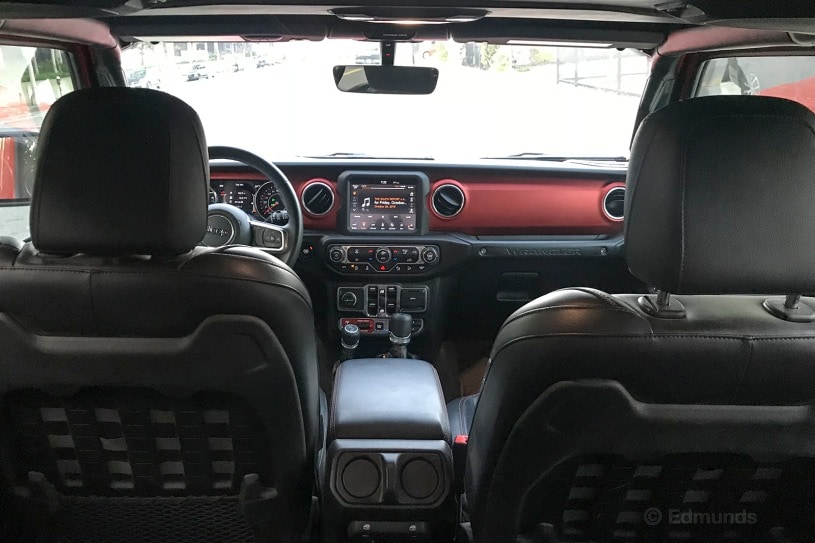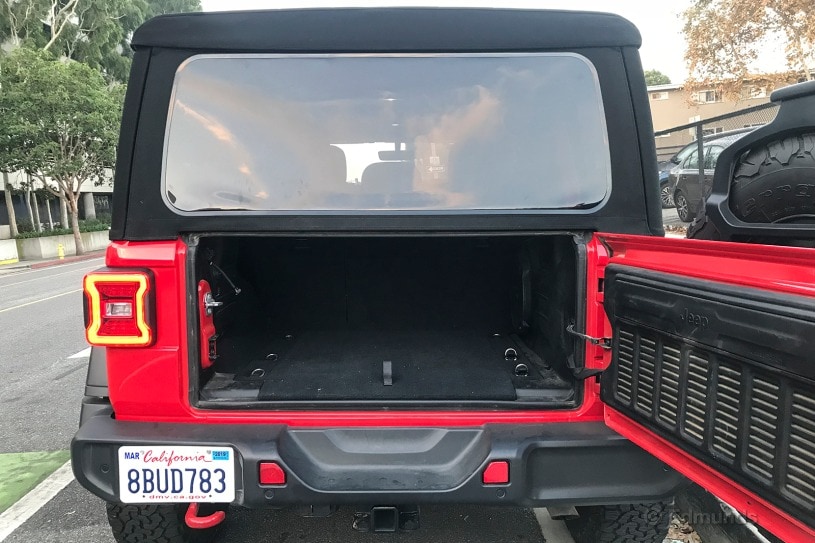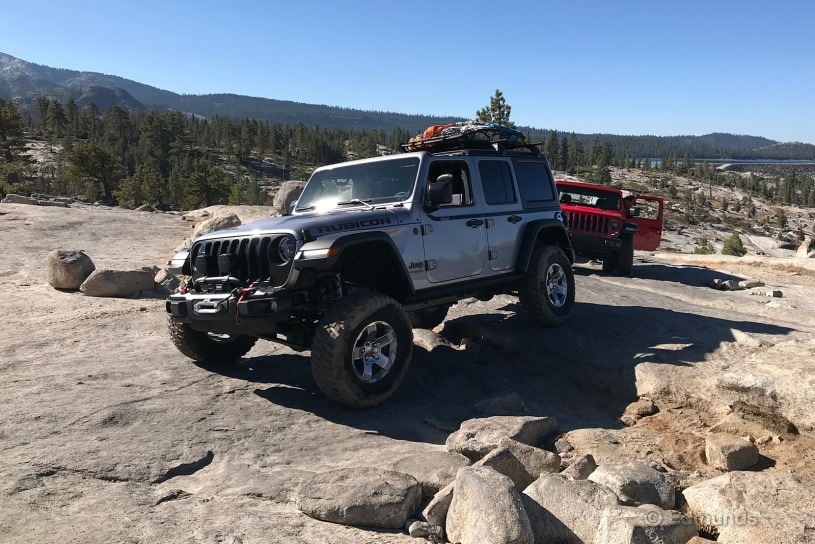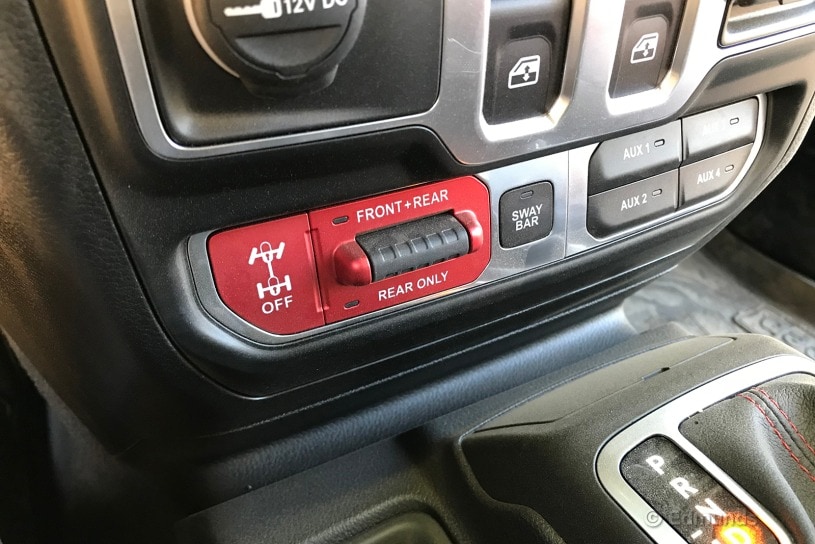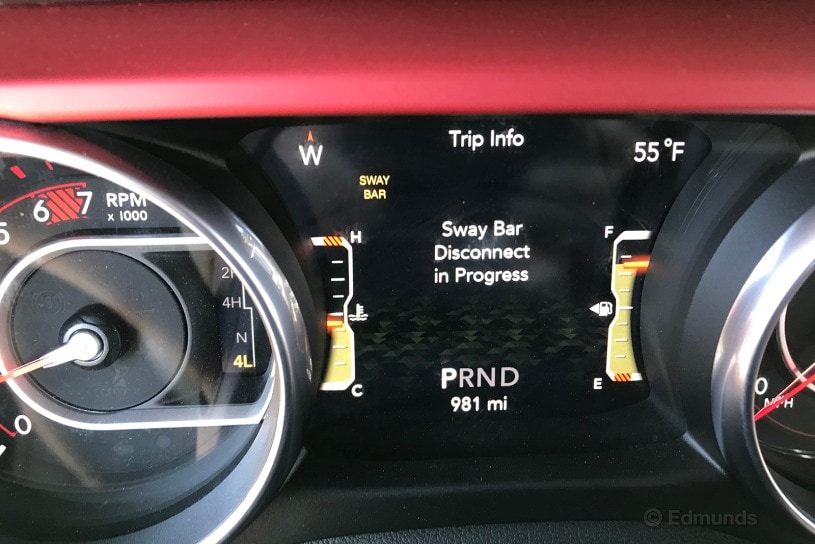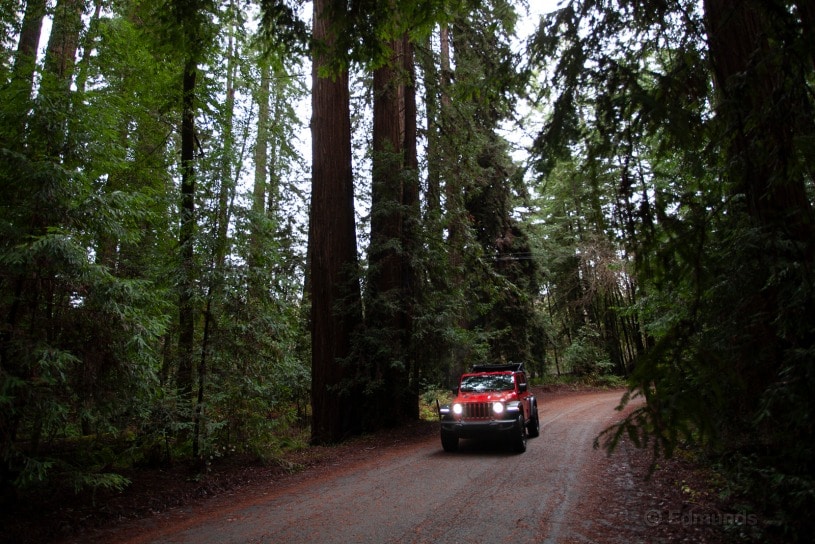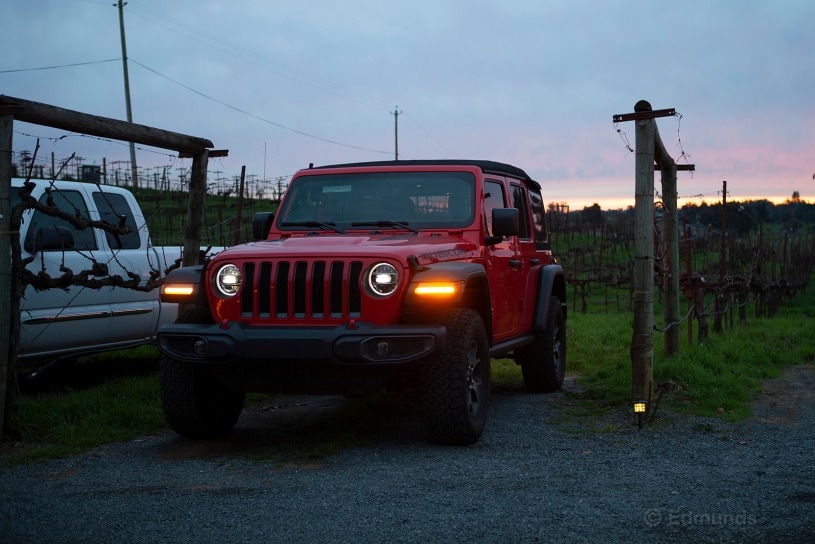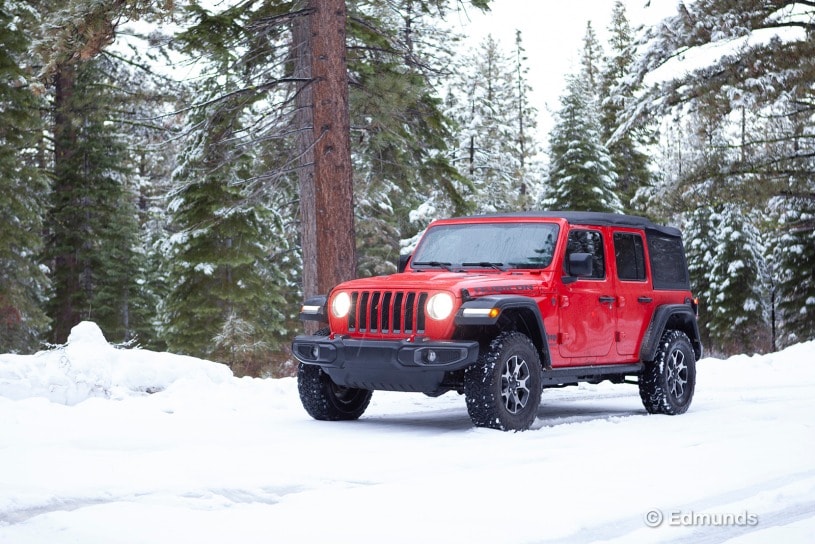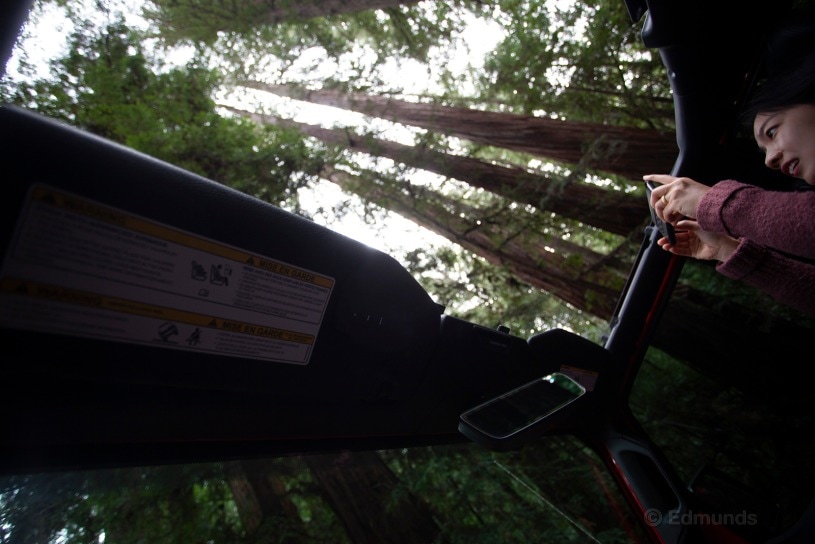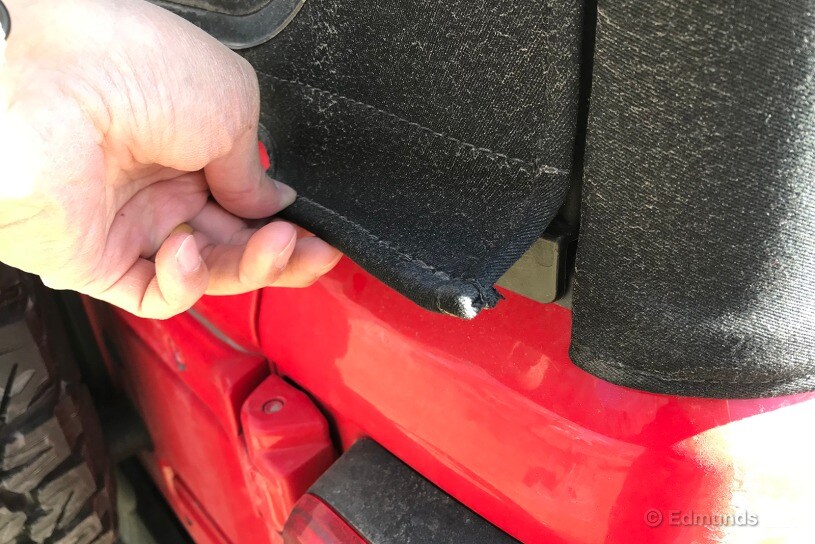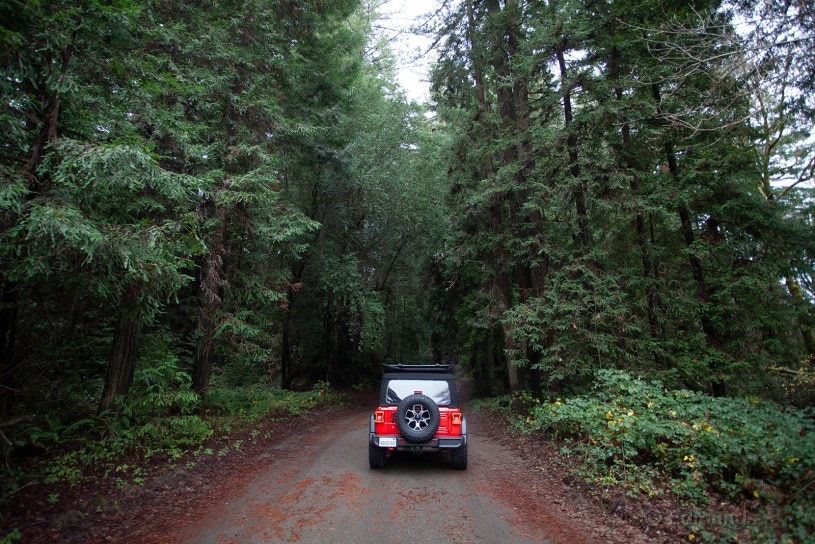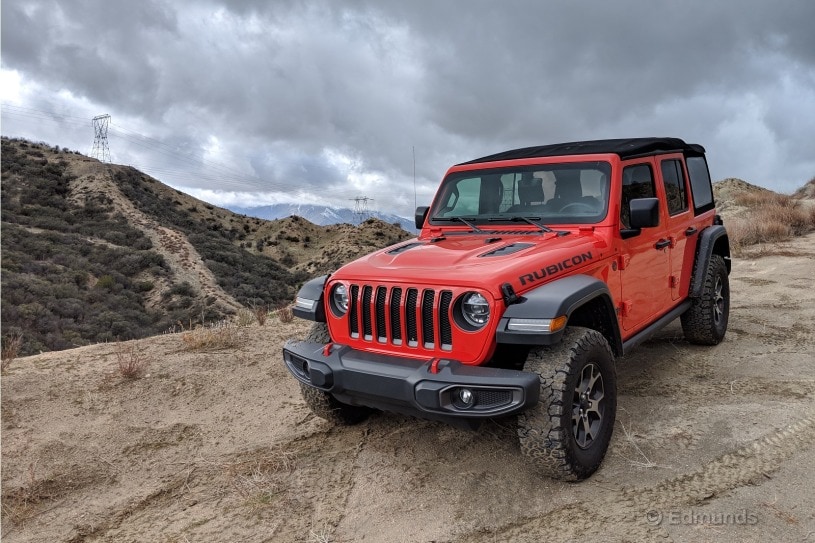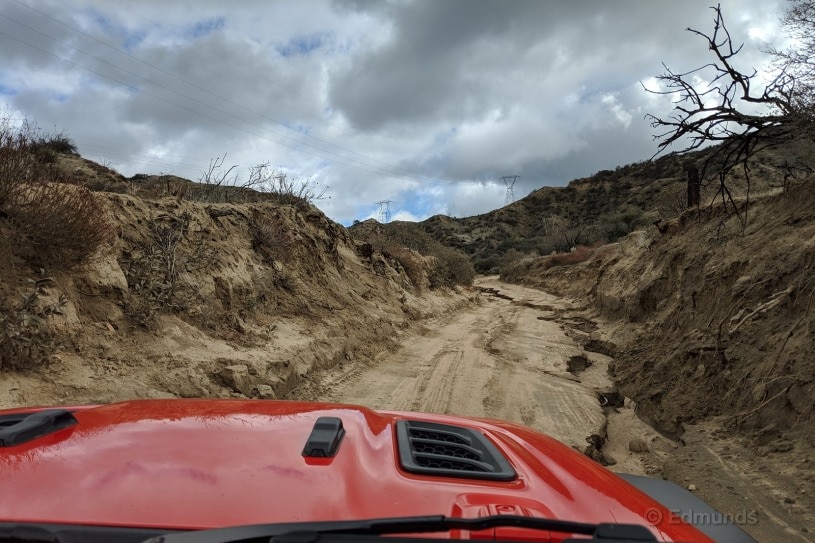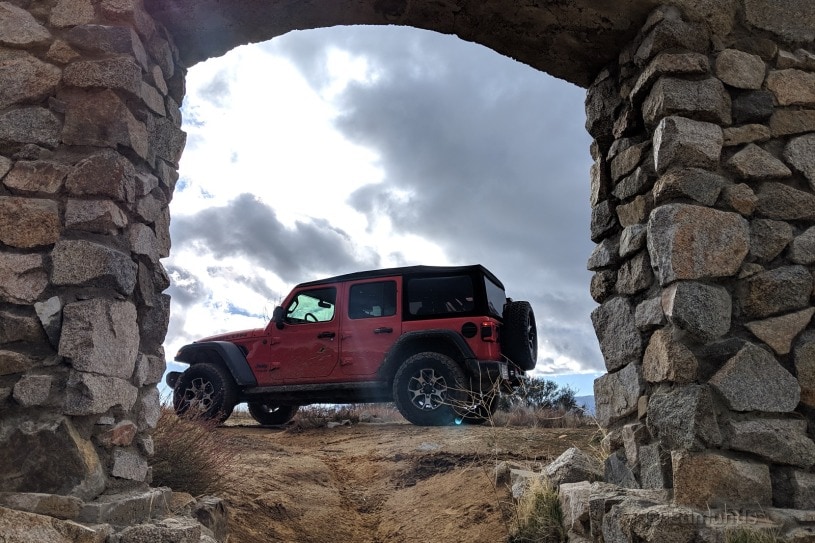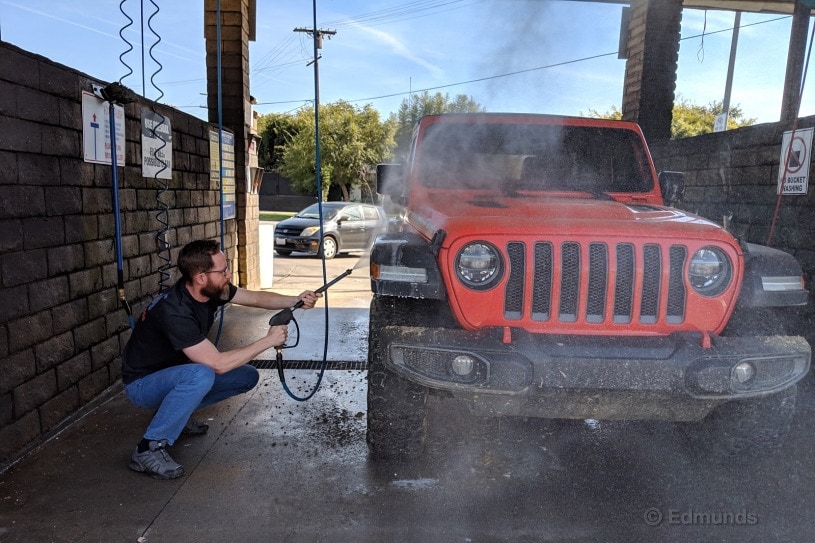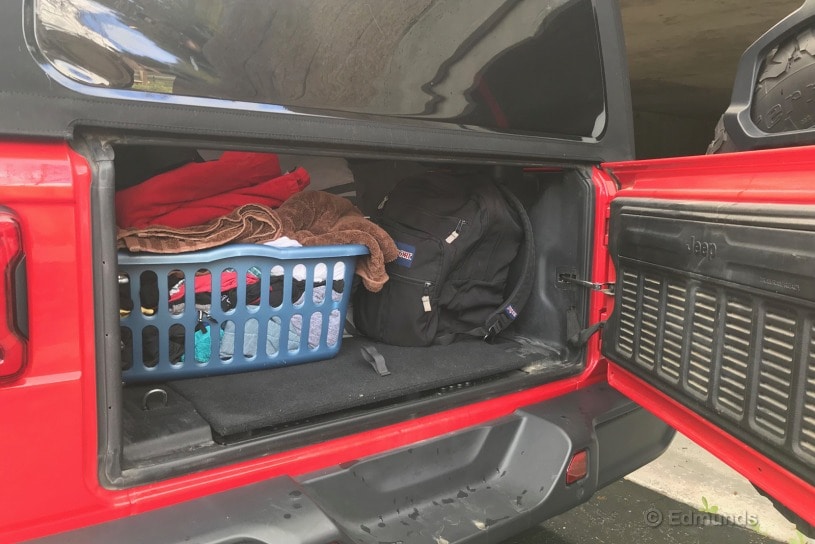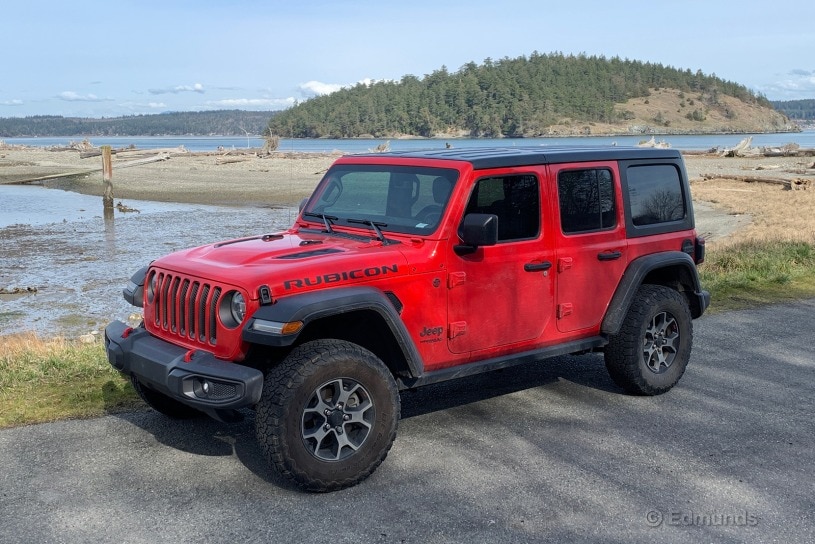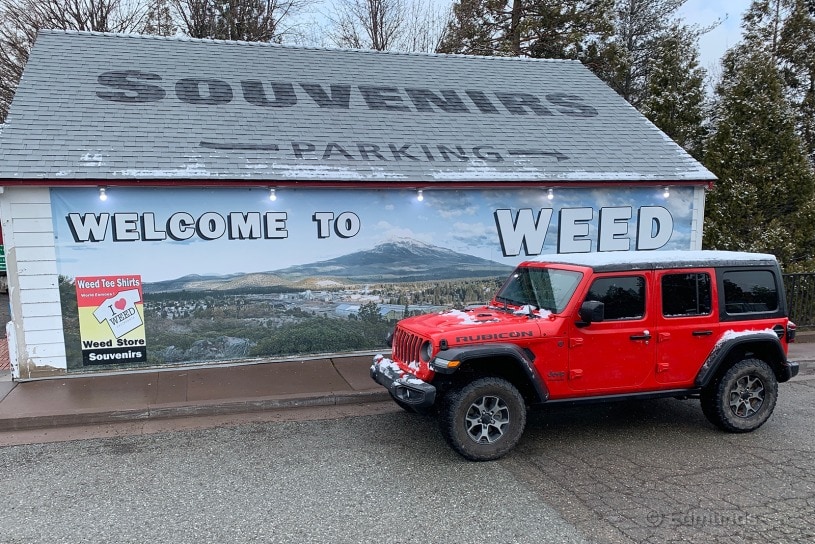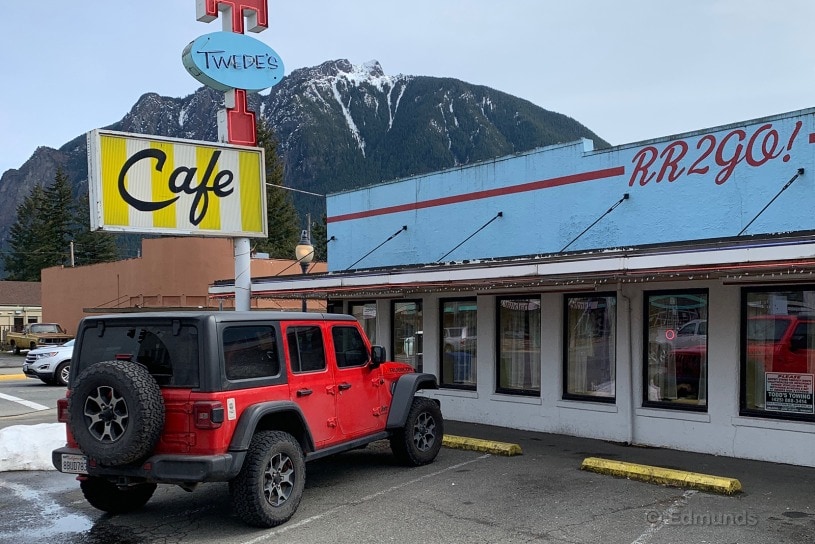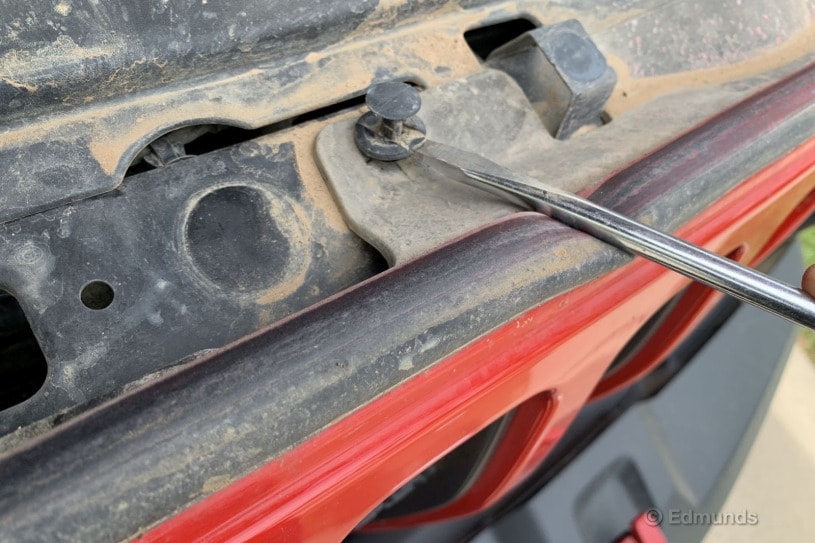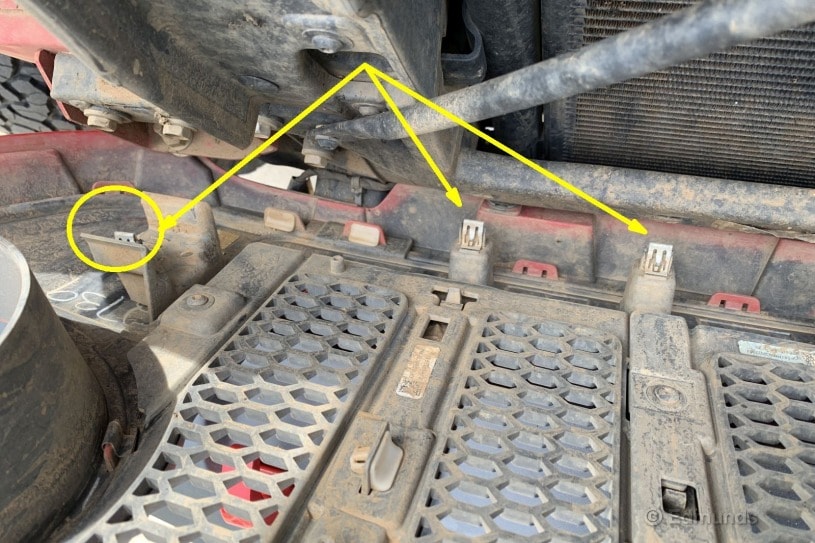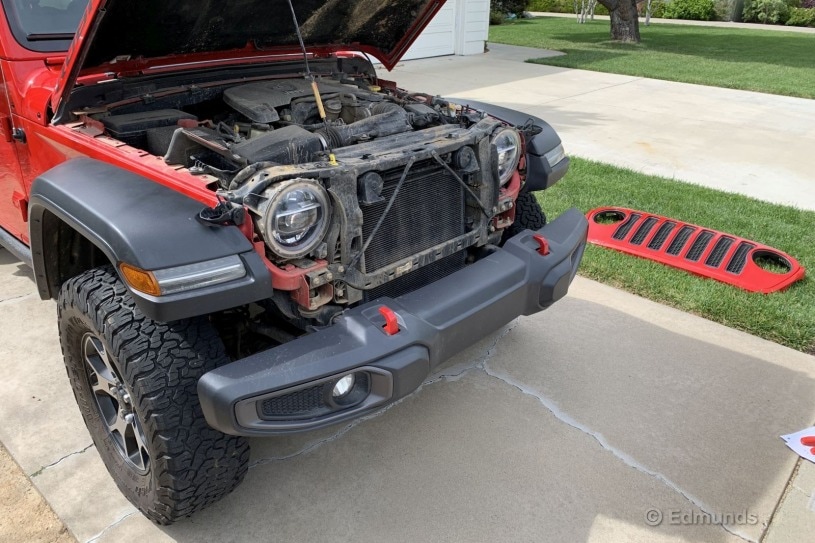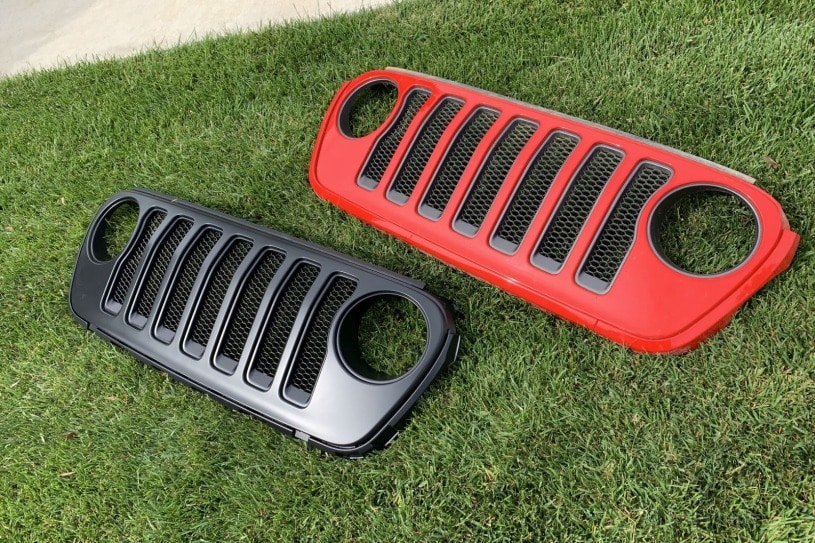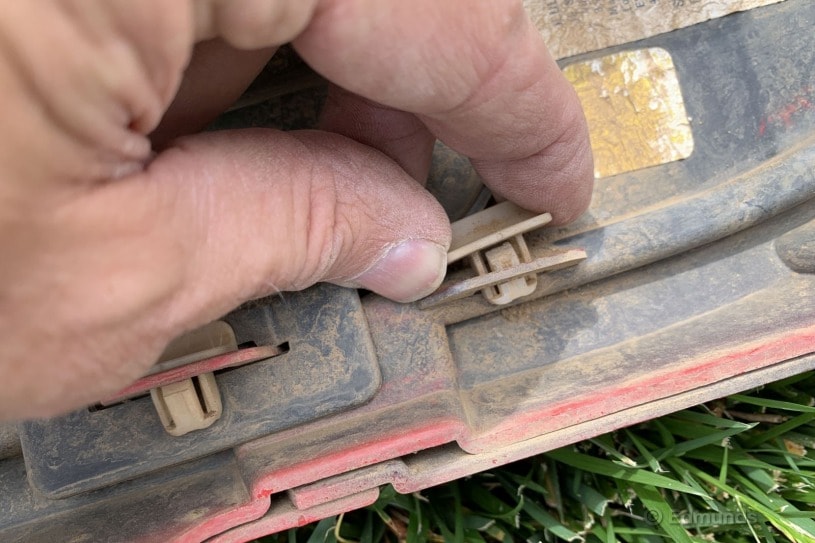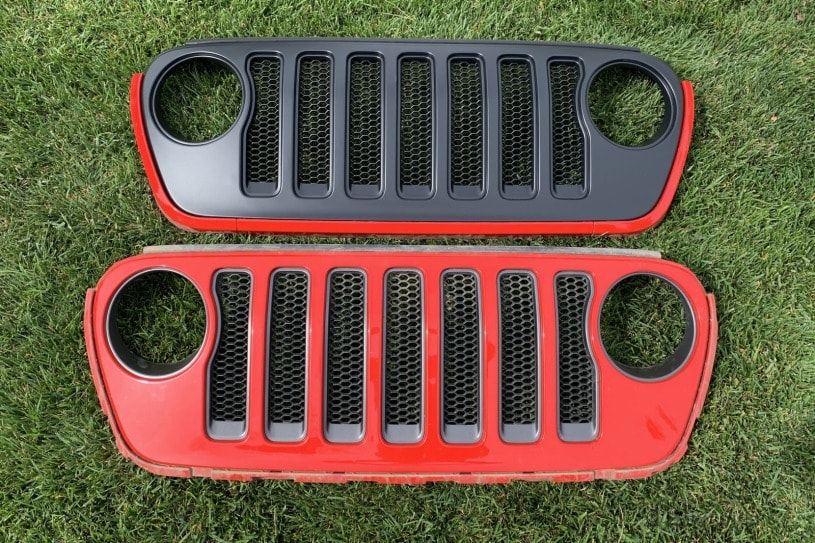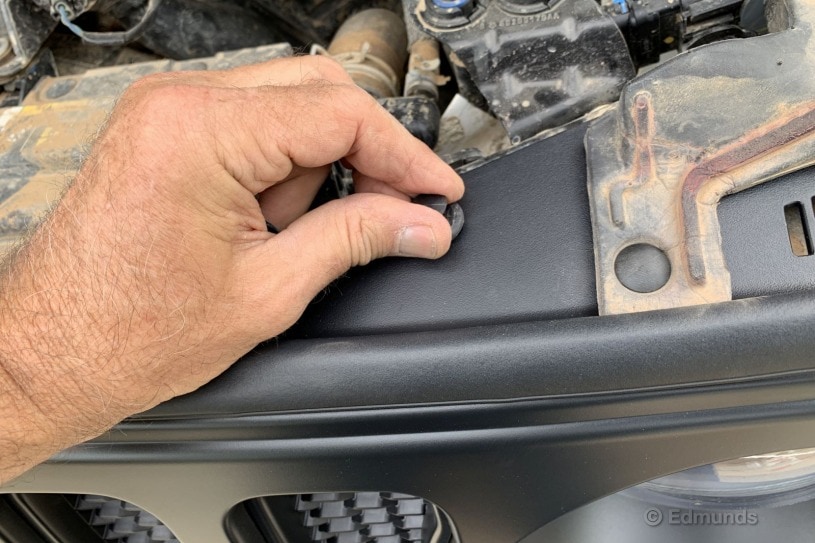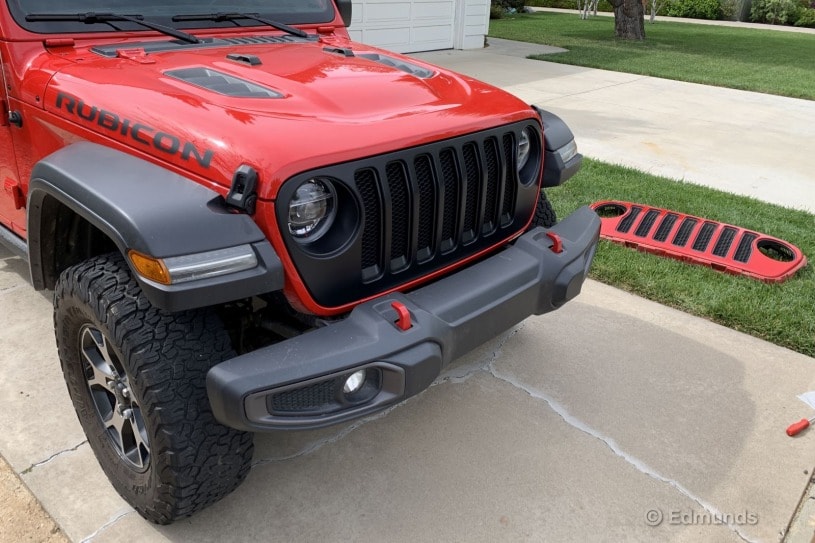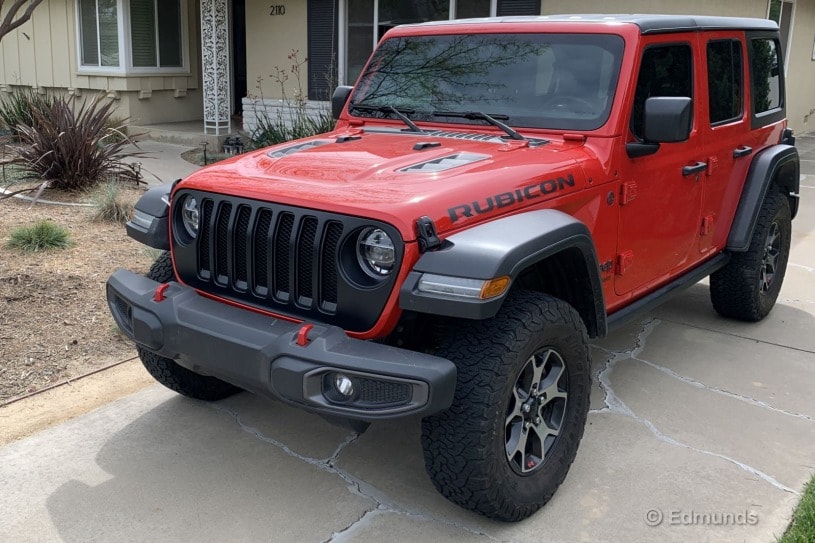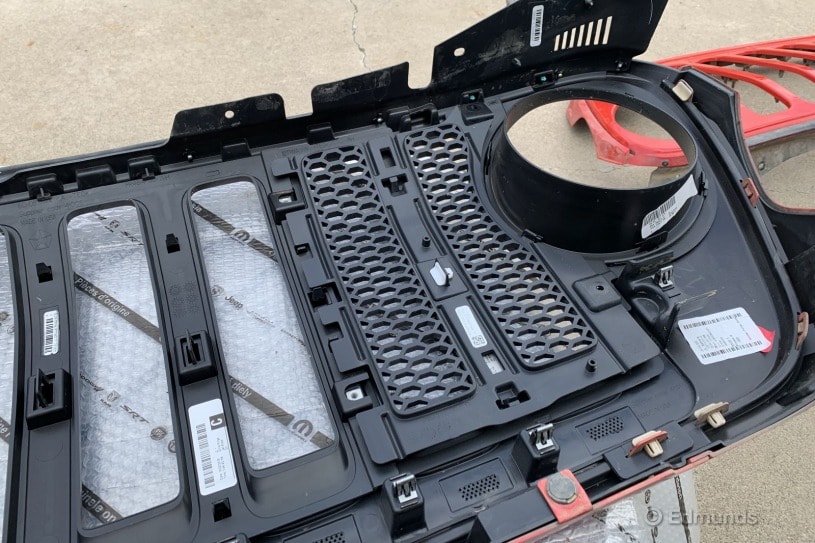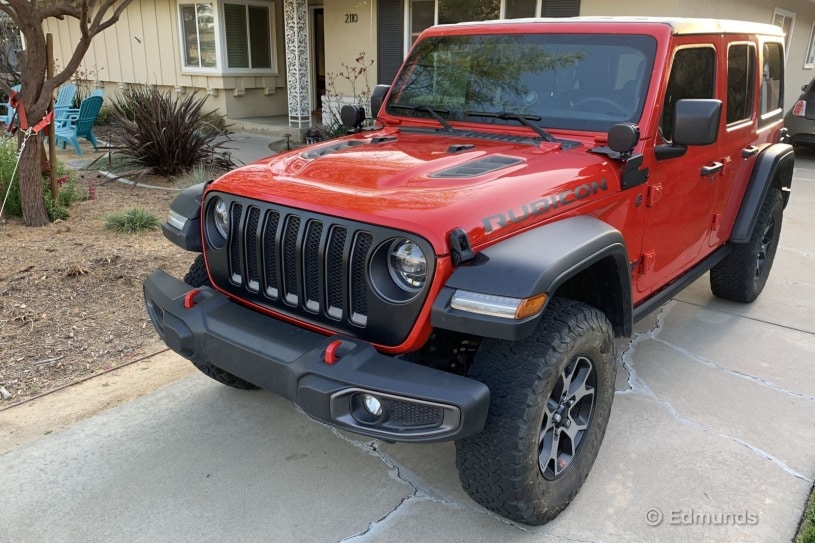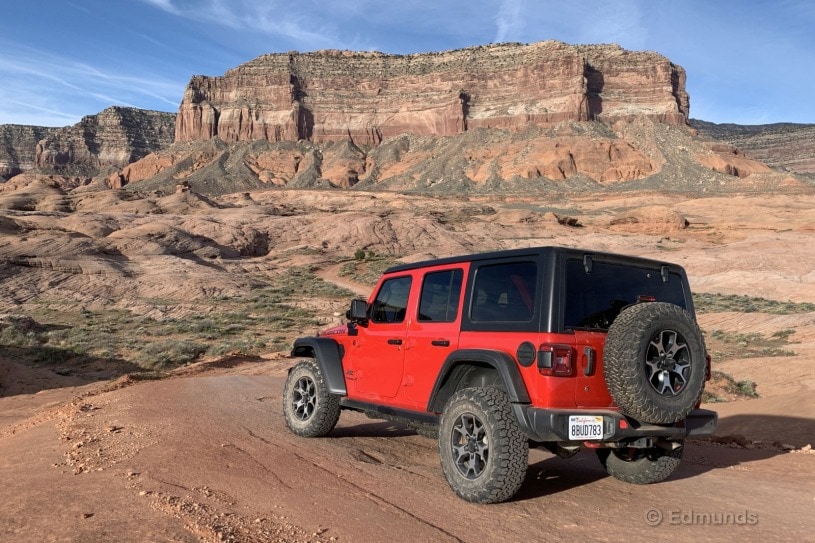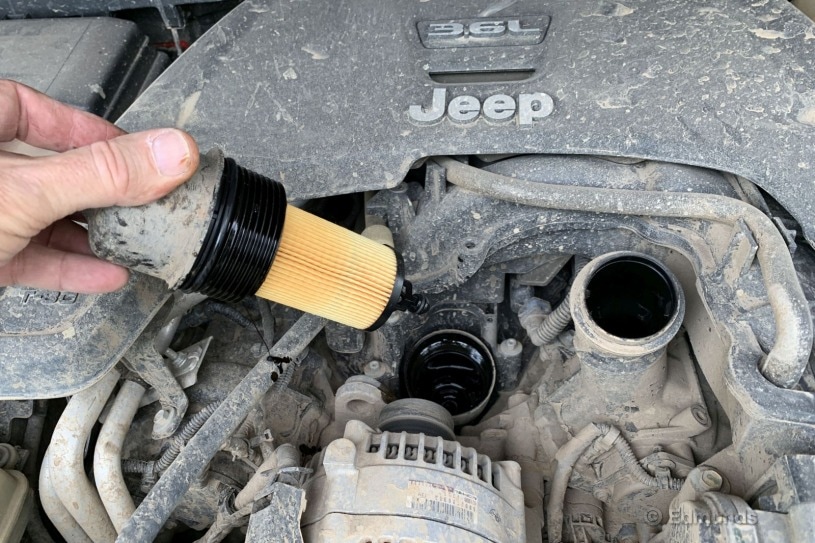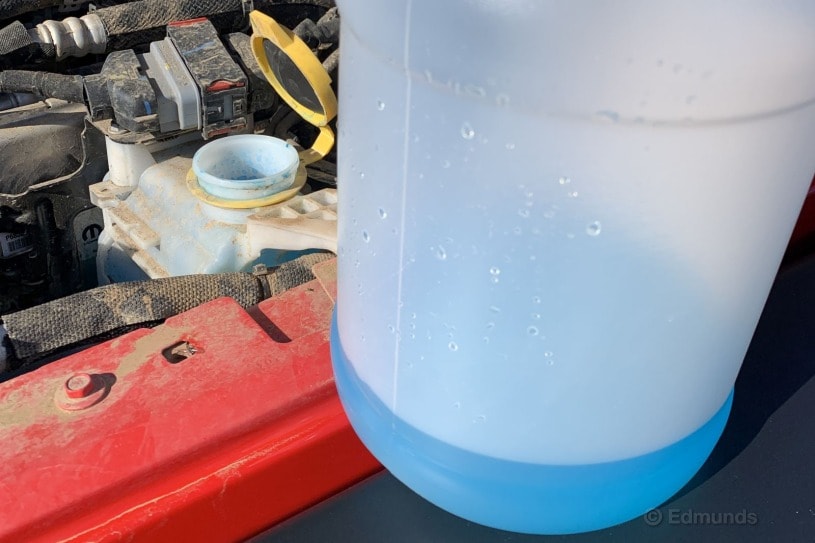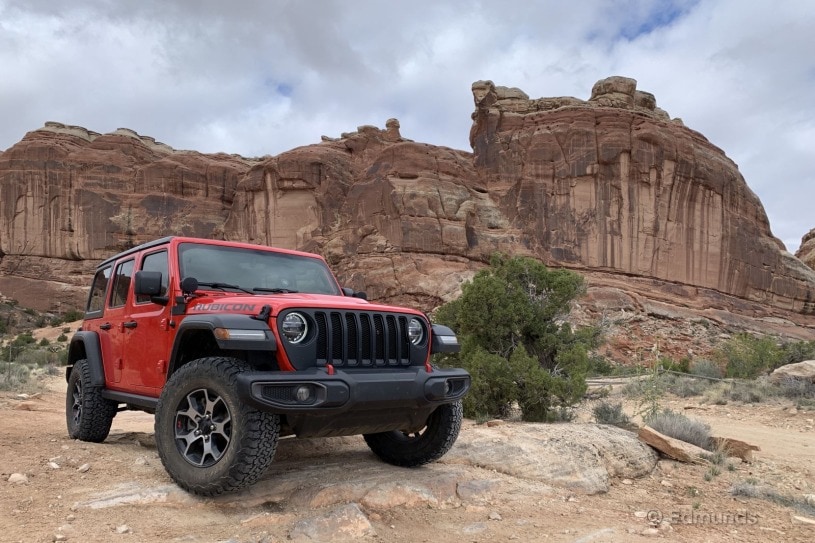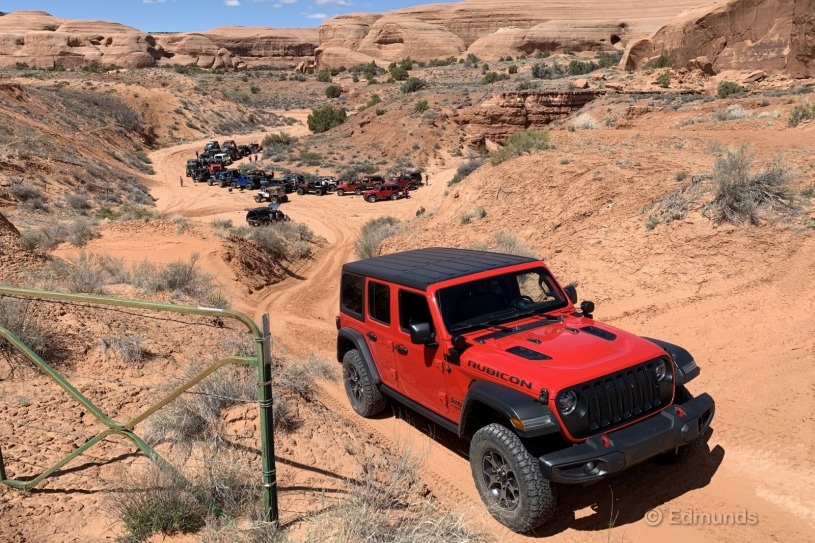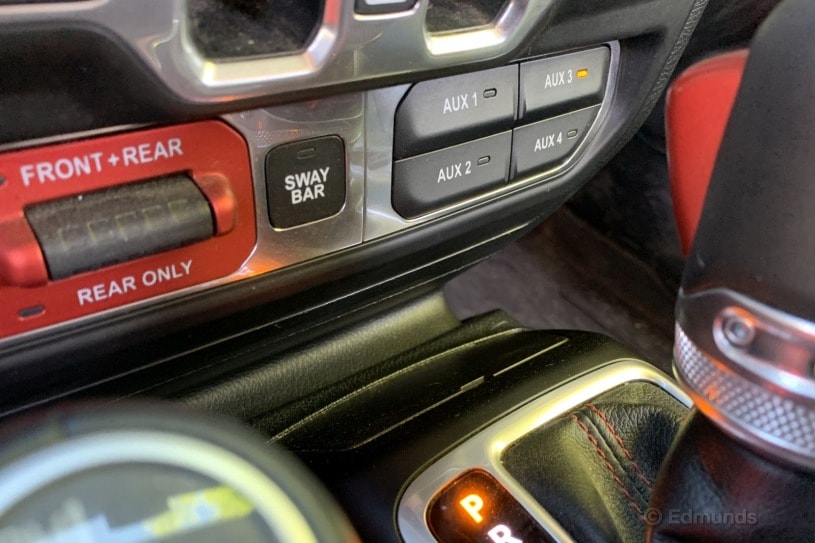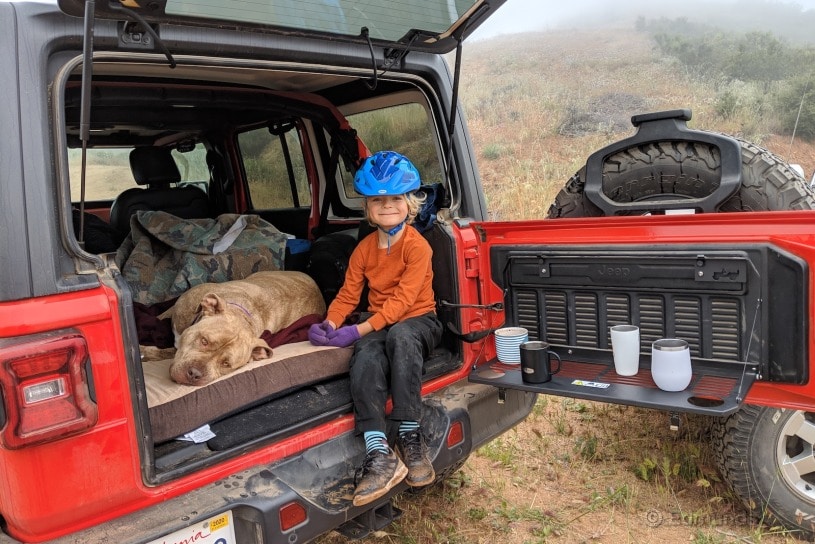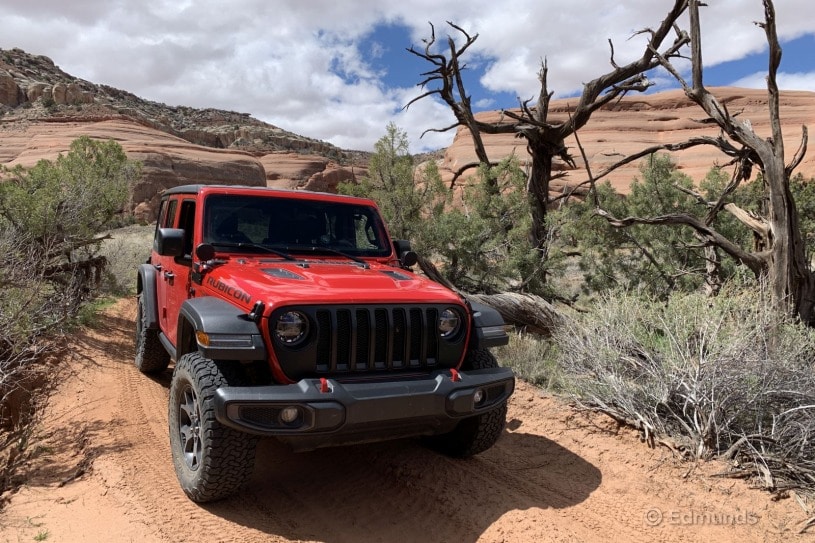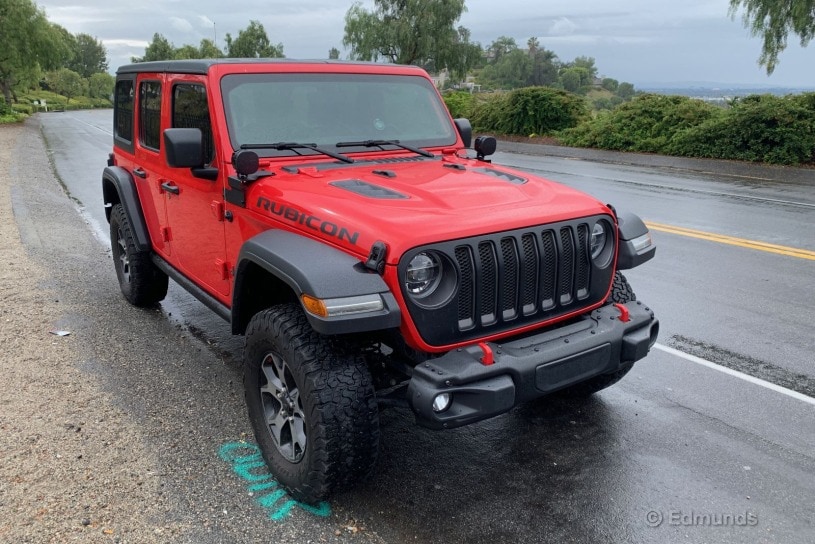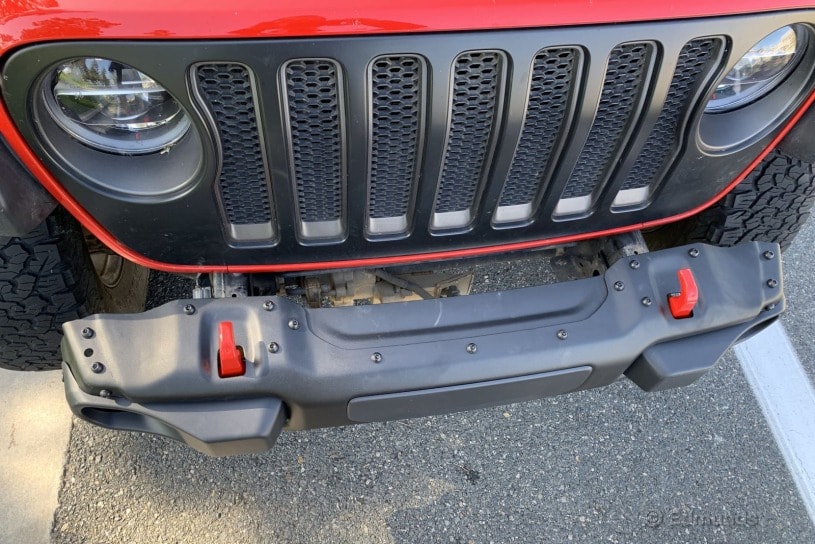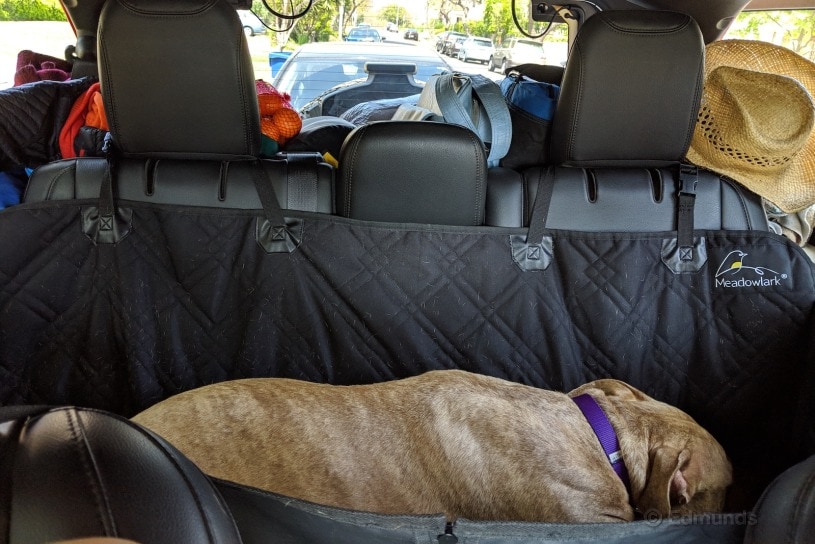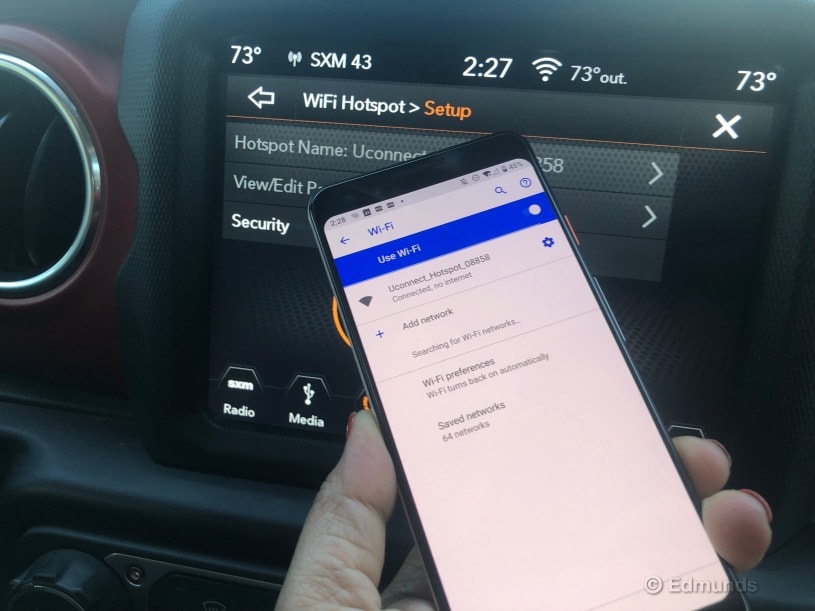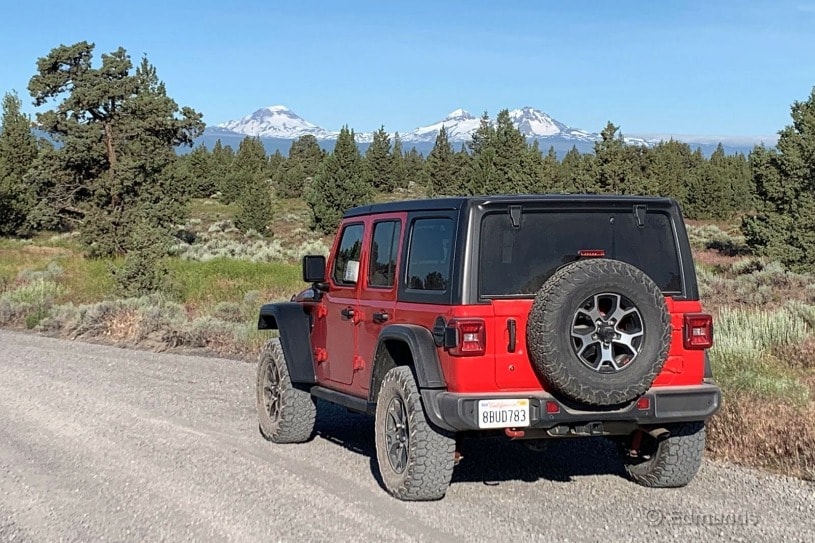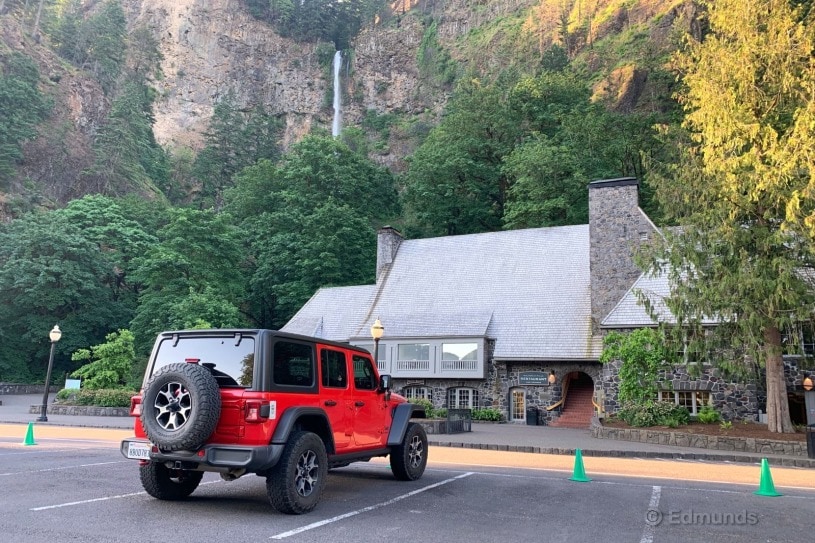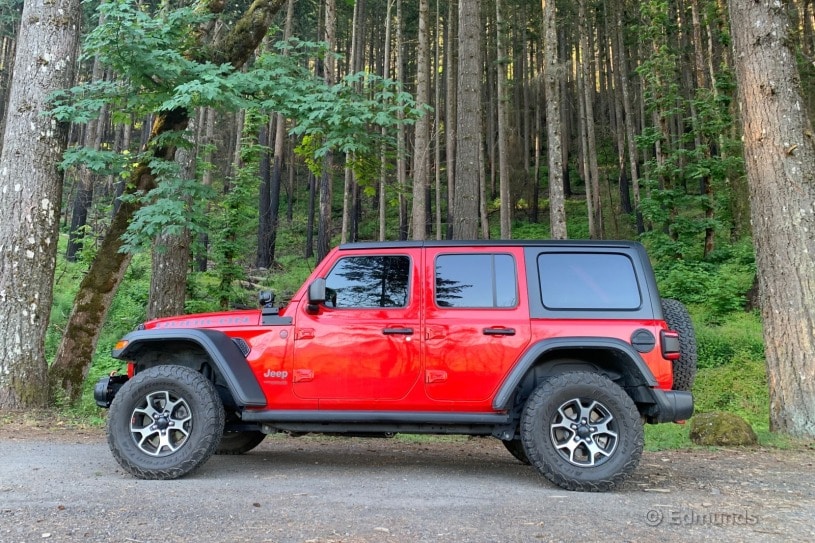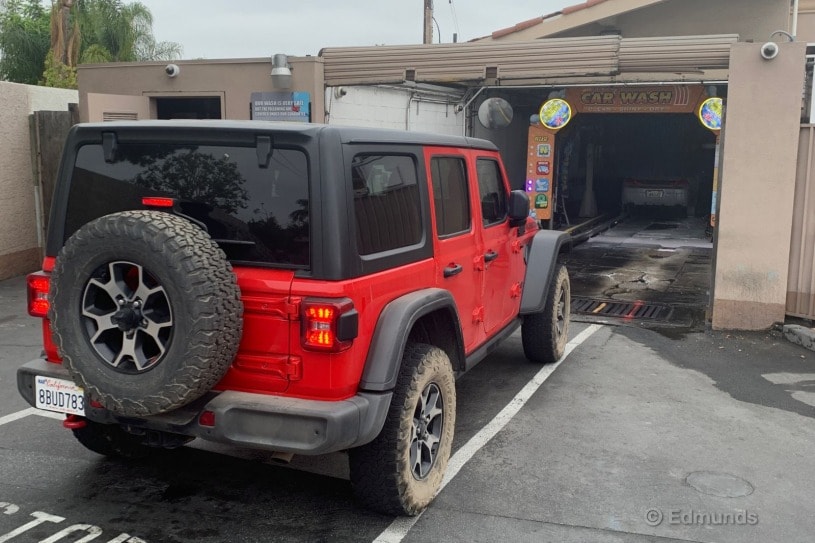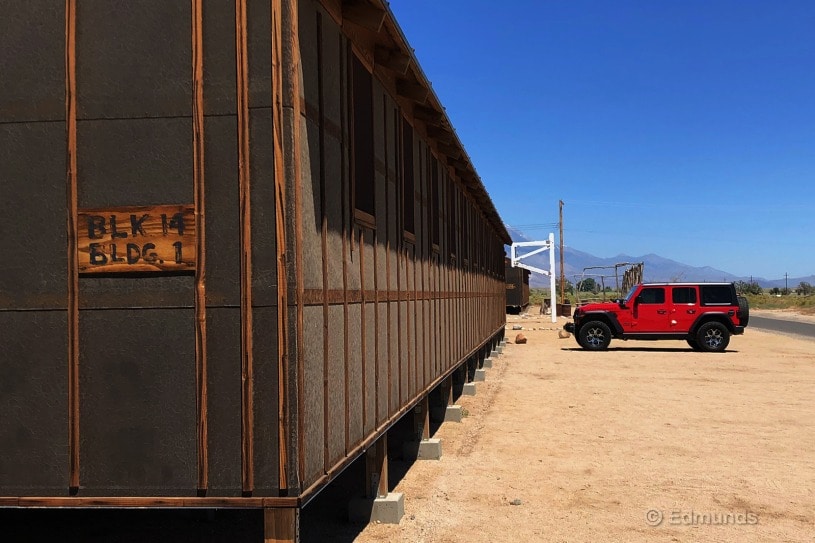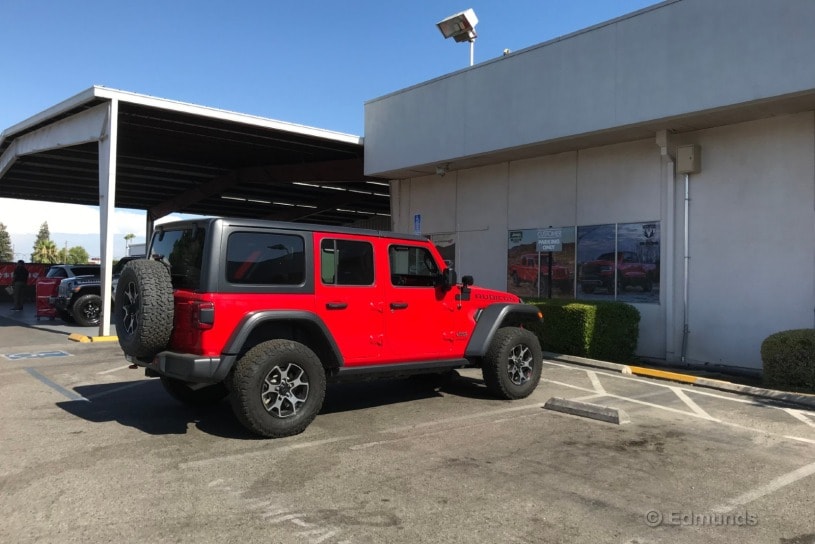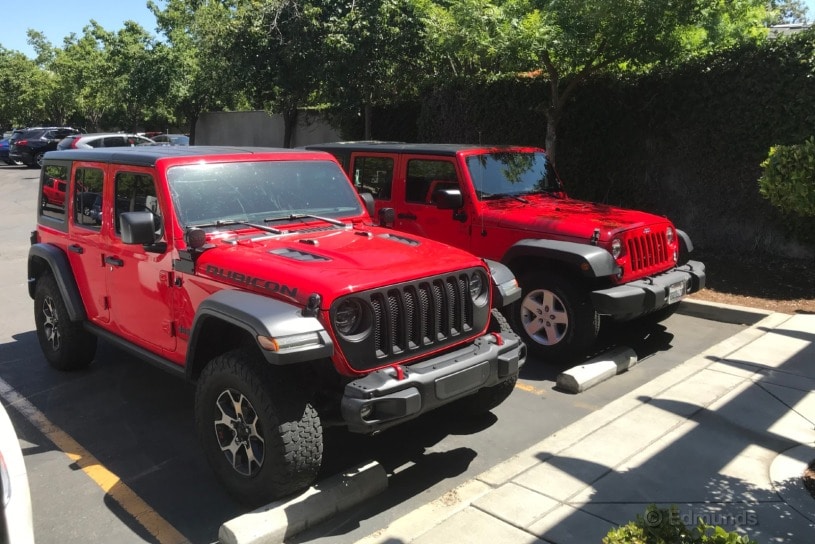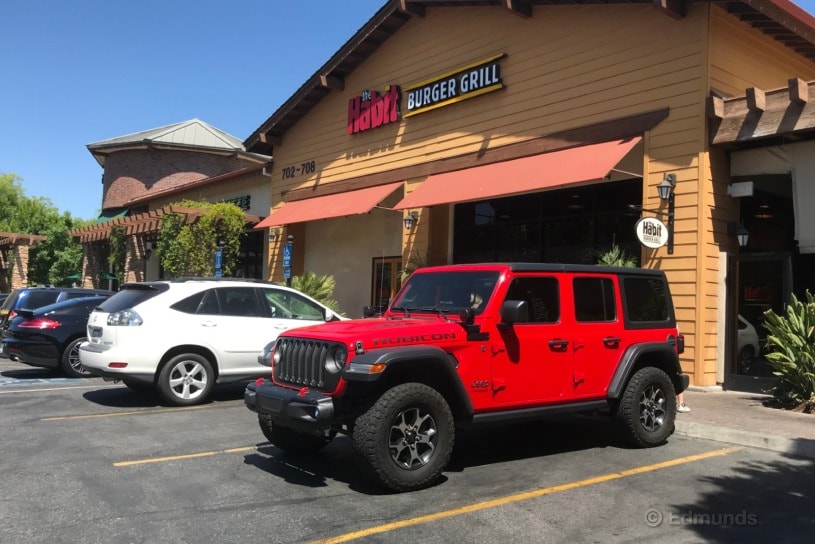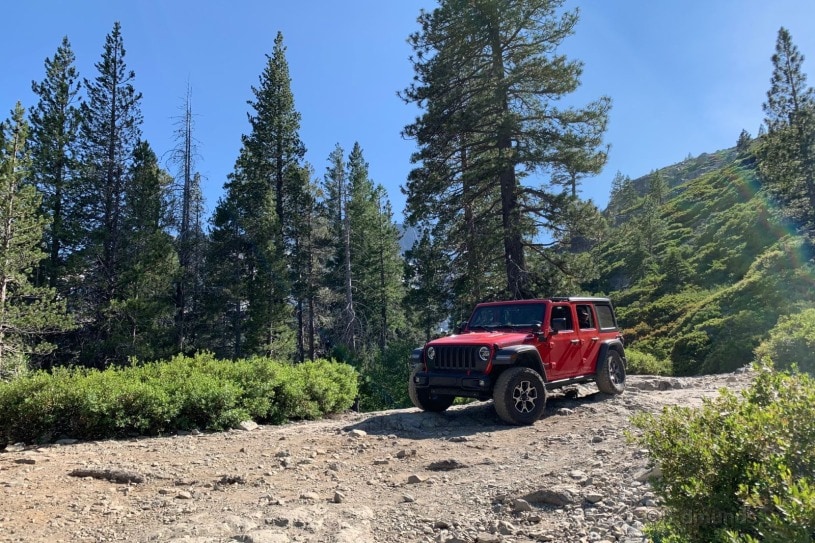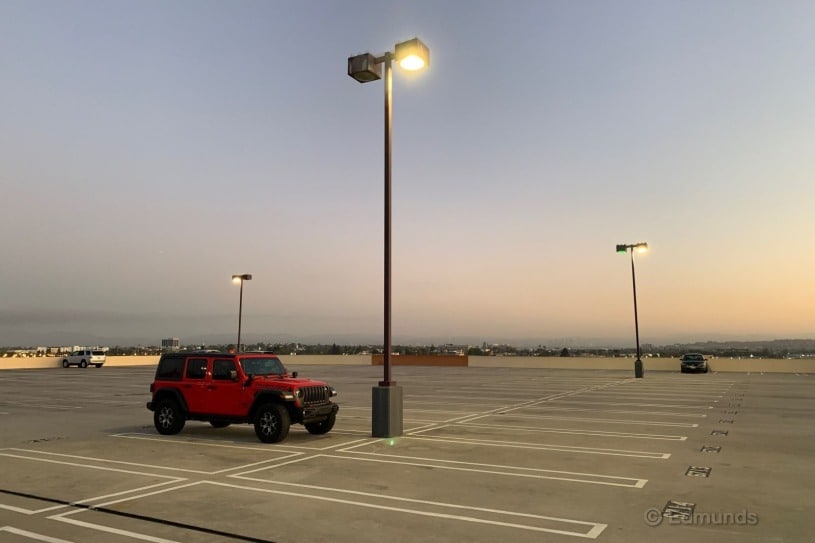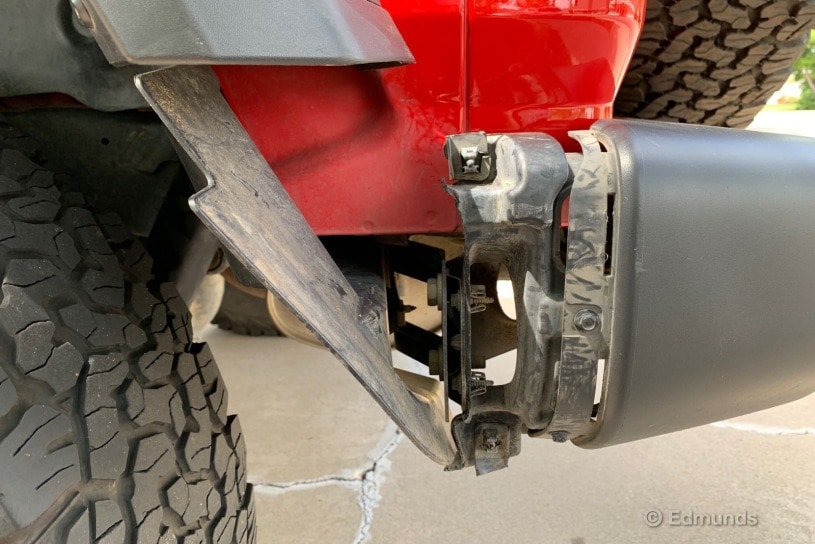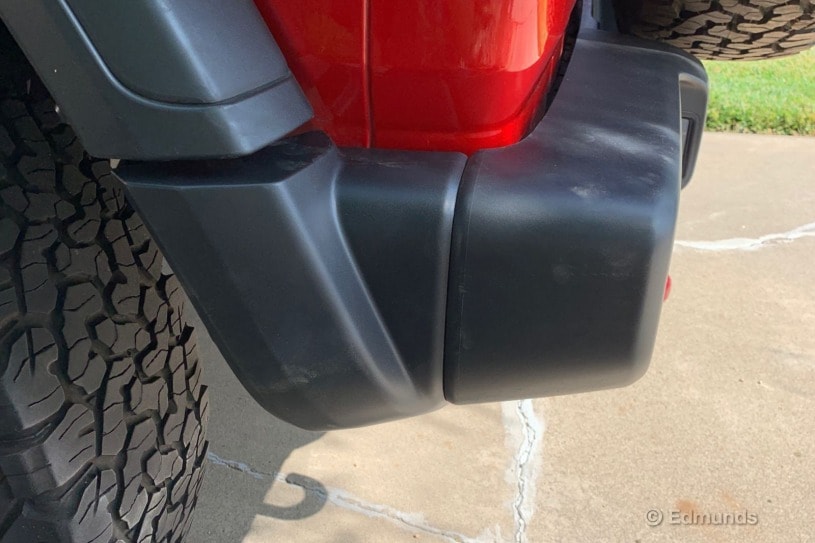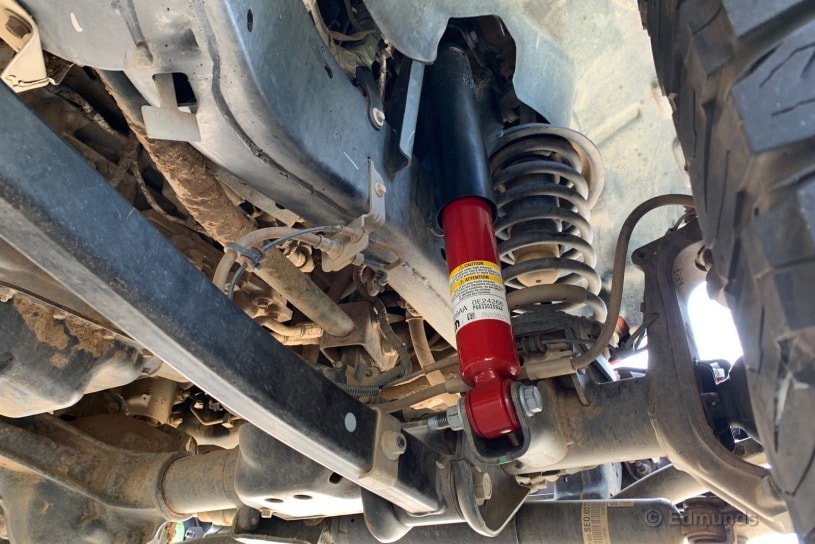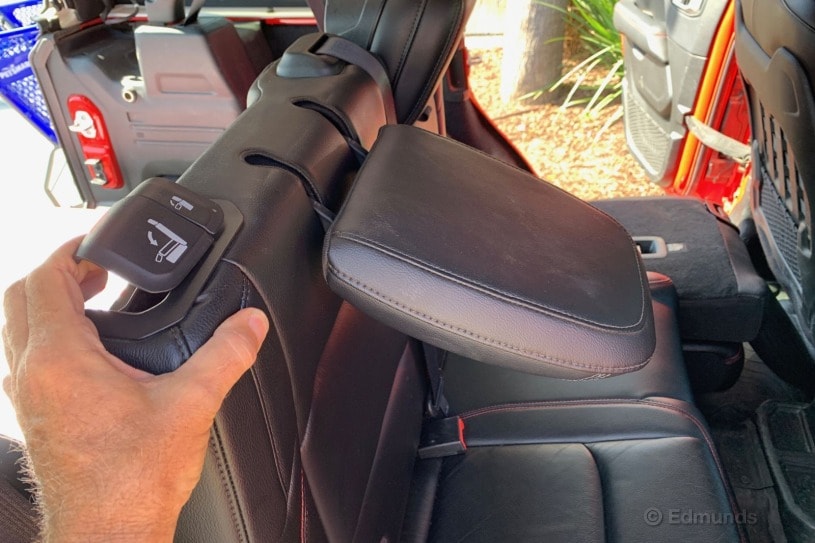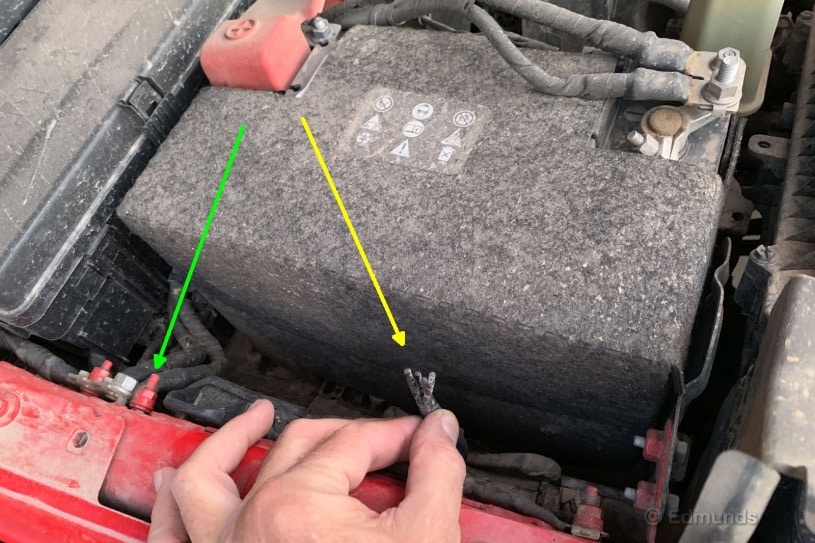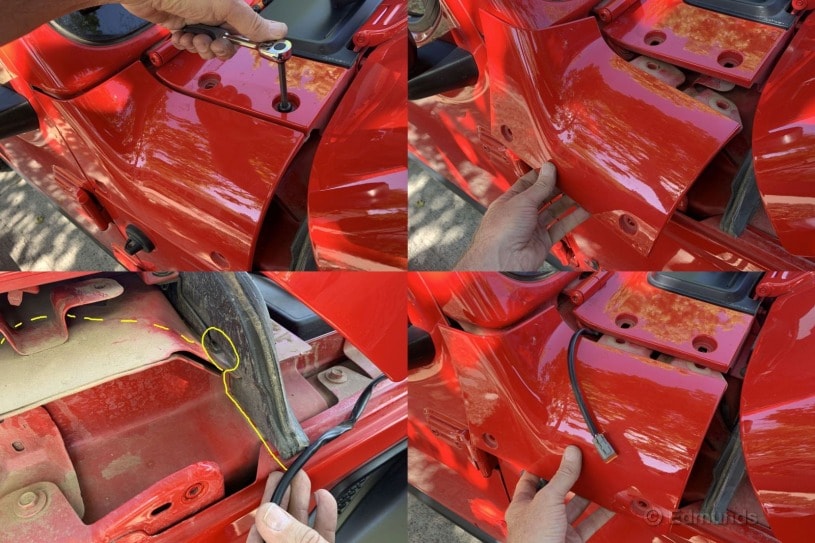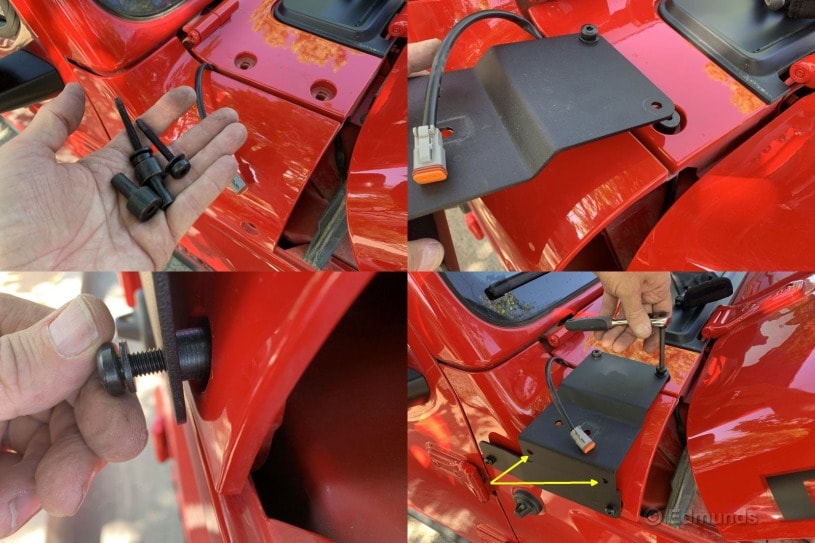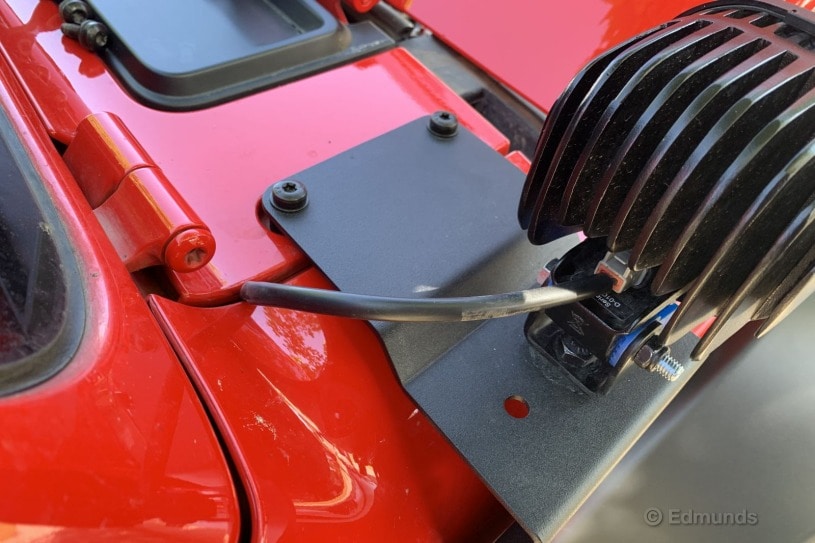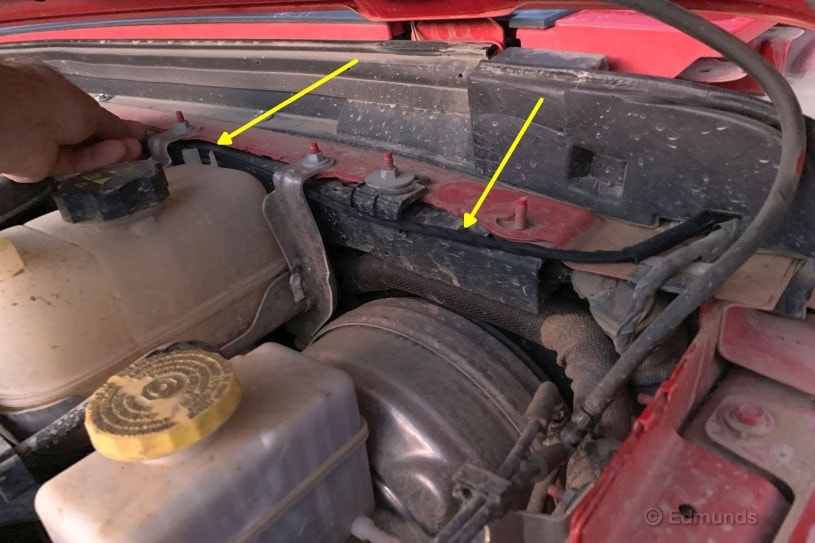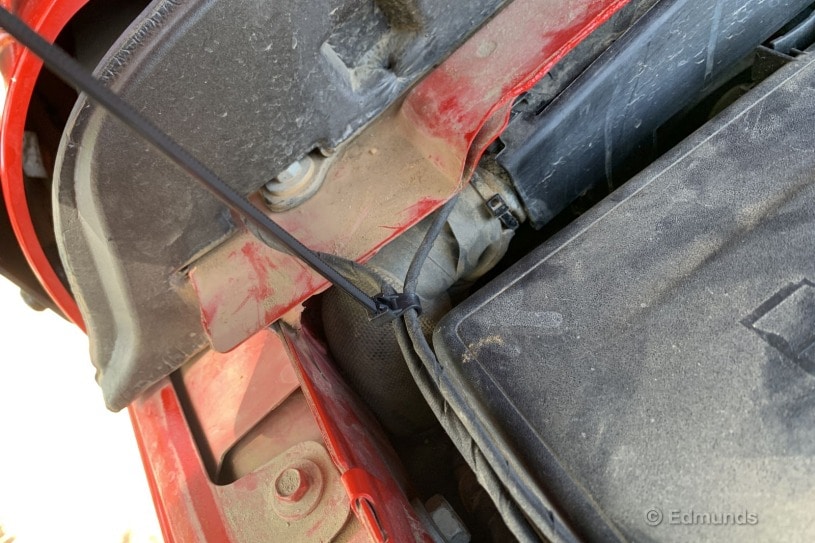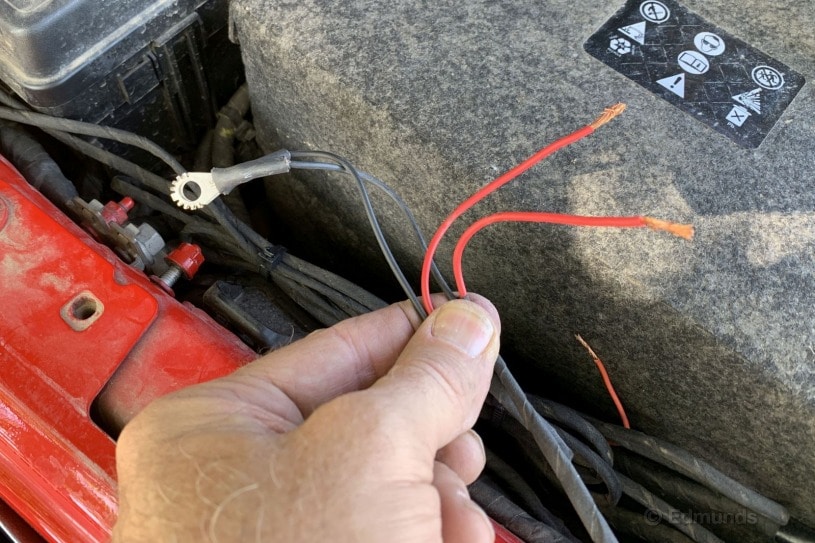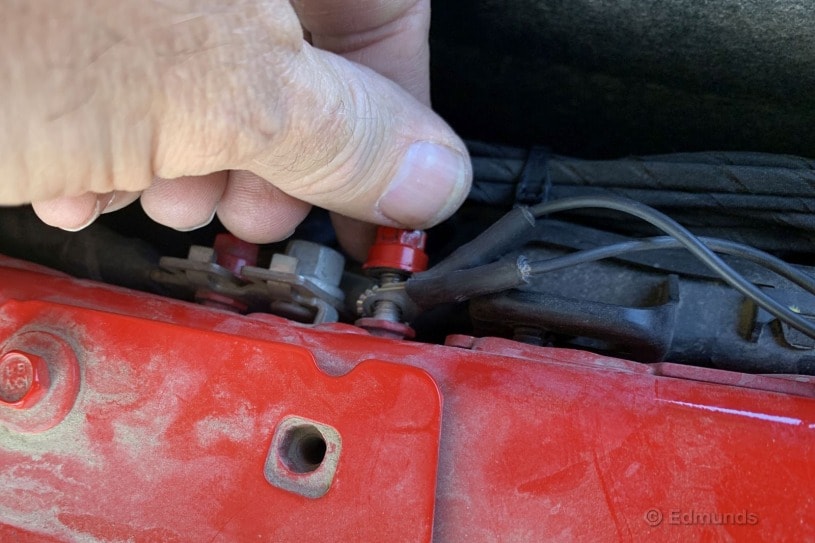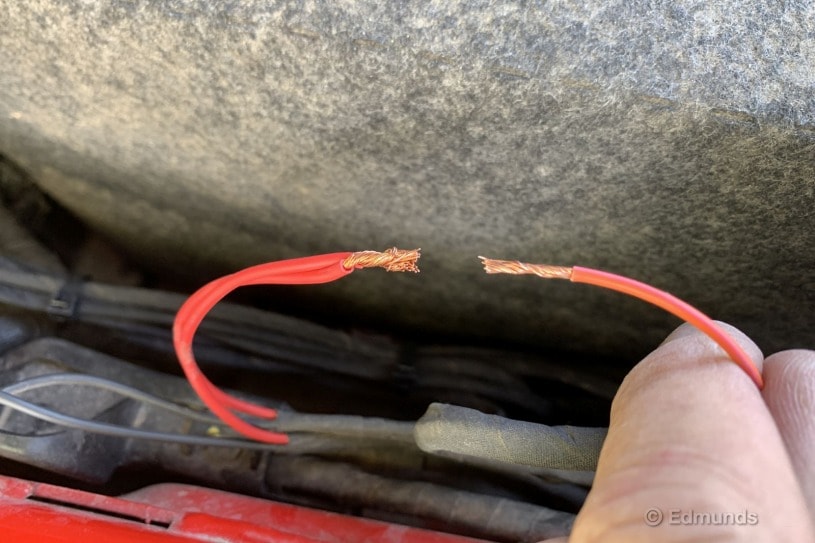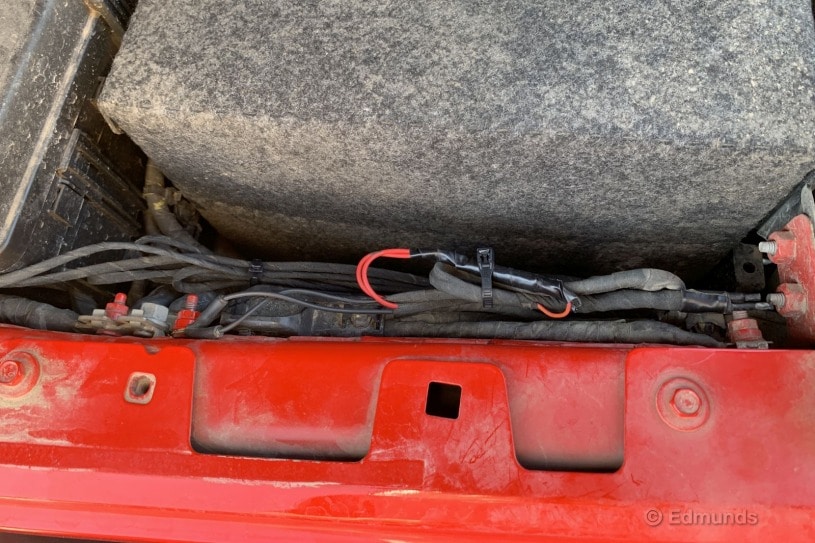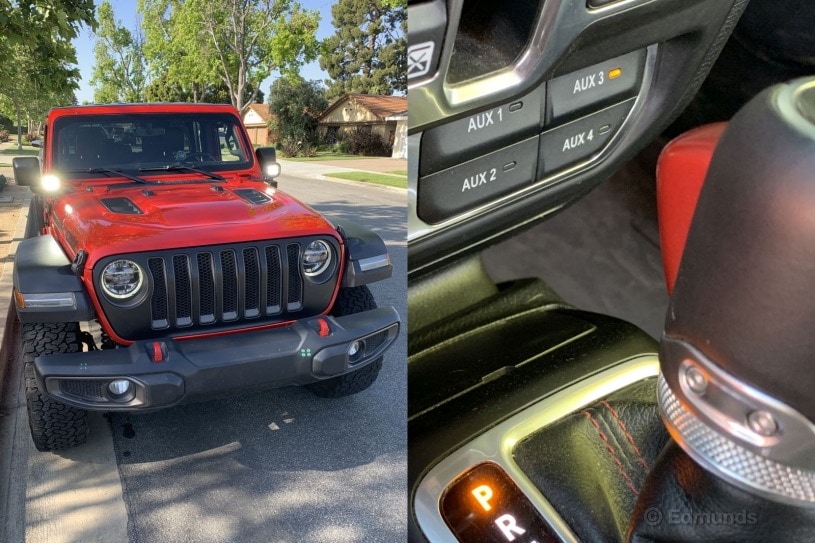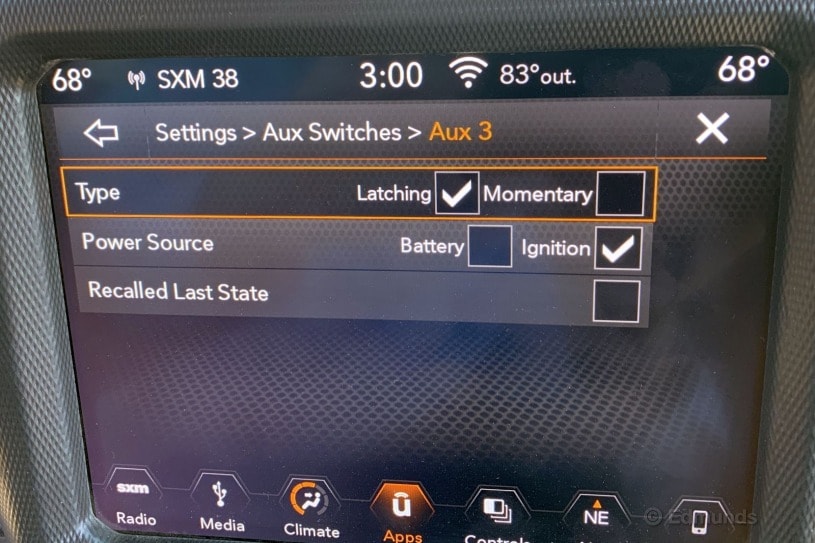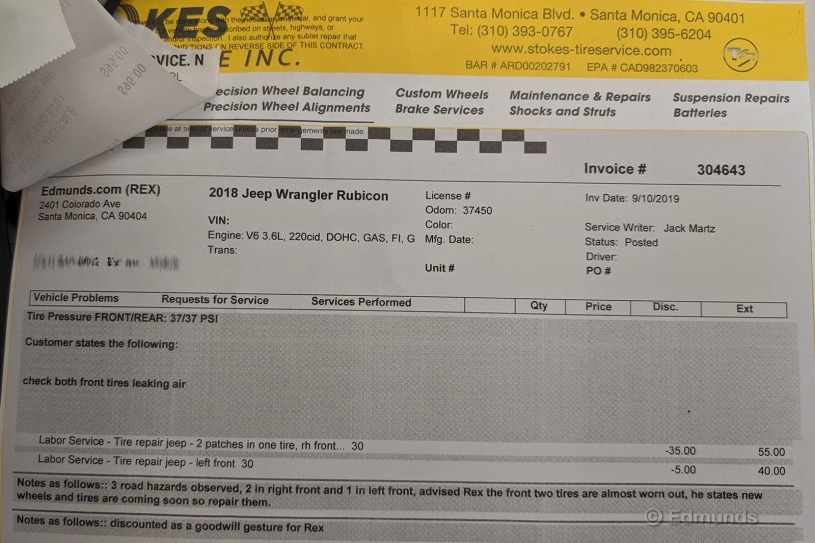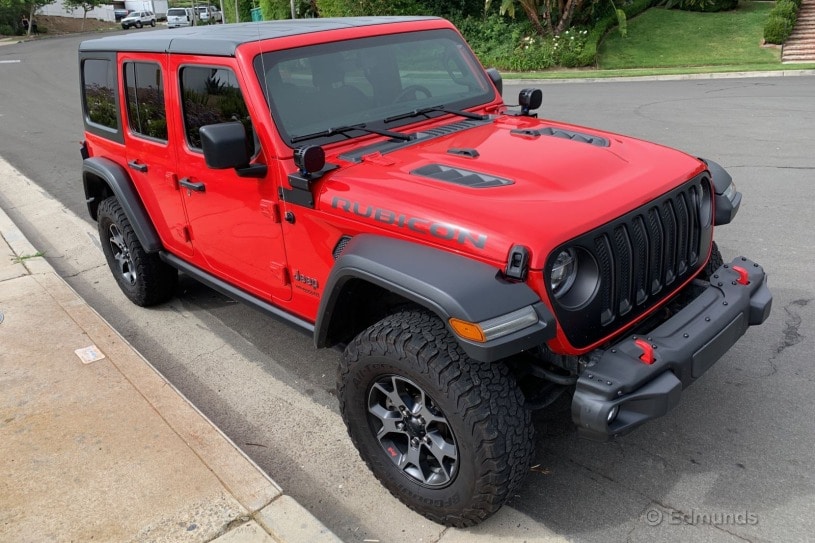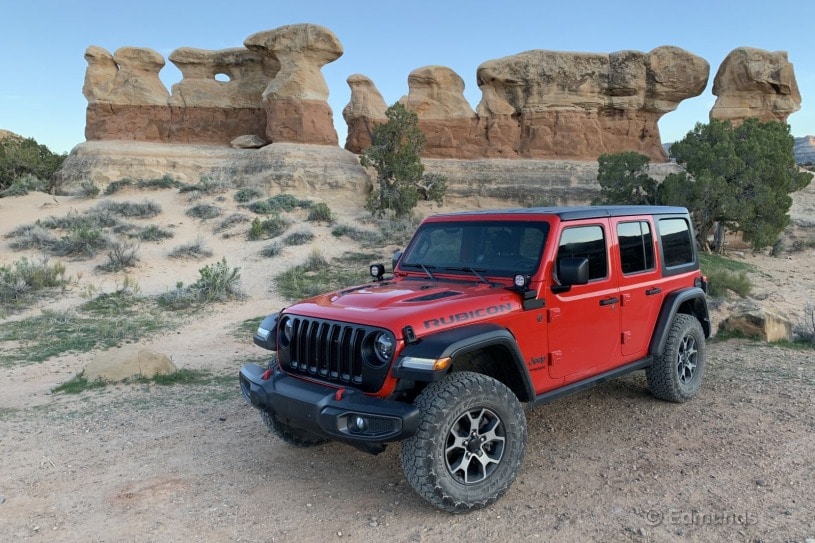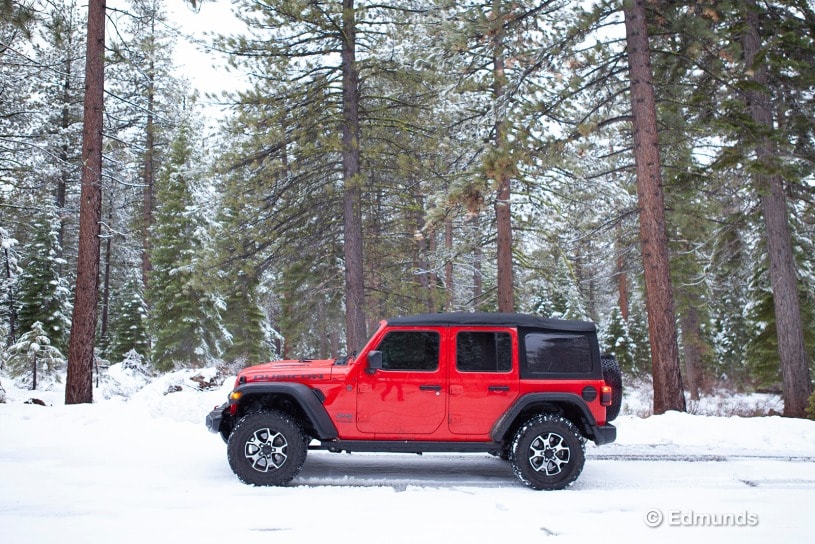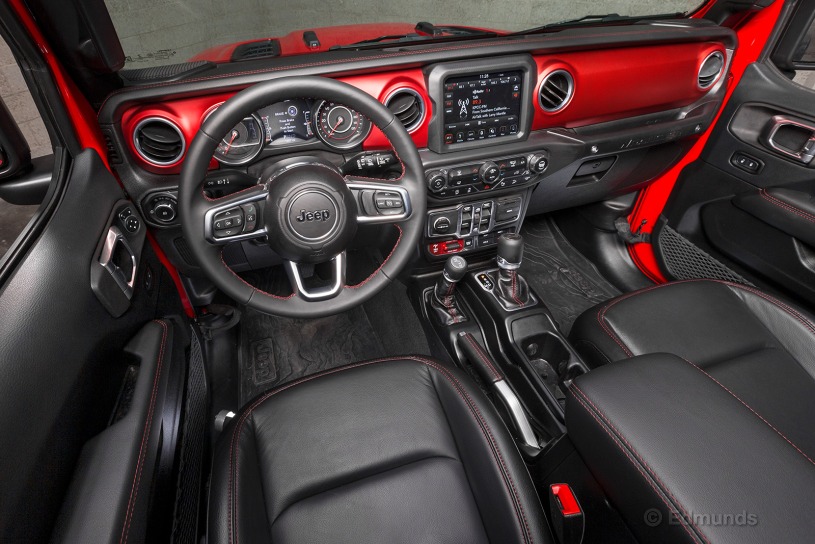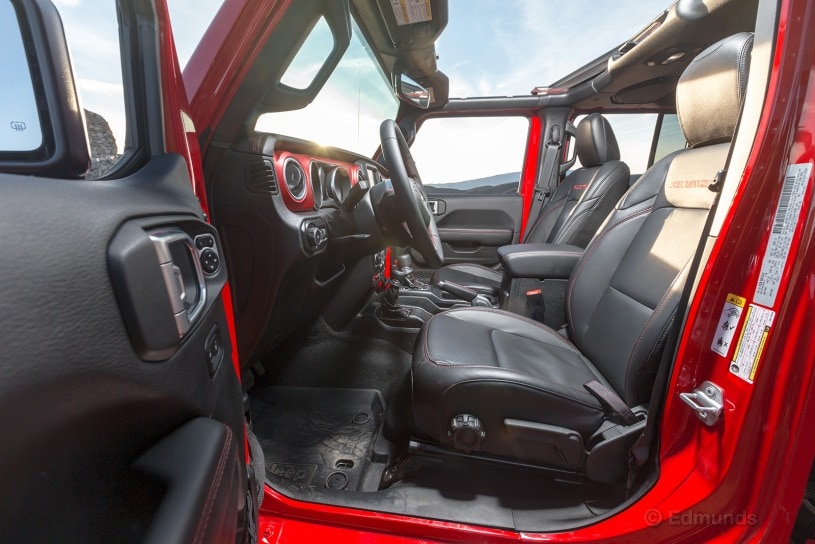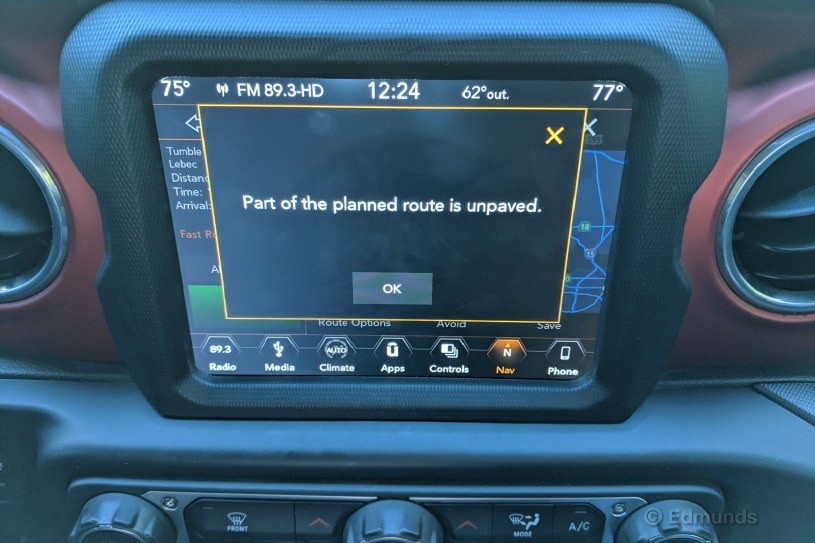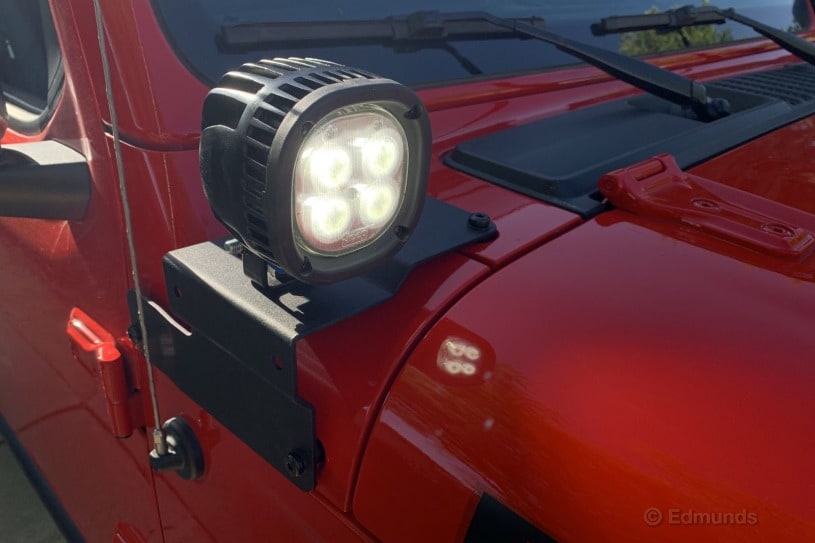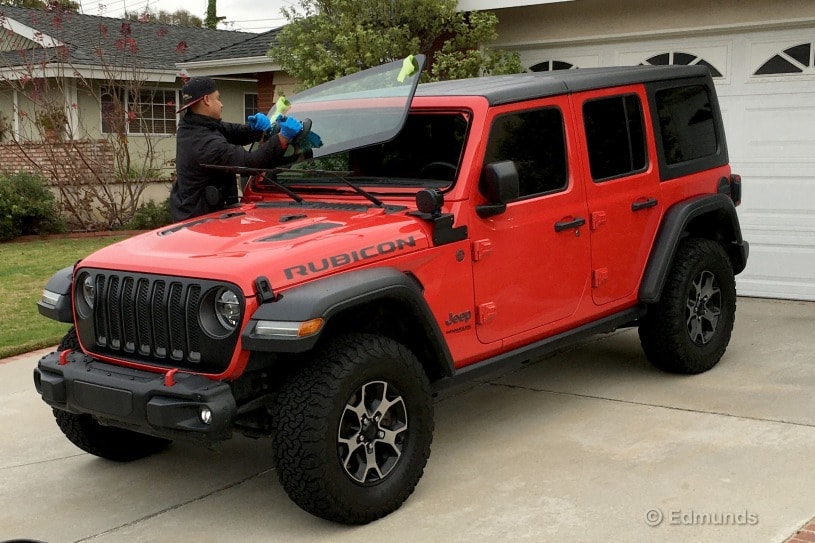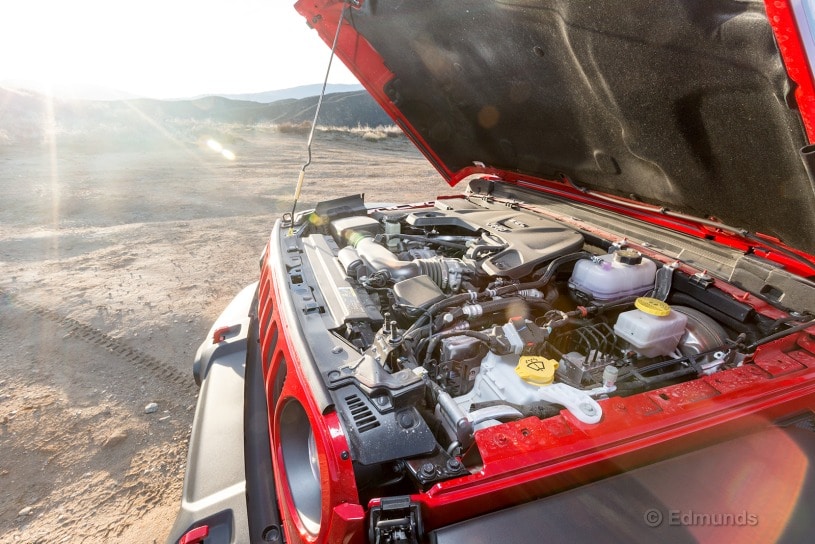2018 Jeep Wrangler: What's It Like to Live With?
Read the latest updates in our long-term road test of the 2018 Jeep Wrangler as our editors live with this car for a year.
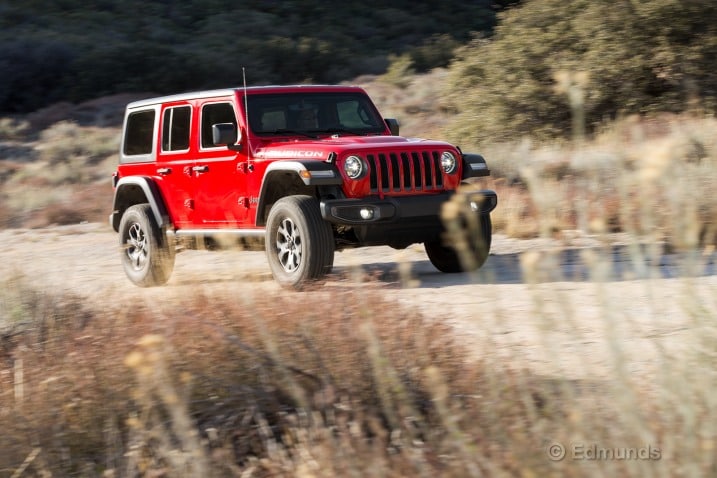
What do you want to know about?
- Introduction
- Monthly Update for March 2018
- Moab Easter Jeep Safari
- Monthly Update for April 2018
- Monthly Update for May 2018
- Monthly Update for June 2018
- Monthly Update for July 2018
- Monthly Update for August 2018
- Monthly Update for September 2018
- Monthly Update for October 2018
- Monthly Update for November 2018
- Monthly Update for December 2018
- Monthly Update for January 2019
- Monthly Update for February 2019
- Monthly Update for March 2019
- Installing a Mopar Grille
- Monthly Update for April 2019
- Monthly Update for May 2019
- Monthly Update for June 2019
- Monthly Update for July 2019
- Monthly Update for August 2019
- Installing and Wiring Mopar Lights
- Monthly Update for September 2019
- Wrap-Up
Introduction
Wrangler Owner No. 1: I just sold my JK to buy a new JL.
Wrangler Owner No. 2: Nice. I am restoring a CJ right now. Sold my YJ and TJ to buy it.
Few car owners are as fanatical as those who drive Jeep Wranglers. Within this club, it is just as likely that a car be described by its two-letter chassis code as by the trim level or model year it was built. Aftermarket modifications are the norm. And there is that wave of camaraderie they give when passing each other on the road. It's a tight community that knows its stuff.
When the 2018 Jeep Wrangler JL was announced, word traveled quickly. It was fully redesigned: The five-speed automatic transmission was now an eight-speed; its soft top was improved; it used lighter-weight construction; it had optional LED headlights; interior materials were nicer; there were many Rubicon-specific enhancements; and more. This was now the Jeep to have.
What Did We Buy?
Back to chassis-code talk. New JLs and last-gen JKs were being sold as 2018s on dealer lots concurrently. So the distinction was important to understand before buying a car to avoid confusion. Some places described them by code, while others simply advertised them as "new 2018 Wranglers."
The 2018 Wrangler JL was available in four trims: Sport, Sport S, Sahara and Rubicon. Two doors, four doors and other configurations can be had from there. Read every detail on the Wrangler model review page. But here we'll focus on our car.
From the start, we wanted a Wrangler Rubicon Unlimited. Rubicon was the most capable turnkey 4x4 option in the lineup. Going with the four-door Unlimited put the key in our hand right away rather than having to wait months for the two-doors to go on sale. It was also the volume-selling configuration. We set our sights on the improved premium soft top, which proved difficult to find. Our solution was the dual-top option, giving us the best of both worlds so long as we could find a place to store the unused roof. Additional must-haves were the tow package, the 8.4-inch upgraded Uconnect screen and the Firecracker Red paint job. We ultimately found a car, parked 300 miles from our office on a Las Vegas car lot.
What Options Does It Have?
Some features we touched on above. Here's a bit more detail. The Wrangler Rubicon Unlimited started at $40,495, and the standard amenities were extensive. Of these, the more significant were its revised 3.6-liter V6 (280 horsepower, 260 pound-feet), six-speed manual transmission, a Dana M210 front axle and a Dana M220 rear, 4.10 axle gearing, a 4:1 low range, front and rear electronic locking differentials, electronic anti-roll bar disconnect, rock rails, 17-inch wheels, 33-inch tires, unique fenders to fit the big tires, a full-size spare tire, a 60/40-split fold-flat rear seat and a rearview camera.
Our car had options on top of these. We took the eight-speed automatic ($2,000) over the manual transmission this time. Leather-trimmed interior bits ($1,495), the tow package ($795), LED lights ($895), the 8.4-inch Uconnect display and navigation ($1,495), dual tops ($2,195), the parking assist system and rear cross-traffic alert ($795), a hardtop headliner ($525), all-weather mats ($130) and remote start all cost extra. These brought the MSRP to $52,510. Tack on a dealer-installed profusion of micro VIN markings, called DataDot DNA, for $189. Our out-the-door price at this no-haggle dealership was $52,699.
Why We Bought It
The extensive list of new technology, upgrades and refinement were the obvious reasons to purchase a new Wrangler. They included lightweight aluminum doors for easier removal, refashioned windshield bolts to simplify its removal, pre-wired upfitter switches in the dash, a stronger tailgate to support the heavy spare, a lower spare tire-mounting point to improve visibility, and a rearview camera inside the mounting bracket. But there were other reasons.
The Rubicon. This wasn't our first long-term Wrangler. Our civilian 2007 Wrangler Sahara Unlimited introduced us to the best-selling four-door configuration, which felt like a good fit. More recently we bought a lightly optioned 2012 Wrangler Sport and built our own Rubicon using aftermarket parts. Since this new Rubicon had a long list of new upgrades, this was a great time to buy one out of the box.
The dual tops. Manipulating the soft top on a Wrangler has historically been an art form, requiring hours of practice to master. But Jeep reengineered this top for easier folding. It also allows for a safari configuration, in which the side windows come off but the roof remains. The hardtop is constructed of lightweight materials, suggesting its removal and installation won't be the same two-person back wrencher of old.
And so marks the beginning of our one-year test of the 2018 Jeep Wrangler JL. Follow its progress on our long-term road test for our latest thoughts on this 2018 Jeep Wrangler Rubicon.
Edmunds purchased this vehicle for the purpose of evaluation.
Monthly Update for March 2018
Where Did We Drive It?
In the first month of our one-year test, we drove our new 2018 Jeep Wrangler nearly 2,000 miles. It might be a bit early for predictions, but the way this one is going, the Jeep will hit the 20,000-mile mark well before a year is up. To get the odometer rolling, we drove the Jeep back to Los Angeles from the Las Vegas dealership where we bought it. Then we spent the next three weeks around town getting to know its character. Short freeway trips, runs to the grocery store, and commuting to work all added up to an odometer reading of 2,251 miles.
What Kind of Fuel Economy Did It Get?
Driving back from Las Vegas with a loaded cargo bay and several short local trips don't make the Wrangler's fuel economy look very impressive. But EPA estimates are higher for this generation Wrangler than for the 2014 Wrangler JK we drove for a year, so we're expecting things to get better.
Average lifetime mpg: 17
EPA mpg rating: 20 combined (18 city/23 highway)
Best fill mpg: 19
Best range: 329.9 miles
Current odometer: 2,251 miles
Maintenance and Upkeep
None.
Logbook Highlights
Interior
"The Wrangler's cabin is a nice place to be. The controls are easy to reach. The materials feel good — especially considering that this is a Jeep. I don't feel like I'm at a Tupperware party with all that plastic, like I do in the Tacoma TRD Off-Road. Maybe my expectations are set low, but I generally like how this thing is equipped. I also like the seating position." — Rex Tokeshi-Torres
Technology-Audio
"The sound-system USB connection to my Android device can be a little hit-or-miss sometimes. If I start the car and plug in the phone, the playback sometimes sounds like it's in mono, not stereo. I even checked the sound settings to see if I could adjust the sound position and I could not. So I disconnected my phone to see if that would fix it, but it didn't. So I left my phone connected, turned off the Jeep, then turned it back on and voilà! Everything was back in stereo!" — Rex Tokeshi-Torres
Performance
"I was totally impressed with the Wrangler's off-road capability. On my first excursion, I was careful because I didn't want to be 'that guy' and roll the brand-new Jeep onto its side or get it stuck in a ditch. But Scott Jacobs encouraged me by saying, 'It's more capable than you think. Just keep the power constant — not floored, but constant.' The suspension articulation is what impressed me most. I thought I was going to tip sideways on one occasion because I was going through deep, uneven ruts, but it kept going like a champ, never actually tilting over. It was unnerving at first, but I got used to it and it became fun toward the end." — Rex Tokeshi-Torres
"What's up with this Wrangler wiggle? These off-road tires are great and provide stability when the path is shaky, but on-road they make the Wrangler wander around. There's always constant adjustment." — Rex Tokeshi-Torres
Miscellaneous
"This Wrangler is the polar opposite from the last one we had in our long-term fleet. That one was a base model, with only A/C as an option. With this in mind, it's nice to see what the other end of the spectrum looks like. While I appreciated the purity of the last one, this loaded model suits me better. If it were my money, I'd skip the Rubicon trim (I don't plan on off-roading anytime soon) and get the Sahara version. This would save me a few thousand dollars, too. I'd also wait until I could get one in the eye-catching Mojito Lime Green, which has a late availability, according to the Jeep website." — Ron Montoya, senior consumer advice editor
Cargo Space
"Wranglers with the dual-top option offer the best of both worlds in terms of roof options. The hardtop comes with the car from the factory, while the soft top is stored in a box inside the vehicle, showcasing the Wrangler's cargo capacity. The huge box occupies nearly the width of the interior, is pressed right up against the front seats, and goes all the way to the rear cargo door. I'd have a hard time driving this Jeep home if I were any taller. The box had some padding on the corners, which took up more space and required a good shove to close the rear cargo door." — Ron Montoya
Moab Easter Jeep Safari
The Easter Jeep Safari is a yearly event in Moab, Utah, that hosts pretty much every kind of stock, modified and owner-loved Jeep you can think of, driving through the desert for a week. If it's got sand, mud, slick rock or dirt, you'll likely find a Jeep trying to conquer it during the week before Easter.
The Easter Jeep Safari has run for more than 50 years, and recently the folks at Jeep have used it as an opportunity to showcase their newest vehicles, display a few concepts, and get to know their customer base. After all, if this is where the world's biggest Jeep enthusiasts show up, why not ask them what they want on the next Wrangler?
This year, Jeep had a lot to show with the release of the new, redesigned 2018 Wrangler (JL) and invited us out to ride the trails in Wranglers, Cherokees and even a few concepts. As if by some stroke of luck, the Wranglers present were nearly identical to our long-term 2018 Jeep Wrangler Rubicon Unlimited, even down to the red paint, so I spent as much time in it as possible.
So what did Jeep bring to the desert? For starters, a long lineup of Trailhawk models. The Cherokee and Grand Cherokee ferried us around the week's events and also got us pretty far off road, too. But the main car we drove came equipped almost identically to our long-term Wrangler: a red Rubicon Unlimited with the same tires, suspension, interior — you name it. The only difference was the top. The Moab car had a power convertible top, while ours has a removable hardtop.
After driving several examples of the boxy red rig, I can safely say that our long-term Wrangler's strange wandering tires are an issue across the lineup. Buy a Wrangler Rubicon and you'll need to pay serious, constant attention to where the nose is pointed on the highway. Even on an arrow-straight highway, it can feel as if you're being pulled in different directions by the tire tracks.
I can also say that I'm very much looking forward to a year with this Wrangler. Our last long-term Wrangler, a two-door convertible with a manual transmission, was a basic expression of what a Wrangler could do. This Rubicon feels several notches higher up the off-road ladder, and it's exponentially more comfortable.
Then there were the concept Jeeps. A concept Renegade made an appearance, as did a lightweight Wrangler two-door concept called 4Speed. Both were sidelined from the outset, so we had no time behind the wheel. The 4Speed might have been one of the most interesting concepts, though: an original two-door Wrangler with nearly 1,000 pounds shaved off. I even liked the color.
Most of the other concepts were kept up and running, including the luxury-adjacent J-Wagon (a not-so-subtle jab at Mercedes), the Jeepster, a fantastically good-looking resto-modded Wagoneer, a yellow Mopar parts vehicle called Nacho, and my personal favorite: Sandstorm.
Sandstorm is a four-door Unlimited Wrangler with the top chopped off, an extended wheelbase and a 392-cubic-inch Mopar V8 shoved under the hood. It's like a Baja desert racer, but with a six-speed manual and 37-inch tires. I can't remember having a bigger laugh behind the wheel of any car I've ever driven.
The Sandstorm, which I just referred to as the Scrambler, would blast over any small obstacle in a massive hurry, with fantastic clutch engagement to match its bare-bones interior. If you have the means to buy the Mopar crate V8 and get it under the hood of your Wrangler, then do it. Everyone who goes for a ride will thank you for it.
The standard Wranglers we drove were almost as fun, but at a much different speed. Low-speed crawling is easy in the new JL, and even easier with all the controls at your fingertips. Switching between 4-Hi and 4-Lo, connecting and disconnecting sway bars, engaging the rear lockers — all of it was like second nature from behind the wheel. There isn't a vehicle on the market easier to take off-road in seriously treacherous places. There's no accounting for human error, of course, but if you read the manual or have a mildly competent understanding of driving off-road, there are few places you can't go in a Wrangler.
Monthly Update for April 2018
Where Did We Drive It?
Our 2018 Jeep Wrangler is settling nicely into the long-term fleet. During its second full month of ownership, our JL spent time commuting and off-roading on a camping trip to Joshua Tree National Park. You know, typical Jeep stuff.
So far we appreciate our Jeep's entertainment interface, specifically the navigation system's ability to route to GPS coordinates and the inclusion of a USB-C port. On the downside, we also learned our Wrangler is no less susceptible to fender benders than any other vehicle on the road. We'll report about that experience and the subsequent bodywork soon.
What Kind of Fuel Economy Did It Get?
The aforementioned fender bender put our Wrangler in the body shop for half of April, so we didn't log as many miles as the previous month. We covered 1,033 miles and consumed 56 gallons of 87 octane fuel, giving us a monthly average of 18 mpg.
Average lifetime mpg: 17.3
EPA mpg rating: 20 combined (18 city/23 highway)
Best fill mpg: 20.3
Best range: 329.9 miles
Current odometer: 3,285 miles
Maintenance and Upkeep
None.
Logbook Highlights
Performance
"It's funny, the Wrangler's old straight-six used to be in keeping with its rough-and-tumble image. But the new(ish) V6 and eight-speed auto are clearly more modern and refined than the rest of the package. The powertrain's really quite good, giving the Wrangler a wide ratio spread and no shortage of oomph. Just the thing for when you're crawling over a technical trail or on a freeway cruise." — Jason Kavanagh, senior road test engineer
Comfort
"At freeway speeds, the Wrangler is obnoxious. The wind noise is extreme, and extremely fatiguing on long trips. Add in the ropey and imprecise steering and it's clear that the Wrangler's creators value off-road cred over everyday pleasantness." — Jason Kavanagh
Technology-Audio
"For some reason, we thought it was a good idea to head to our campsite outside of Joshua Tree National Park on a Friday at midnight. Way out there in the desert there's no cellphone signal. Our camping companions who had picked this site had only given us coordinates for the camp, knowing we wouldn't be able to rely on Waze for guidance. We tried downloading the map of the coordinates and directions beforehand. But off-road, in the middle of nowhere, we made one wrong turn and instantly those directions were useless.
"We were lost in this desert wasteland with no way to contact our friends or look up an online map. I admit I felt a bit panicky. I watch a lot of horror movies and this is how they usually start. But thankfully, the Wrangler's navigation lets you enter coordinates for your destination, because of course it does. Even off-road it gave us turn-by-turn instructions to find our camp." — Caroline Pardilla, senior copy editor
"Since my Google Pixel 2 XL only came with a USB-C cable and no USB converter, I've been having difficulty jumping in cars that only offer that regular USB option. Extra problematic when, as a passenger, I'm both the navigator and DJ. Fortunately the Wrangler offers an array of ports, including one for the USB-C cable, aux and regular USB, so I can keep all my devices at 100 percent." — Caroline Pardilla
Miscellaneous
"Let's get philosophical. The Wrangler is unique in the automotive landscape. It's iconic, and the things it can do off-road are unmatched among box-stock vehicles. I am elated it exists. But I don't want one. The cruddy steering and awful wind noise make it unsuited for the long trips required to get to the places where the Wrangler is good. And none of the Wrangler-specific body attributes like its removable doors, flip-down windshield or convertible top hold any appeal, and in fact they detract from its functionality and refinement. Yeah, yeah — 'it's a Jeep thing.' Keep telling yourself that." — Jason Kavanagh
Monthly Update for May 2018
Where Did We Drive It?
In contrast to April's camping adventure in Joshua Tree, our 2018 Jeep Wrangler spent the majority of May roaming the concrete jungle of the Los Angeles sprawl. We mentioned in the last update that we'd been rear-ended, which caused some damage to the rear bumper and landed the Wrangler in the body shop at the end of the month.
The damage, thankfully, wasn't very extensive, though we did have to wait a couple of weeks for parts. Replacement items consisted of the rear bumper, rear parking sensors and the right rear bumper reflector, a pretty straightforward fix.
Once the Wrangler was back on the road and with summer on the way, we decided it was time to swap the hardtop for the soft top. Depending on your Jeeping priorities, you'll likely prefer one over the other. Some staffers have already voiced their preferences in the comments below.
What Kind of Fuel Economy Did It Get?
Although we covered slightly more ground in May — 1,082 miles — compared to April, fewer free-rolling highway miles dipped us below May's average and dragged our lifetime average down 0.3 mpg. We managed just 16.1 mpg in May, our lowest result since picking up the Wrangler in February.
We've only filled up a couple of times since installing the soft top, and it'll be interesting to see if it has any effect on our average over the summer.
Average lifetime mpg: 17
EPA mpg rating: 20 combined (18 city/23 highway)
Best fill mpg: 20.3
Best range: 329.9 miles
Current odometer: 4,369 miles
Maintenance and Upkeep
There are a few recalls out for the 2018 Jeep Wrangler, but only one potentially affects our vehicle — and 4,846,884 other Fiat Chrysler vehicles — based on its date of manufacture.
The NHTSA Campaign Number 18V332000 states that "these vehicles are being recalled to address a defect that could prevent the cruise control system from disengaging. If, when using cruise control, there is a short circuit within the vehicle's wiring, the driver may not be able to shut off the cruise control either by depressing the brake pedal or manually turning the system off once it has been engaged, resulting in either the vehicle maintaining its current speed or possibly accelerating."
Chrysler has advised owners to stop using cruise control until a software update has been performed, which is expected to be available beginning July 6. It continues: "In the event that cruise control cannot be disengaged while driving, owners should firmly and steadily apply the brakes and shift the transmission to neutral, placing the vehicle in Park once it has stopped."
This is sound advice and should be heeded. We know because we put it to the test. While we agree that this is a potentially disconcerting situation for drivers to deal with, incidents resulting from such issues are largely avoidable.
Logbook Highlights
Interior
"One of the unfortunate effects of the airbags-everywhere design philosophy of current cars is thick door pillars that inhibit rear visibility. The Wrangler doesn't have this problem since its sectional hardtop is meant to be removed. That means the pillars are whisper-thin and the side glass is tall and wide. Visibility in the rear three-quarters view and immediately behind the Wrangler is excellent (with the exception of the tire, which is in your sight line)." — Cameron Rogers, staff writer
"I expected the added noise and the lack of thermal insulation from the switch to the soft top. What I wasn't expecting was the lack of insulation from smells. Even with the A/C set to recirculate, I could smell every diesel, every car that's been dodging the smog test, all the roofing tar and garbage trucks, and even the Jeep's own rich exhaust at startup. I get that this car is all about being closer to nature or whatever, but I didn't think it would bring me this much closer to tailpipes." — Will Kaufman, associate staff writer
Comfort
"The Jeep takes more work to keep in a straight line on the highway than our long-term Colorado ZR2 (it's also noisier inside), but it rides better. And for me at least, the seat and seating position are more comfortable. Also, I'm on record as disliking the ZR2's diesel. If I had to choose an off-roader to live with every day, I'd take the Jeep over the Chevy." — Will Kaufman
Miscellaneous
"I was really excited to put down the Jeep's recently installed soft top — until I looked up how to do it. It's a pretty serious procedure. I know I'm not this car's target audience, but having to go through this many steps would discourage me from even trying it unless I knew I was going to spend a whole day driving around with it off. This isn't a roof you put down for a short drive." — Will Kaufman
Monthly Update for June 2018
Where Did We Drive It?
June was a strong month for our 2018 Jeep Wrangler. We drove it 3,335 miles, more than triple the previous month's total. Much of that — 2,539 miles, to be precise — was the result of a single road trip to Colorado and back.
My wife had business over the weekend in Denver, and she's not fond of flying. So I grabbed the keys to the Jeep and we headed out after work. We made a late-night stopover in Las Vegas, then completed the drive the following day.
I had pre-loaded the back with camping equipment with an eye toward overnighting in the mountains while my wife stayed in a Denver hotel. But when we arrived, weather forecasters were talking about powerful storms threatening heavy rain and hail. I decided on day trips out of Denver instead.
During my meanderings, I climbed two "fourteeners" in the Jeep, one to the summit of Mt. Evans (14,265 feet) and another to the top of Pikes Peak (14,114 feet). I didn't get as far off the grid as I had first imagined, but you don't have to get your tires dirty to find stunning vistas in Colorado.
What Kind of Fuel Economy Did It Get?
Slightly more than 2,000 of my there-and-back road-trip miles were pure freeway cruising. But Nevada and Colorado post their rural freeways at 75 mph, while Utah goes with 80 mph. We covered a lot of ground in a short time, but our pace was too brisk to expect mpg miracles.
At first, my best tank of 22.3 mpg (a new record for us) looks pretty decent next to the 2018 Wrangler's EPA highway rating of 23 mpg. But many tanks were worse than that, with fully half of them in the teens. The overall average of these 10 fill-ups was 19.6 mpg, a figure that only just rounds up to our Jeep's EPA rating of 20 mpg in combined driving.
The tanks that took me to two mountaintops can't be blamed since both of them met or exceeded the average. Sightseeing speeds are relatively low, and the drive to each summit represented no more than a dozen or so miles of the tank they were part of. And then there's the part where you get to come back down. In reality, the trip up Pikes Peak was part of the tank that set a new best-range record of 357.3 miles. That tank's 21.6 mpg was the second best of the trip as well.
Speed kills fuel economy, as do headwinds. We had plenty of both on the open road and the timing of the passing storm seemed to result in headwinds in both directions. The trip's worst tank of 15.5 mpg came on Utah's 80 mph interstates while heading home into a particularly fierce gale. Because of its upright boxiness, headwinds are especially damaging to a Jeep Wrangler's fuel economy.
But that tank did not represent this month's worst performance. The 800 or so miles that fell outside my trip were mostly L.A. city tanks driven by other staffers, and during this period it earned 12.9 mpg at the hands of someone with a particularly terrible commute. That's not just the worst tank of the month — it's the worst tank we've recorded so far.
It's worth pointing out that the Wrangler's rated fuel economy doesn't distinguish between Sport, Sahara and Rubicon. Compared to the others, our JL Rubicon is a hiked-up version with more prominent fenders, wider axles and fatter, knobbier tires. You'd pick the Rubicon as the thirstiest of the three just by looking. Our lifetime average of 17.6 mpg (up from 17 mpg last month) may seem like a big miss, but I frankly don't think matching the 20 mpg EPA combined rating is in the cards. I'd be disappointed if this was a Sahara, but I'm more philosophical because we opted for a Rubicon.
Average lifetime mpg: 17.6
EPA mpg rating: 20 combined (18 city/23 highway)
Best fill mpg: 22.3
Best range: 357.3 miles
Current odometer: 7,704 miles
Maintenance and Upkeep
Nothing this month.
Logbook Highlights
Performance
"We had strong head- and crosswinds during a big portion of our trip, and it took effort to keep the Wrangler headed straight due to its antiquated steering — a necessary evil that enables the solid front axle and gives it off-road excellence. These conditions revealed a lot of slop around center. After time, I got used to steering it like a boat: Let it squirm and meander without applying too much correction. Thankfully this tendency subsided as the wind died down, although I still believe [this Wrangler] has a worse sense of straight-ahead than my own JK Wrangler. The effect all but disappeared on winding mountain roads, where the steering seemed responsive, predictable and fairly confidence-inspiring despite a lack of feel." — Dan Edmunds, director of vehicle testing
"Because the Jeep sits so high, I was a little nervous about the winding hills on California 178 along the Kern River. My instinct initially was to go really slow (probably too slow), but as I got more comfortable I picked up my speed and it handled the curves really well. Coming back down was a breeze and a lot of fun." — Laurel Carden, social media manager
Comfort
"The long road to Denver revealed much that was good about the Wrangler's ride and a bit I could do without. My wife is prone to carsickness, but after a short time we both realized that the Wrangler's body motion was nicely damped, neither too busy nor too floaty. It also rolls quite gradually in corners (and in response to wind gusts), which is usually what sets her off in a high-riding vehicle. There's a steadiness here that neither of us quite expected. The negative points were more predictable for a Jeep with solid front and rear axles; it'll shiver over potholes and twitch over midcorner bumps. All in all, I came away more impressed than I expected." — Dan Edmunds
"Unlike most of our drivers, I found the Wrangler surprisingly comfortable and, for the most part, the noise wasn't an issue. The seats are so plush I really didn't mind or even notice the shaking that most non-Jeep lovers complain about. Even with the soft top, the noise wasn't a problem for me. I enjoy music while driving and the sound system was enough to drown out exterior noise, except the sound of motorcycles and large big rigs. It was a bit unsettling when they would zoom by and sound like they were in the car with me." — Laurel Carden
"I spent some time driving our Rubicon around with the hardtop before we switched to the soft top, and the difference isn't massive. The hardtop isn't as quiet as you'd think, and the newly redesigned JL soft top isn't as noisy as any JK owner might expect. Is the JL soft top louder than the JL hardtop? Sure, a little. But it's miles quieter than my own JK's soft top.
"We spent a lot of time in crosswinds at 80 mph, and in those conditions the JL Wrangler was quieter than my JK Wrangler at 60 mph in still air. The main difference, I think, is the greater number of lateral support bows in the roof. The new JL's soft top has five of them. It's a much more rigid structure up top, and this benefit also helps to stabilize the upper edges of the removable rear windows." — Dan Edmunds
Technology
"I'm a big fan of Apple CarPlay because plugging in eliminates the need to pair your phone with Bluetooth. And the Apple Maps app has gotten so good lately that I no longer care that Google Maps doesn't get a CarPlay icon. But there's a limit to smartphone-based navigation, and that limit is cellphone data coverage.
"The journey across Utah and into western Colorado is full of 'No Service' dead spots where such maps simply disappear. You can follow an existing route you established before losing the signal, but you can't search for any services or create a route from in there. That's why I'm glad we bought the enhanced 8.4-inch Uconnect system, which also has a traditional navigation system with an onboard database. I see this as a must for an off-grid, off-road vehicle such as the Wrangler, not to mention for regular folks who live and work in the rural areas we passed through." — Dan Edmunds
"As soon as I turned on the Jeep, Uconnect recognized I had a new device and prompted me to sync. I accepted the prompt and the syncing process was really easy. Halfway to my destination, however, it disconnected Bluetooth, saying there was no signal in range. Because I had so easily bypassed the process with the prompt, and I was driving, I was unable to reconnect until I stopped. From there I plugged in using my cable and stuck with Apple CarPlay." — Laurel Carden
Miscellaneous
"My own JK Wrangler is plagued by hood flutter at freeway speeds, especially when crosswinds appear. I often see the corners of the hood wobble as the rubber-band hood latches stretch. But we saw none of that in this new JL Wrangler in far more challenging conditions than my JK has ever been exposed to. The new 'lunchbox-style' positive hood latches and authentic fender vents really do the trick. They say the hood is stronger, too, but I'm thinking the latches and the pressure-relief vents are the big factors here." — Dan Edmunds
Monthly Update for July 2018
Where Did We Drive It?
June was a busy month for our 2018 Jeep Wrangler, but things returned to normal in July when we covered about 1,000 miles. And with only 8,000 miles on the odometer, our Jeep is still new to some of us, so first impressions continue to trickle in.
The Wrangler also went in for an oil change in July. Place your bets as to how you think that went for us.
What Kind of Fuel Economy Did It Get?
While we're still within sniffing distance of the EPA combined mpg rating, July was not kind to our overall mileage quest. Our average fuel economy hovered at a sobering 15 mpg. Big tires, a potent V6 engine and the aerodynamics of a barn door will do that.
Average lifetime mpg: 17.2
EPA mpg rating: 20 combined (18 city/23 highway)
Best fill mpg: 22.3
Best range: 357.3 miles
Current odometer: 8,818 miles
Maintenance and Upkeep
Our Jeep's use-based indicator light suggested we change the oil, so we did. While at the dealer, we also had a cruise control recall addressed in the form of a software reflash.
Logbook Highlights
Maintenance
"The use-based indicator alerted us that the Wrangler was due for an oil change, so we made an appointment at Huntington Beach Jeep. It turned out to be one of our least user-friendly service experiences.
"We first tried to make an appointment on the dealer's site. But when it wasn't working, we consulted with the chat operator on the site. That person couldn't actually book anything for us. Rather, he just sent a note to the service department with our request. It was 30 minutes or so before a service rep called to confirm the appointment, which was for a different time than I originally requested. But it all worked out.
"When we arrived for our 7:40 a.m. appointment, the service driveway was already packed. Three cars were ahead of me in one lane and another five cars in the next lane over. A porter came out to see me after a 5- to 10-minute wait.
"'I see you have an appointment,' he said. 'I'll get your adviser.' Cars in the next lane start moving. Another five minutes pass before a second porter walks up.
"'Can I help you, sir?' He now offers to locate the adviser assigned to my case. Things finally start moving forward.
"Eventually, I'm quoted three to four hours for the oil change and cruise control recall (reflash). Thirty minutes after my scheduled appointment time, the paperwork is finished and I'm calling for a ride home. It's frustrating.
"Three hours later the car is ready. There is no charge under the Jeep Wave program, which is free for 24 months or two oil change/tire rotations per year." — Mike Schmidt, senior manager, vehicle testing operations
Miscellaneous
"Our Wrangler participated in a Fourth of July parade in nearby Westchester, supporting a local elementary school. Who are we to pass up the opportunity to shuttle around a big-head koala mascot?" — Mike Schmidt
"The Wrangler's convertible top is ridiculously easy to use. No instructions, no YouTube research, and I was able to get the whole thing down in about two minutes. Putting it back together is pretty easy, too. I don't like the look of the soft top, but the improved functionality is excellent." — Travis Langness, staff writer
Interior
"This was my first time driving our Wrangler with the soft top. We have the premium Sunrider soft top, which is a $595 option on most trim levels. It's significantly quieter than the base top and totally worth the added cost. I wouldn't go so far as to say it is as good as a hardtop for noise reduction, but if you test-drive a model with the base and premium soft top back to back, you should be able to spot the differences." — Ron Montoya, senior consumer advice editor
"I had the misfortune of driving our cloth-topped Wrangler in the most recent heat wave, and this might be the biggest reason not to rock the soft top: It's not insulated, and you and your passengers will bake and wilt in the summer months. Sure, the A/C kept me cool, but only when it was near or at full blast. With a couple more passengers, someone's going to suffer." — Kurt Niebuhr, road test editor
Performance
"I only had the Jeep Wrangler for the weekend, driving it to and from work, but it was hard to get comfortable with it. Its high ride and busy steering made me feel like I was fake-driving in a 1940s movie. I did, however, appreciate its get-up-and-go, even though it roared obnoxiously every time I stomped on the accelerator." — Caroline Pardilla, senior copy editor
Monthly Update for August 2018
Where Did We Drive It?
The new JL model Wrangler benefits from many design and engineering updates intended to improve on-road comfort, which our drivers got to experience throughout August. Instead of exploring dirt roads or having adventures, our 2018 Jeep Wrangler spent the month on street duty commuting editors to and from the office, shuffling cargo to and fro, and otherwise doing its best impression of a crossover. Is it ideal for this role? Depends on whom you ask.
What Kind of Fuel Economy Did It Get?
August was full of on-road use, with a significant portion spent on the highway. In fact, we recorded the Wrangler's best fuel economy and the second-highest mileage accrual: 19.1 mpg over nearly 1,900 miles and seven fill-ups. That's a respectable number considering it's a Wrangler. It turns out that even with gigantic knobby tires and bricklike aerodynamics, the improvements that Jeep made for efficiency paid off.
Average lifetime mpg: 17.5
EPA mpg rating: 20 combined (18 city/23 highway)
Best fill mpg: 32.7
Best range: 357.3 miles
Current odometer: 10,427 miles
Maintenance and Upkeep
None.
Logbook Highlights
Performance
"The auto stop-start system in the Wrangler feels a little wonky compared to other such systems. Come to a stop in most vehicles and the auto-stop kicks in almost immediately, while the Wrangler's system stops after a slight delay. This gap between vehicle stop time and engine stop time makes the transition seem disjointed, as though the two actions aren't related. I'm not a fan." — Matt Jones, senior consumer advice editor
"I like the V6 and eight-speed automatic transmission combo in our Wrangler. We tested another Wrangler Unlimited recently, and it posted a 0-60 mph time of 7.6 seconds. So it's not a speed demon, but there's a suitable amount of power for getting up to highway speeds. The transmission does a nice job, too. It's smooth-shifting and responsive." — Brent Romans, senior editor
Comfort
"This car may have the loudest underhood fans I've ever heard. Pull up to a stoplight with the top down, and you can hear them blasting away under the hood. The noise — simultaneously impressive and annoying — gets drowned out once you're on the move, but it's enough to wake the neighbors when you're parking in an underground garage." — Travis Langness, staff writer
"I'm really enjoying driving this new JL Wrangler. Previous versions of the Wrangler had tons of personality but were about as enticing to drive long distance as going to the dentist for a filling. Just enough of the rough edges have been filed off to make this Wrangler bearable without losing the fun factor. I mean, sure, it's still loud at 70 mph on the highway, and the ride can be a little bumpy. But I didn't mind doing a five-hour drive in it nearly as much as I thought I would. Heck, Dan Edmunds drove ours to Colorado and back recently." — Brent Romans
Utility
"Putting a bike in the back of the Wrangler with the top down is a bit complicated. You have to put the seats down (easy), relift the top a bit, slide the bike through the gap, then put the top back down. If I were transporting a bike more often, I'd probably get a tow-hitch mount to carry it around, but there's definitely enough space in the back of the Wrangler for a number of two-wheeled man-powered transports." — Travis Langness
Interior
"The Wrangler used to be about as refined as a plywood workbench, but not anymore. Our test Jeep's interior is impressive — OK, yes, for a Wrangler. Still, it's nice! Some examples: The steering wheel telescopes, the doors have soft-touch padding, the dashboard sports a red-painted accent piece and red stitching, and rear passengers have air vents and USB ports. Even the gear shifter feels solid and fluid as you move it through the gates." — Brent Romans
Technology-Audio
"Even in the dark, the Wrangler's backup camera/display screen is excellent with its high resolution, impressive amount of detail and wide angle on the lens. This feature is such a big addition for the Wrangler, and I'm happy our long-termer's got it." — Travis Langness
Miscellaneous
"OK, let's talk price. We bought our Wrangler Unlimited Rubicon for $52,699. Seems like a lot, right? I mean, you could take that money and buy a well-equipped luxury sedan or SUV instead. I tried pricing out a Wrangler Unlimited Rubicon on Jeep's configurator. Despite leaving off some stuff that the Edmunds Wrangler has, I still ended up spending $46,870 for a Wrangler that I'd want in my garage. You could always get a cheaper Wrangler, but we sort of learned with our last long-term Jeep that it might be better just to pay more up front.
"The thing is, I think this new Wrangler JL is worth it. How many of those $50K luxury SUVs come with locking front and rear diffs, removable tops and doors, and 33-inch tires? Yes, the Wrangler is kind of expensive, especially the Rubicon, but you're getting a lot for your money."
— Brent Romans
Monthly Update for September 2018
Where Did We Drive It?
The month of September saw our 2018 Jeep Wrangler Rubicon Unlimited used for both on- and off-road pursuits. Plus, one of our staffers had her first time behind the wheel of our red Rubicon. But she didn't come away with a great first impression due to a few issues that popped up during her time in the driver's seat. And after those issues, another arose: Our Jeep was subject to a recall, but more on that in the Maintenance section below.
We've already established the Wrangler isn't the best-handling SUV on the market. Even so, it's not without its legions of fans. It has a strong enough following that Wrangler drivers will acknowledge one another with a wave, not just on the trail, but on the highway, too. If you're a Wrangler driver, tell us how you wave to your fellow Jeepers.
What Kind of Fuel Economy Did It Get?
For September, we spent 1,550 miles on the highway, on the street, and even off-road. Altogether, we filled up six times during the month and achieved a monthly fuel economy figure of 18 mpg, slightly higher than our lifetime average.
The difference in fuel economy when driving off-road isn't a big consideration unless you're on a multiday trip. It instead gets blended with street driving, which is what most Jeep off-roaders do anyway — they drive to the trailhead.
Average lifetime mpg: 17.5
EPA mpg rating: 20 combined (18 city/23 highway)
Best fill mpg: 32.7
Best range: 357.3 miles
Current odometer: 12,158 miles
Maintenance and Upkeep
We received a recall regarding our Wrangler that affects multiple FCA group products. The NHTSA campaign number for the recall is 18V524000, while Chrysler's designation is U87. The issue relates to a faulty voltage regulator located within the powertrain control module (PCM) or the brains that determine how the powertrain functions. A failure of the PCM could lead to the engine suddenly turning off and causing a loss of power or an inability to start the engine.
Contact your local dealer to make arrangements to replace your PCM, though owners of affected vehicles should be notified directly.
Logbook Highlights
Performance
"Here's my take on the Rubicon trim level. My guess is that for a lot of Wrangler buyers, it ends up being more of an appearance package than anything else. I mean, if you're doing such serious trail bashing that you need a rig with locking diffs, a disconnected sway bar and rock rails, are you really going to want to risk damage on your brand-new $50,000 Jeep? For most folks, the answer is 'no.'
"But here's a different viewpoint that I thought of: Because the Rubicon is so capable, it reduces the chance of damaging anything when you do go off-roading on trails that aren't crazy extreme. And realistically, those are the kind of trails you'll probably do in your new Jeep. In that sense, getting the Rubicon is kind of like having added peace of mind that you'll be bringing home your Jeep damage-free after a day of fun in the dirt." — Brent Romans, senior editor
"I've never driven a Jeep before, so my first outing with the Wrangler really gives a newbie's perspective. Almost right away, I found myself trying to get out of the work garage and not knowing where to find the window controls (they're on the lower dash, and they're nicely automatic). I actually had to reverse out of the garage exit lane and park in a spot to figure out where they were. I also was surprised to find the Rubicon has a stop-start system — it's pretty hard to miss with the engine noise. Thankfully, I was quickly able to find the button to disable it.
"Having read sundry reviews of Jeeps, I knew not to expect the best ride, so perhaps that's why I thought, 'Wow, this thing doesn't drive as bad as I thought it would.' Still, it doesn't exactly track very well, and you don't feel like it can speed up or make a turn quickly. Parallel parking is only comfortable if you've got an extra-large spot (which doesn't often happen in L.A.). All that said, I know I'm not Jeep's target customer. And I came away appreciating that the Wrangler has a certain gravitas, a don't-mess-with-me-I'm-going-rock-climbing-this-weekend attitude. People notice this vehicle and take it seriously." — Kathleen Clonts, copy chief
Comfort
"The Wrangler is one of those vehicles that make you think carefully about the term 'driver involvement.' On the freeway, it requires the same driver involvement as my '72 Chevy C10. You need to pay constant attention and have both hands on the wheel. Even using the entertainment interface to change songs can start an errant lane change. Still, you can't fault this thing because you know the freeway behavior is the result of its off-road prowess. Wish I could say the same about my truck." — Carlos Lago, manager, feature content
Technology-Audio
"A message for a Uconnect software update popped up on the touchscreen on the way to work and wouldn't let me do anything else, even adjust the radio. When this happens, you will find yourself listening to 'Dude (Looks Like a Lady)' on 80s on 8 whether you want to or not. The Jeep doesn't give you the option not to schedule the update and leave the screen." — Kathleen Clonts
Miscellaneous
"Is there a crash course I can take on the Jeep wave? Over a weekend with our Wrangler, I was surprised at how frequently I got a reaction from other Jeeps on the road. I don't know the etiquette, and fear I've been doing it all wrong. Sometimes it's a hand gesture, and sometimes it's a headlight flash. Wish there was something in the owner's manual. In any event, it's a cool phenomenon because it makes you feel like you're part of a tight community." — Carlos Lago
"I used our Wrangler for a little off-road adventuring over the Labor Day weekend. The trails were pretty easy, so using the Wrangler was overkill. As we showed in our recent comparison video, it was the kind of terrain that I could have driven a Subaru Crosstrek on and been just fine. All the same, I like how having the Wrangler inspires me to get outside and have some fun. I don't think any vehicle does it better." — Brent Romans
Monthly Update for October 2018
Where Did We Drive It?
Our Rubicon spent October doing what Jeeps do best: Go off-road! That doesn't mean it didn't do any on-road driving, though. One of our editors took our 2018 Jeep Wrangler Rubicon Unlimited down south, beyond the Southern California bubble, while another took it east and off the beaten path. Both experienced the flexibility of the new soft-top mechanism and its various permutations. While our Wrangler was originally outfitted with a hardtop, we opted to switch over to the soft top for the warmer months. Should we switch back? Which do you prefer?
What Kind of Fuel Economy Did It Get?
Off-roading isn't very fuel-efficient. You spend a lot of time at lower engine speeds and higher power outputs. Still, we averaged a respectable 17.5 mpg over seven fill-ups in October. We attribute that to the longer highway trips our Wrangler accomplished en route to and from the trails.
Average lifetime mpg: 17.6
EPA mpg rating: 20 combined (18 city/23 highway)
Best fill mpg: 32.7
Best range: 357.3 miles
Current odometer: 13,854 miles
Maintenance and Upkeep
None.
Logbook Highlights
Performance
"The back road from Pioneertown to Big Bear, then down to Angeles Oaks makes a great day trip. There are a few obstacles that require low range along the way, but this trail is more scenic than anything else. There are side trails to keep things interesting, but the Rubicon wasn't taxed by any of them." — Dan Edmunds, director of vehicle testing
Comfort
"The trail to Pioneertown isn't difficult, but it can be rocky in a way that gets the cabin swaying back and forth. So I ran with the front stabilizer bar disconnected all day, even though I didn't strictly need it to increase articulation. Disconnecting the bar keeps the cabin from getting jostled as much, and in the Rubicon it's a quick button-press that takes a second or two." — Dan Edmunds
Interior
"I'm not a convertible guy, but it is worth remembering that the Wrangler is one if you have the soft top on as we do. Today the weather was perfect for top-down off-roading, but the trail had dusty sections, so I didn't want to take the rear windows down and drop it all the way.
"Enter what Jeep calls the Sunrider feature, in which the front half of the top can be folded back while leaving the structural framework in the up position. Last year's JK had this, but this new JL's top folds back far enough to expose rear-seat passengers to the fresh air. If you don't look back, you could imagine the top was all the way down. But when the dusty sections come, it only takes a few seconds to flip it forward and seal it back up again. I jumped between top down and top up about five times during the day as the dust level ebbed and trail conditions changed throughout the trip." — Dan Edmunds
"The Wrangler has dual personalities on the inside. With the top down, it's one of the biggest interiors in the world. Duh, it's a convertible; you have the whole sky. And you can even take the doors off for added airiness (I totally would in the summer if this were my vehicle). With the top closed and the windows up, though, the interior feels pretty claustrophobic. I hit my head more than once a week getting in and out. So did passengers. And the forward visibility is really restricted with the short windshield. I wish I could live with the top down for 365 days a year." — Travis Langness, reviews editor
Technology-Audio
"The Bluetooth and USB connections on the Jeep's Uconnect system both quit on me multiple times this weekend, using different devices. The USB outage was a few hours long (no charging, no smartphone connection), but the Bluetooth disconnection only lasted a few seconds. Hoping this isn't a lasting problem." — Travis Langness
Utility
"Loading luggage into the trunk in this thing is difficult, especially with the top on. You only get the one side-opening door and then there's the ultra-low rear window panel. You definitely sacrifice easy cargo loading with the Wrangler." — Travis Langness
Monthly Update for November 2018
Where Did We Drive It?
With a month filled with events, tests and holidays, our 2018 Jeep Wrangler sat idle for much of November. When we did drive it, it was mainly on the mean streets of Los Angeles rather than the dusty trail. So rather than talk about on-road steering or interior noise, we'll talk about an opportunity we had to take a two-door Jeep Wrangler Rubicon over one of the most difficult off-road trails in America, the Rubicon Trail in Truckee, California. This Jeep had a twist: It was equipped with Jeep's new powertrain.
What Kind of Fuel Economy Did It Get?
With nothing but city driving in November, we only went through three tanks of gas and covered 575 miles. Not impressive, but it happens. Unsurprisingly, the stop-and-go driving of city life took its toll on our fuel economy average, causing it to drop one-tenth of an mpg. We'll make up the miles over the holidays.
Average lifetime mpg: 17.5
EPA mpg rating: 20 combined (18 city/23 highway)
Best fill mpg: 32.7
Best range: 357.3 miles
Current odometer: 14,229 miles
Maintenance and Upkeep
Another recall! Hot off the heels of the powertrain control module recall, we just received another one. This recall involves a right-rear passenger door latch that's not installed in the correct location on 2018 JL Wranglers. Unlike the previous recall, this one is also more limited in scope, affecting only 52 Unlimited models. Fiat Chrysler will contact owners and begin recall repairs on December 28. If you'd like more information, contact Chrysler customer service at (800) 853-1403 and reference recall UB6.
Logbook Highlights
Miscellaneous
On a recent trip to the notoriously tricky Rubicon Trail in Northern California, we tested the Wrangler Rubicon's new hybrid engine and off-road features.
Two well-executed features allow the Rubicon to contort its axles into all sorts of positions and yet still drive out of them. Thank the disconnectable front anti-roll bar for allowing for more front axle flex. And when the axles are flexing at different angles and the tires are gripping for any hint of traction, the lockable differentials save the day.
So what does all this stuff do? On a regular car, the driven wheels receive torque through an open differential. This type of differential typically sends power to both wheels and allows them to turn at different speeds when cornering. It works fine for most applications and, unsurprisingly, it's the standard differential in most cars.
The Jeep has two of them, one in the front and one in the rear, and each can be locked. Locking forces the wheels on a given axle to turn as one. Why would you want this? An axle with an open differential will simply spin the wheel with the least amount of grip, such as when it's in the air or on a loose surface, and you'll get nowhere. By locking the wheels together, you'll be able to continue climbing and moving forward.
On the Rubicon, you'll need to have the transfer case in 4-Lo to lock the rear differential. If you still need more traction, specifically for rock crawling or climbing the gnarliest of routes, you can lock the front differential, too.
In this configuration, you'll have horrible on-road handling, but at the speeds you'll be going, it won't matter. Instead, you'll be happy to have all four wheels clawing at the ground and moving you forward.
Of course, you should probably have the front anti-roll bar disconnected when you're on such trails as well. Usually, the front anti-roll bar aims to keep the body level when cornering, but it can limit front suspension travel when off-roading. Disconnecting the anti-roll bar increases the mobility of the front axle but reduces handling performance. In the new Jeep, if you forget to reconnect the bar, it will do it automatically once the vehicle speed exceeds 18 mph. Unlike locking the differentials, the anti-roll bar can be disconnected in either 4-Hi or 4-Lo.
Monthly Update for December 2018
Where Did We Drive It?
After a tepid November, we were looking forward to the long December break for an excellent opportunity to get our 2018 Jeep Wrangler Rubicon Unlimited out of the city and out on the open road. A long road trip around California involved a variety of conditions, including plenty of highway miles, a few high mountain passes, some light off-roading, and even some snow. How do the Rubicon's BFGoodrich KO2s perform in the snow? How good is the soft top when the outside temperatures dip below freezing? How comfortable are the seats for eight-hour stints? Read on to find out.
What Kind of Fuel Economy Did It Get?
Thanks to a lot of highway miles, we were able to bring the average back up to October numbers. During my 1,553-mile road trip around California, I filled up six times. That's a total of 85.5 gallons of gasoline, which means the Wrangler achieved 18.2 mpg, a tick above the EPA city rating. Probably two-thirds of that distance was spent on the highway, and that's precisely when I got the best fill average of 20.9 mpg. But the many sections of mountains and twisties and bouts of traffic brought down the average. Overall, it's easy to achieve the Wrangler's rated fuel economy when you're just on the pavement.
Average lifetime mpg: 17.6 mpg
EPA mpg rating: 20 combined (18 city/23 highway)
Best fill mpg: 32.7
Best range: 357.3 miles
Current odometer: 16,504 miles
Maintenance and Upkeep
The Wrangler gave us a Christmas Day present of an oil change request at 16,428 miles, toward the end of the road trip. We've got the oil change scheduled, but otherwise the Wrangler has been free of issues.
Logbook Highlights
Performance
"The V6 is punchy off the line and can get through an intersection in a hurry, but it drones at higher speeds and lacks top-end power. The transmission calibration is about right for average driving, though it's usually late to downshift when you want just a little more power. Manual mode helps in this sense since you can shift it yourself. It responds well, though it's just a predictable beat behind." — Calvin Kim, road test engineer
"With its solid front and rear axles and large all-terrain tires, there was no way the Rubicon was going to be quiet and comfortable on the road. After 1,600 miles, my opinion of it hasn't really changed. However, I can say the ride isn't punishing, and you do get used to it. I know handling has improved somewhat compared to Wranglers of old, but it still felt sloppy going over the many twisty mountain passes between Sacramento and Lake Tahoe. If you really want a Wrangler, you'll just have to adjust your speeds in the curves."
"As we started heading east and up the mountains from the Pacific Coast, weather alerts let us know to expect freezing temperatures and snow at our destination in Lake Tahoe. We had chains (which are very pricey for the 33-inch-diameter tires, by the way), but we never needed them thanks to the Rubicon's standard BFGoodrich All-Terrain T/A KO2s' M+S mud and snow rating. Once in 4-Hi, driving on the mixed conditions of slush and fresh snow proved no problem for the KO2s, and all the noise and ill-handling complaints on the highway were long forgotten." — Calvin Kim
Comfort
"Even though I knew there would be some cold weather ahead, I opted to leave the soft top on our Wrangler to experience what it's like when the outside temperature drops below freezing. When it wasn't below freezing, the ability to easily push back the roof and see the splendor of the redwood trees in Mendocino and then pull it back on again to regain some warmth was well received. But if you live in the snowbelt, I think it would be best to leave the hardtop on and deal with the Freedom panels instead. The soft top increases wind noise, but it's the lack of insulation that you have to consider. Not only that, strong crosswinds sent chilling drafts into the cabin. We suspected the culprit was the flaps by the tailgate, and try as we might, we just couldn't keep them in place.
"The lack of insulation means freezing temperatures are easily felt inside the cabin. Once the outside temperature drops below 15 degrees, the heater can just barely keep up. Again, most previous Wrangler owners already know this sort of thing, so new buyers, be aware." — Calvin Kim
"I wish our Wrangler had the Cold Weather package. It comes with seat and steering wheel heating, which would've probably reduced the impact of the fabric top's lack of insulation. If you're on the fence about this package, and you live where it gets cold, don't hesitate — just get it.
"Another matter regarding seat comfort: The Wrangler's seats aren't uncomfortable, but the upright seating position means a lot of your weight is square on your butt and thighs. The seats are bolstered, but very lightly, so take advantage of it and squirm around every hour or so to keep the blood flowing. There's definitely a comfort curve, where after about four hours I just had to get out and stretch." — Calvin Kim
Interior
"While the front window is narrow, it's close to the driver, so you still have an adequate field of view. The windshield pillars and large side mirrors can get in the way, but you start getting used to moving your head around at intersections. The body is narrow, so while the side windows aren't particularly big, the proximity to your head means it feels like you have a large field of view. There are some blind spots on the passenger side, but the large mirrors do help you avoid driving over curbs and parking blocks. And even if you do, the chunky sidewalls on the tires protect the rims." — Calvin Kim
Cargo Space
"Another point for new buyers to be aware of: Hardtop Wranglers have a two-part rear cargo door; the glass part flips up like a traditional hatch, while the lower part swings out from the passenger side with the spare tire. But when you convert to the soft top, you lose the upper glass part. In its place, you get a flexible panel that slides in and out and is affixed with a lug on top and friction fit tabs on the sides and at the edges. For cargo loading, you have to essentially disassemble the rear upper panel to get taller gear in the back. Thankfully for our trip, all the luggage fit by sliding it underneath the panel." — Calvin Kim
Monthly Update for January 2019
Where Did We Drive It?
January was a busy month for our long-term 2018 Jeep Wrangler Unlimited Rubicon. After a big road trip up north at the end of the year, it straight away went on another road trip at the beginning of January. Then it finished out the month by getting dirty with some much-needed off-roading. After all of these miles, the consensus is that, no, the new JL-series of Wrangler is not the ideal on-road machine, but it is competent on pavement.
There's nothing we can do about the Rubicon's on-road handling behavior, but we certainly can do something to address the interior comfort issues our test drivers have been experiencing. Namely, that meant reinstalling the hardtop.
What Kind of Fuel Economy Did It Get?
It's fairly easy to keep the Jeep's fuel economy up with long stints on the road, but just one off-road trip can knock that average back down.
Five fill-ups from the beginning to the middle of January gave us an average of 17.4 mpg, right about where we should expect it.
The last fill, the one with the off-road action, came in at just 15.9 mpg. Not bad by any stretch, but enough to bring the lifetime average down nearly a full mpg.
Average lifetime mpg: 16.8
EPA mpg rating: 20 combined (18 city/23 highway)
Best fill mpg: 32.7
Best range: 357.3 miles
Current odometer: 18,606 miles
Maintenance and Upkeep
None.
Logbook Highlights
Performance
"A few weeks ago I attempted to drive a Honda CR-V on this trail in the Angeles National Forest. It's not a crazy-technical trail, but the CR-V was quickly limited by its front-wheel drive (not AWD), not-fresh tires and limited approach angle. So I aborted the CR-V drive. Then I took the Wrangler, which was overkill for the task. But that's OK. It was loads of fun to rail the Jeep through vast mud puddles that would have swallowed most other vehicles. It's definitely like hitting the 'easy' button. And there's nothing wrong with that. Washing off the mud? Not so easy." — Jason Kavanagh, senior vehicle test engineer
Miscellaneous
"I've always wanted to explore the old Ridge Route, the first paved highway to connect the Great Central Valley to the L.A. Basin. It opened in 1915, was paved in 1917 and served travelers until a bypass (U.S. Route 99) was built in the 1930s. When it was in service, it had 697 curves and took about 12 hours to travel from Bakersfield to L.A.!
"Much of this historic road is abandoned now, but there are remnants of it, as well as structures of the old inns that used to line it. Editor Jay and I had initially tried to drive to one of those establishments, the Tumble Inn, when we had the CR-V for the weekend. But when we realized that would require about 15 miles of off-roading, we had to put off the excursion until we had something more capable.
"Sure enough, the broken pieces of rock wall, mud puddles, ruts, soft dirt and steep approaches were of no consequence to the Wrangler. What fun splashing through that terrain and getting to our ultimate destination, which is now no more than a rock wall, steps and a stone arch but still awe-inspiring." — Caroline Pardilla, senior copy editor
Comfort
"It's my first time driving the Wrangler with the soft top instead of the hardtop. There's more wind noise now, and there was plennnnty of it with the hardtop before. Bummer. On the windy freeway drive, the Wrangler got blown around in the lane a bit, but not as badly as I expected. The soft top, however, flapped noisily and would at times un-seat at the windows, causing a loud sucking sound momentarily. So, yeah, the Wrangler may not be for you if civility is a priority. Also, water is wet." — Jason Kavanagh
Monthly Update for February 2019
Where Did We Drive It?
Over hill and dale, and all around town, our 2018 Jeep Wrangler was used for everything from support vehicle to laundry hauler. And we were happy to have its beefy all-terrain tires in service thanks to the wetter-than-average weather that Southern California experienced in February.
With the rain and weather also came increased complaints about leaving the soft top in place, so we swapped back to the hardtop at the end of the month. Although it's easier to handle the rigid hardtop than the bulky soft top, we recommend you have at least two people to help move things into and out of position. Other than that, the included toolkit is all you need to complete the swap.
Aside from the obvious weather and noise protection that the hardtop provides, the flip-up hatch above the side-hinged door makes handling cargo much easier.
What Kind of Fuel Economy Did It Get?
Even with the shorter month, our Wrangler visited the gas station eight times with a cumulative fill of 111.7 gallons of unleaded gas during February. That's because we drove it 2,025 miles, a very healthy number indeed. With most of those miles happening out on the highway, the average fuel economy figure for the month came out to an excellent 18.1 mpg.
Average lifetime mpg: 16.9
EPA mpg rating: 20 combined (18 city/23 highway)
Best fill mpg: 22.3
Best range: 357.3 miles
Current odometer: 20,631 miles
Maintenance and Upkeep
None.
Logbook Highlights
Utility
"This Wrangler has a good-size cargo area, but it's hard to use all of it. The small rear door is the only part that moves, so any items you want to put in must pass through an opening roughly 2 feet tall. I was doing laundry this past weekend that was stacked fairly high. I needed to take items out of my basket for it to fit inside the cargo area. If I had large items that were less flexible, I'd likely have to load the cargo from the rear seats." — Ron Montoya, senior consumer advice editor
Miscellaneous
"Can we please get the hardtop installed on our Wrangler again? It's been cold and rainy in Los Angeles and the soft top lacks insulation. Plus, the plastic on the rear window is starting to show signs of wear and it's hard to see out of at night. " — Ron Montoya
Cargo Space
"We did a few off-road comparison tests, and the Rubicon was a natural support vehicle. With the hard top on, getting into the cargo was a cinch, and the additional weather separation really paid off during the cold early morning shoots. Although the soft top is fun, when the temperature drops or if there's some precipitation, it's really nice to have the hardtop." — Calvin Kim, vehicle test engineer
Monthly Update for March 2019
Where Did We Drive It?
With California's torrential rainstorm season over, March proved to be a busy month for our 2018 Jeep Wrangler Unlimited Rubicon. It was used as a support vehicle for two off-road comparison tests, and then promptly went on a road trip to Oregon at the hands of Dan Edmunds, our director of vehicle testing. Due to all the cargo-carrying requirements, we swapped back to the hardtop, which gave us easier access to the rear cargo area, as well as solid surfaces to attach suction cups and mount-rigging for camera equipment.
What Kind of Fuel Economy Did It Get?
Just how busy was our Rubicon's March? We achieved a record number of 17 fill-ups and traveled more than 4,200 miles. With the majority of those miles on the highway, it's no wonder our average lifetime fuel economy rose by 0.3 mpg.
Average lifetime mpg: 17.2
EPA mpg rating: 20 combined (18 city/23 highway)
Best fill mpg: 22.3
Best range: 378.3 miles
Current odometer: 25,127 miles
Maintenance and Upkeep
On May 3, 2019, NHTSA will issue a recall for 52 2019 Jeep Wrangler and 2019 Ram 1500 models that may have an improperly machined steering column shaft. This shaft could break and separate the steering wheel from the steering column, which is universally regarded as not good.
Owners of the affected models can contact a local dealer and reference recall number V29. For reference, the NHTSA's campaign number for the recall is 19V201000. More details will be available at safercar.gov as well.
Logbook Highlights
Performance
"The Wrangler's highway steering isn't something others would ever want to benchmark. The big 33-inch off-road tires, solid axle and recirculating ball steering add up to a vintage feel that isn't optimal. That said, driving the Jeep essentially from Mexico to Canada and back did not once feel like a chore. It helps that it does tend to go straight if left to its own devices. The best approach is a light touch and looking far down the road, resisting the temptation to steer it too much." — Dan Edmunds, director of vehicle testing
MPG
"It's a long road from Orange County, California, to Seattle, Washington. And I made it longer still by diverting to Bend, Oregon, and then venturing up near the Canadian border. I even put the Jeep on a Washington ferry and went to Friday Harbor on San Juan Island.
"Our entire weeklong trip amounted to 3,157.6 miles. Over that time we averaged 20.1 mpg. The Jeep's best tank was 21.4 mpg, but it wasn't a new high-water mark. The best range of 378.3 miles was a personal best for the Jeep, though. It all feels pretty impressive when you consider the mountainous terrain, heavy rain and falling snow. This excursion was far from a Sunday drive." — Dan Edmunds
Comfort
"The time had come to remove the soft top and install the hardtop. The soft top had begun to get loose along the sides to the point where it whistled and leaked air in strong crosswinds. The hardtop solves all of this, of course, and is also much quieter when winds are calm.
"We're experiencing a heavy cycle of rain and snow, and those two weather phenomena dominated the trip north on the way to Oregon. But it's not just that. I don't particularly enjoy the scorching desert sun in the summer. I'm into shade and air conditioning. If I were buying one of these, I'd forgo the dual-top option, get the hardtop and leave it on all year." — Dan Edmunds
"The trip to Seattle and back is well over 2,000 miles long, and the Wrangler isn't known for having a cushy ride. On top of that, my wife is prone to car sickness, especially if she reads or plays with her phone while passenger-ing. But we both realized that she is pretty much immune to queasiness in the Jeep Wrangler. We've driven it to Denver and back, and now we were trekking all the way north to Seattle. Between this and her favorable impression of the seats — another rarity — she actually doesn't mind riding for long distances in this machine.
"I'm no puke scientist, but I have some theories. First, the Jeep's ever-present body motions are not ponderous or floaty. Second, the front tires are way up by the front bumper. This lack of overhang means occupants are sitting really close to the center of pitch, which means we're not moving much. Along those same lines, the cabin is narrow, so relative to the outboard-mounted tires we're sitting much closer to the middle than we might otherwise in another vehicle." — Dan Edmunds
Technology
"Apple CarPlay is so painless, and the 8.4-inch screen is positioned close to hand. Uconnect's menus make sense, too. And all four USB ports can feed data into the system — much better than other cars that only have one data USB with all others strictly there for power only." — Dan Edmunds
Installing a Mopar Grille
Few Jeep Wrangler owners keep their rigs in factory original condition for very long, so our 2018 Jeep Wrangler Rubicon is unusual in that we haven't modded a single thing. Our standard long-term test intervals of one year and 20,000 miles have long since passed, so we've decided to have some fun with it.
We figured it might be best to start small with simple visual changes, then work up to beefier hardware tweaks later on. Our first order of business is what we hoped would be a simple grille swap. I've always liked the look of a black grille on a red or white Jeep, so we got our hands on a Mopar matte-black grille. It's a direct swap, and few tools are required.
In the process of installing it, I learned that the JL Wrangler's grille is a lot more complicated than I ever imagined, but in this case that fact worked in my favor.
The process of getting the original grille off starts by opening the hood. Next, you'll locate and remove six of these retainer clips by first prying up the center to unlock some hidden tabs, then prying the whole thing out by the base. There's a fork-shaped tool that makes this easy, but I used a couple of sizes of screwdrivers. Save these retainers for later use, of course.
With the upper retainers removed, the grille can be tipped forward an inch or two. You can peek inside and see how the bottom is held on with spring clips: five along the lowermost edge and one under each headlight. Once you know where they are you'll want to square the grille back up so that the clips aren't being twisted. Then pull the grille forward along the bottom edge with firm but gentle pressure. It feels like you might break something, but you won't as long as you apply pressure near one of the clips. Once one goes, the ones next to it come out easier. The ones under the headlight are the spookiest, so save them for last. You don't want to break anything, so apply careful force here.
It's time to prep the new grille.
Look carefully and you'll see that the new matte-black grille is missing some body-colored trim pieces along the sides and bottom that must be transferred over from the original grille. You'll need to turn each of them over to see what has to be undone. There are three pieces in all.
Mostly, the parts are helped on by clips like this. There are also some spring clips. Save everything for reuse, and move the parts over one at a time as you remove them.
You'll also have to remove and transfer a couple of foam blocks that help seal the hood when it's closed. New single-use serrated clips are supplied for this step, which means you can cut the old ones off with a pair of diagonal cutters. Do this from the back side, not the top, to better preserve the foam.
Here's what the new matte grille looks like with the trim swapped over. It'll make sense when you see the finished product back on the Jeep.
Snap the bottom clips back together first, and line up the top holes so you can reinstall the retainer clips along the upper edge.
Here's the finished product. The old red grille is undamaged and can be reused if we ever change our minds. I suppose it could be resold, or maybe even hung on the wall as garage art.
At this point I was conflicted, and I got mixed reactions from people who saw it. I generally liked it, but was it too much black? I drove it to the Easter Jeep Safari in Moab, Utah, like this (more on that later). While there I noticed that one of the Jeep concept vehicles had the same matte-black grille, but with gunmetal gray inserts. I really liked the effect. When I got home, I realized that our original red grille had the very same gunmetal gray inserts, so I decided to see if I could swap them.
I won't bore you with the details, but the grille slot trim is made up of no less than six parts — three grille nostril/headlight bucket-liner pieces and three grille mesh pieces. It's all held together by over two dozen clips, catches and screws in a way that tells me that the Jeep design team built this thing so the bits could be mixed and matched however and whenever whimsy strikes. It was clear that what I wanted to do was totally doable so long as I took my time and didn't break anything.
I worked on the red grille first, and in about 15 minutes I had it all apart. So I removed the black grille once more and took it apart, too.
I liked what I saw after swapping just one piece, so I kept at it. This new hybrid look was going to soften the black-hole look of our matte grille.
This look is much better, in my opinion. The gunmetal trim matches the tone of the fender and bumper plastic better, and it generally makes the grille appear less like an unpainted crash-repair piece. And if I ever want a darker intermediate look, I can go back in and install the black grille mesh pieces inside the gunmetal nostrils.
I'm not going to do that just yet. We have other mods planned, and they may change how I feel about all this. Stay tuned.
Monthly Update for April 2019
April was a busy month for our 2018 Jeep Wrangler Unlimited Rubicon and for a good reason. The middle of the month coincided with the annual Easter Jeep Safari in Moab, Utah, and that was pretty much that. There was no way I was going to repeat last year's mistake and miss another opportunity to drive our own Wrangler Rubicon on the slickrock in and around Moab.
The round trip to Moab and back represented 1,800 miles on its own, but of course I added numerous side trips along the way and tackled a trail or two during the event. All told, I'm responsible for more than 2,100 miles of this month's tally. But I didn't hog the Jeep all to myself. Brent Romans, Jason Kavanagh and Caroline Pardilla added another 800 miles' worth of exploits to the tally.
What Kind of Fuel Economy Did It Get?
You'd think that a 1,800-mile highway trip to Moab would be good for fuel economy, but things didn't quite play out that way. Nevada's interstate speed limit is 75 mph, and much of Utah is posted at 80 mph. Sipping fuel is not an option when you're driving a knobby-tired red brick at those speeds. And then there are the off-road sections. A memorable out-and-back side trip down Hole-in-the-Rock road represented 114 miles of dirt, and I added more detours off the branch of that massive side trip.
Nevertheless, the results from my portion of the monthly miles were better than the Jeep's lifetime average. The 2,111.4 miles that I drove averaged 19.6 mpg, which compares favorably to the Jeep's pre-trip lifetime average of 17.2 mpg. Also, the results can be said to round up to the Jeep's EPA combined rating of 20 mpg.
Factor in the other miles and the result is a 0.2 mpg rise in the Jeep's overall lifetime average, which is now 17.4 mpg. Along the way, my longest tank represented a new best-range mark. OK, 379.3 miles is but a single mile better than the previous best of 378.3 miles, but a win is a win.
The data also shows a new best tank of 24.6 mpg, but I'm not sure it counts. Yes, it was on a scenic two-lane with a 55-mph speed limit, and despite two low mountain passes the net elevation gain was about zero. But this was also a short 74.1-mile tank with a 3.016-gallon fill, an insurance top-up before I set out on the Hole-in-the-Rock side trip.
With so few gallons involved, any sort of early pump shutoff error would have a significant impact. Still, I didn't rush the fill-up, and the following tank does not look abnormally low in compensation as one might expect. I'll let it stand.
Average lifetime mpg: 17.4
EPA mpg rating: 20 combined (18 city/23 highway)
Best fill mpg: 24.6
Best range: 379.3 miles
Current odometer: 28,031 miles
Maintenance and Upkeep
DIY oil and filter change: $40.40
1 gallon of wiper fluid: $3.27
Before the trip, I changed the Wrangler's oil in my driveway. The oil life monitor had dropped to 0%, so I bought a 5-gallon jug of 0W-20 synthetic oil and an actual Mopar oil filter from a local AutoZone. The job took 30 minutes, certainly less time than I would've spent waiting at a dealer. And now I know absolutely that it's got the right kind of oil specified in the owner's manual. I'm never quite sure if oil change technicians always do that, especially since 0W-20 synthetic oils are not universally specified, and repair shops generally get their oil from bulk overhead reel dispensers.
Besides, this ridiculously easy job might've only taken me 20 minutes if I hadn't stopped to take so many pictures of the process. The Jeep stands tall enough that no jack or jack stands are required, and nothing is easier to change than the Pentastar V6's top-mount cartridge oil filter.
My biggest problem came when attempting to pour in the contents of the tall and relatively awkward 5-quart jug of oil. Single-quart bottles are more expensive, but next time I'll go that route anyway because they're so much easier to handle and pour cleanly. Also, any leftover oil (there wasn't any here, but hear me out) will only amount to a slender 1-quart bottle on my garage shelf instead of a bulky 5-quart jug.
As for washer fluid, I went through a lot of that because of the rain we had this spring. The result was a massive Super Bloom you may have read about, which in turn led to a population explosion of butterflies. Try not to think about it too much, but that's why I went through so much wiper fluid.
The low wiper fluid light came on at one point and kept demanding my attention every time I restarted the Jeep. Fluid was still coming out despite the warnings, but I grew tired of canceling them repeatedly. I eventually gave up and stopped to buy a jug. The thing is, the entire contents of the 1-gallon jug wouldn't fit; about an inch and a half remained.
Come on, people. Make the reservoir big enough to hold an entire gallon jug when the warning light gets insistent. Is that too much to ask? Also, whose idea was it to sell wiper fluid in cylindrical jugs that roll around in your vehicle when you're not inclined to throw out the remainder?
Logbook Highlights
Performance
"The section of Utah Highway 12 between Escalante and Torrey, another tiny Utah town, is one of my all-time favorites. It's more scenic than I could possibly describe, and it's made up of an endless combination of curves, crests and dives. This road is best tackled in a sports car or motorcycle. Top-down in a modern Miata would be perfect.
"You'd think this kind of road would be torture in a four-door Wrangler Rubicon, a road to be tolerated on the way to somewhere else. But it wasn't. In fact, it was fun to hustle it through these endless and sometimes challenging bends. The same steering that is so indifferent when cruising straight is actually predictable and accurate when loaded up in flowing bends.
"The long brake pedal is likewise very easy to modulate smoothly and accurately when braking deep into corners. Also, the four-door has a long enough wheelbase to be steady, and its very short overhangs produce a very low polar moment of inertia that helps it feel responsive. Sure, its knobby tires and tall stance limit its overall potential, but the balance is there and it's a lot more willing and able than you'd ever guess." — Dan Edmunds, director of vehicle testing
• • • • • • • • • •
"The Easter Jeep Safari event included a chance to drive a JL Rubicon Unlimited just like ours, but with the optional 2.0-liter turbocharged four-cylinder. I'm sold. It feels peppier than our V6 off the line, and it pulled grades as well or better. Some of this is unsurprising because the 2.0T engine simply makes more torque, which is what really matters most of the time.
"But there may be more going on. Moab sits at 5,253 feet, an altitude that might be high enough to offset the turbo engine's slight on-paper horsepower deficit at sea level. Up here, the 2.0T will continue to make all of its rated power, but our non-turbocharged 3.6-liter V6 will lose a bit of breath in the thin air. The effect will be felt even more strongly a couple of hundred miles farther east in the significantly higher altitudes of Colorado's Rocky Mountain backcountry." — Dan Edmunds
Comfort
"Our Wrangler is an interesting vehicle for long-distance travel. On one hand, you've got the wandering steering and ever-present din from wind and road noise. Put these qualities in a traditional family sedan and you'd have owners lining up for lemon laws and recalls.
"Yet the Wrangler is, surprisingly, not terrible. The front seats are comfortable for long drives, and steering can be kind of fun in a way. It's the opposite of driving a Tesla; you have to pay attention to it. Plus the ride quality, while a little jiggly at times, is overall pretty smooth thanks to those big Rubicon-spec tires that no doubt absorb some road impacts.
"I guess the upshot is that I'm fine with driving our Wrangler long distances. Well, for like upward of four to six hours, maybe. I don't know how Dan Edmunds does it. I mean he drove our Jeep from Southern California to Oregon and back! Good gravy." — Brent Romans, senior editor, written content
Technology
"I added a set of LED cowl lights to our Wrangler before the trip, and the job could not have been easier. The lights themselves bolted on with little trouble, but what really surprised me was the ease of the wiring. Our Wrangler has a gang of four built-in auxiliary switches that come as part of the Trailer Tow and HD Electrical Group option. These switches are a godsend.
"Each is connected to matching wire drops inside the cabin and under the hood. I used the underhood ones, and they're very conveniently located next to the battery. There's an empty ground post right next to them, too. I'll go into detail in a later stand-alone post, but here's a spoiler: I only needed to make one easy splice and attach one ground eye to the post. Easiest electrical accessory hookup I've ever done. EVER." — Dan Edmunds
Interior
"I'm a light sleeper, so there was no way I was going to share a tent with my dog when we went camping. Not only does he sound like a two-stroke when he snores, but he also has allergies and scratches himself loudly throughout the night. THUMP-THUMP-THUMP! It sounds like someone is hammering on a hardwood floor.
"I was so relieved when his extra-large memory foam bed slotted in nicely in the back of the Wrangler, making the perfect den for him to stretch out in. He loved it and settled in right away. The only problem was when we made the mistake of staking our tent too close to the Jeep. We could still hear him scratching into the night." — Caroline Pardilla, senior copy editor
"Our four-door Wrangler works out pretty well for my kids now that they are a little bit older (ages 7 and 11). If they were still infants, toddlers or bit older than that, driving our Wrangler as a family shuttle could be a hassle. There's not enough room to fit rear-facing child safety seats easily, and the ride height is too high for little kids to get in on their own. But now they can get in on their own without issue, and they fit just fine in the back seat when using booster seats."
— Brent Romans
• • • • • • • • • •
"Understandably, one of the big draws of owning a Wrangler is driving without a top. But I'm not much of a convertible or sunroof-loving guy to begin with. Our Wrangler had its soft top on the last time I drove it, which was late last summer. Now that we've got the hard top on, I'm much happier. It's quieter, less prone to leaks and gives me a better sense of security." — Brent Romans
Miscellaneous
"Here's something I wouldn't have necessarily expected about driving our Wrangler: It's super easy to park. I mean, it makes sense once I thought about it. Certain design elements that make the Wrangler better off-road — reasonable overall size, minimal overhangs and easy sightlines over the hood — also pay dividends when wheeling around in a parking lot. Plus, our Wrangler's got a crisp-looking rearview camera and a useful rear cross-traffic alert system.
"People might derisively call a Jeep that never goes off-road a mall-crawler, but know that there's actually some appeal here!" — Brent Romans
• • • • • • • • • •
"To get a Rubicon or not get a Rubicon? That is the question. Putting myself in the shoes of a potential Wrangler buyer, I can see it would be a tough decision. On one hand, I love the Rubicon's straight-from-the-factory capability. Even if I'm just driving to the grocery store, I get a kick out of seeing the controls for the locking diffs and stabilizer bar disconnect. How great are these? Plus, the Rubicon looks tough thanks to its 33-inch tires and rock rails.
"But then reality sets in. Have I ever once used the locking diffs or driven on a trail that required 33s? Nope, I'm not Dan Edmunds. Plus, the Rubicon starts at around $42,000, and that's before you add any factory options. A less-expensive Wrangler Sport S trim would still offer plenty of capability for what I'd use my Jeep for." — Brent Romans
Monthly Update for May 2019
May was not a standout month for our 2018 Jeep Wrangler Unlimited Rubicon. While we did take it on one local camping trip, the Wrangler didn't go on any extended road trips. Nothing truly epic happened, unless you count a trip to the movies to see Avengers: Endgame as epic. Grocery stores can be pretty awe-inspiring if you're hangry, too.
In all, we added just 1,251 miles to the Wrangler's odometer. But we added other things too, most notably a winch-capable bumper from Mopar. It's the same as the front half of the factory Steel Bumper Group option, but we couldn't find a Jeep equipped with this option when we rushed out to buy our JL in late 2017.
We always figured we could buy and add on the front one later, and now we have. Look for a full writeup on this after we top it off with a light bar in the coming weeks.
What Kind of Fuel Economy Did It Get?
Our month of driving didn't include any far-flung road trips, and the trails we tackled were relatively mild and near home. But our local miles were balanced between city and freeway mileage, and we averaged 18.2 mpg for the month — slightly higher than the Wrangler's 17.5-mpg lifetime average at the start of the month.
The total miles were too small to move the lifetime average much, but it did tick up to 17.56 mpg at month's end, which does round up to 17.6 mpg.
Interesting note: The onboard average mpg meter is fairly accurate. I've had a sneaking suspicion that such gauges read too high by 1 or 2 mpg, so I analyzed all of our data from all of our long-term test vehicles. I went back five years, the point when we began recording (and resetting) the onboard mpg meter along with the usual trip odometer and gas pump gallon data points we gather each time we fill up.
The verdict: Many vehicle gauges do indeed read 1 to 2 mpg higher than reality on an average lifetime basis. Only one or two are what I'd call dead-on. The Wrangler isn't one of those, but it comes very close. Its average onboard meter reading works out to 17.8 mpg.
What this means is that if you reset your Wrangler's mpg meter every time you fill up, the number you get when you fill up again will be, on average, just 0.2 mpg higher than reality.
Average lifetime mpg: 17.6
EPA mpg rating: 20 combined (18 city/23 highway)
Best fill mpg: 24.6
Best range: 379.3 miles
Current odometer: 29,282 miles
Maintenance and Upkeep
None. But it needs wiper blades soon.
Though neither maintenance or upkeep, we did install a Mopar winch-capable front bumper. It has removable ends, and we're currently running it in the so-called shorty configuration. Look for a more detailed report on how easy/difficult this work was in a future update.
Logbook Highlights
Performance
"I find that I actually use the Wrangler's manual mode more than others for a variety of reasons. For one, the shifter is easy to reach, and it has the look and feel of a manual knob. It's not some weird T-handled thing. On top of that, it's set up correctly: Nudge it forward to downshift, pull back to upshift. Sorry — plus forward/minus back is wrong for sequential shifting.
"Pressing forward to downshift is like pressing down on a motorcycle shifter. It's like nosing down in an aircraft. In a car when you're decelerating, physics is throwing you forward anyway. Why not make the downshift action match the circumstances? Similarly, pulling back to upshift is like pulling up a motorcyle's shifter, like pulling up an airplane's nose. And acceleration throws you back, so pulling back to keep accelerating more doesn't run against the grain." — Dan Edmunds, director of vehicle testing
Comfort
"This camping trip was our first with our rescue dog, President Camacho, and it was also his first time off-roading in the Jeep. Not only were we concerned with how he'd react to being in the jostling Jeep as it picked its way over rocky terrain, but whether the back seat would be comfortable enough for hours-long travel over said rocky terrain.
"Turns out nothing really fazes the Prez, as he just sacked out back there during much of the journey. The seemingly narrow back seat, which we protected with a dog seat cover, was able to accommodate the large dog who stretched out across it. And there are a couple of air vents in the back of the center console to keep him cool.
"The only issue was that the height of the Jeep and the entrance to the back seat — made smaller by the dog seat cover and camping gear stored in the footwell — made entry difficult for Camacho, who really isn't a jumper. We had to lift this 100-pound dog in every time." — Caroline Pardilla, senior copy editor
Technology
"I know many escape to the great outdoors to get away from it all and unplug, but when driving from one closed trail to the next, it's handy to have internet access ('Why is the campground/trail closed and which nearby ones are open right now?'). The good news is that the Wrangler has its own Wi-Fi hotspot. The bad news is that, naturally, it won't work when you are far from any cell towers. At least the Wrangler's navigation maps allowed us to see which roads were dead ends. Although, since we were doing a lot of off-roading in the Jeep, that didn't really matter." — Caroline Pardilla
Monthly Update for June 2019
It would be an understatement to say our 2018 Jeep Wrangler Unlimited Rubicon had a busy June. This month it accumulated a whopping total of 3,896 miles, and all but about 400 of them came in one massive working vacation by yours truly. My wife and I went north to visit my parents on the southern Oregon coast, and then I continued north into Washington for the reveal of the 2020 Ford Explorer. After that, we spent a couple of days sightseeing near Snoqualmie Pass before returning south to Bend, Oregon, for the reveal of the 2020 Chevrolet Silverado 2500HD and 3500HD pickups. Before heading home, we hung around a couple of extra days so I could write my First Drive stories on deadline in between visits to nearby relatives.
Why take the Wrangler on a trip like this? For one, my wife finds the seats to be agreeable. And even though the ride is busy, she finds that it does not aggravate her tendency for motion sickness. Both of these are rare to find in one vehicle, so I wasn't about to argue. Of course the Jeep always gives us the option to take off-road side trips. We did a fair bit of that because I have this obsessive hobby called geocaching, which usually involves lots of hiking and off-roading.
What Kind of Fuel Economy Did It Get?
As you might imagine, this trip was top-heavy with highway driving. There was some city mileage, too, but I doubt it amounted to even 10% of the total. Even so, the trip average was just 19.6 mpg, which technically does round up to the Wrangler's EPA combined rating of 20 mpg. But it falls short of its 23 mpg EPA highway rating. So why didn't it do better?
There's one reason we've covered before. Ours is a high-riding, tall-fendered, fat-tired Rubicon, which is simply less likely to match the rating than the skinnier and lower-riding Sport and Sahara models. But this trip also included a very specific complicating factor: fierce headwinds. The first two tanks were completely nuts, and the Columbia River Gorge later on gave us more of the same. And every time we had wind, it was a head- or crosswind. We never had tailwinds to balance things out.
Still, conditions were at least windless on the final two tanks of the return trip. One of them amounted to an eyebrow-raising 23.8 mpg, and this result was doubly impressive because it came on a tank that persisted for 448.7 miles — a new best-range record by more than 50 miles.
Average lifetime mpg: 17.7
EPA mpg rating: 20 combined (18 city/23 highway)
Best fill mpg: 24.6
Best range: 448.7 miles
Current odometer: 33,186 miles
Maintenance and Upkeep
None.
Logbook Highlights
Performance
"Will this wind never end? Direct headwinds I can deal with, other than watching the fuel gauge go into free fall. But these are front-quarter head- and crosswinds, my least favorite. And they're not only strong, but they're gusty, too. So I get to watch the fuel gauge plummet, but as a bonus I'm also obliged to make constant minor course corrections. Solid front axles are great in a boulder field but not here."
"Despite the wind, the engine and transmission have things under control. The powertrain always settles into the right gear, and there's no dithering back and forth as the wind lets up or the grade changes." — Dan Edmunds, director, vehicle evaluation
Comfort
"One thing I like is the Wrangler's air conditioner. It really blows cold. And the eyeball-style vents are simple to aim or close off entirely. What's more, the windshield is close enough to the dash that my suction-cup quick-release iPhone mount allows the phone to hang over the dash such that one of the eyeball vents can cool the phone. No more thermal shutdowns or too-hot glass touchscreens with this setup."
"The tires seem to be generating more road noise than they used to, but this rig does have over 30,000 miles on it. The tread of these original tires is much shorter and therefore less squishy than it used to be, so the tires are probably less able to dampen tread noise that's created as they roll down the road. That tread seems to be worn evenly enough, but there is a bit of feathering along the edges. That may be contributing, too. The tires of my own JK Wrangler got increasingly noisy as their tread steadily wore down, so this isn't a surprise. My guess is they'll be used up at 40,000 miles, at which point we'll get new ones that should be somewhat quieter."
"We spent some time looking for the heated seat controls but couldn't find them. My wife, who is something of a heated-seat connoisseur, swore she knew where they were from the last time we were in this a couple of weeks ago. But then we both facepalmed after realizing we were both thinking about the Jeep Gladiator Rubicon we'd had in for testing. That one had been the same color inside and out. There's really no difference between the two inside (up front, at least). But it turned out that the Gladiator had been equipped with the Cold Weather package, and this Wrangler, which was purchased in Las Vegas, is not. Frowny face." — Dan Edmunds
Technology
"Even as other infotainment systems debut in newer vehicles, I'm still loving this 8.4-inch Uconnect system. It still feels fresh and offers capability and simplicity in one tidy package. In our Jeep, the screen is especially easy to reach. And with Apple CarPlay, which I use religiously, I never have to think about how to interact with it because it operates the same in virtually every car. The Jeep is somewhat unique in that just about any of its four standard USB ports can supply data to CarPlay. A prompt comes up asking if I want to switch whenever a second phone is plugged in, at which point it takes nothing more than a simple yes or no to assign control."
Monthly Update for July 2019
Our 2018 Jeep Wrangler remains a popular choice around the office. And our staff members continue to demonstrate that they are more than willing to take it on road trips even though everyone agrees the ride can be clompy and the steering has a mind of its own when cruising straight. They simply don't care if an off-road trip is on the menu.
But it's even sought after by those who plan to stick to the pavement, in part because the interior is easy to live with, but mainly because the JL Wrangler oozes personality by the bucketload. Why do our Edmunds ratings have a Wild Card section? It is because of this very phenomenon. Some vehicles are much more than the sum of their flaws.
We added another 2,556 miles in July, bringing the total up to 35,774 miles. Scott drove it to the Northern California mountains to spend time exploring trails near his family's cabin. Mark drove it north into the high desert to visit the Manzanar National Historic Site. And Brent took it home to the suburbs of Fresno for a couple of weeks. He also brought it in for a dealer visit for an oil change and a look at a couple of leaky shock absorbers we noticed somewhere along the way. With the basic warranty set to expire at 36,000 miles, there was no time to lose.
What Kind of Fuel Economy Did It Get?
While a good deal of this mileage can be described as steady-state freeway cruising, we mixed in a sizable number of city miles. There was some off-road driving, too. In the end, the overall blend was typical, and we set no new high-water fuel consumption or range marks. After I did the math, I was not at all surprised to see that the Wrangler's lifetime average ended in July the same as it began: 17.7 mpg.
Average lifetime mpg: 17.7
EPA mpg rating: 20 combined (18 city/23 highway)
Best fill mpg: 24.6
Best range: 448.7 miles
Current odometer: 35,744 miles
Maintenance and Upkeep
Dealer visit: $89.94 for a wheel alignment; $0 for the oil change, tire rotation and the warranty work
We took our Jeep in for an oil change and tire rotation at 35,500 miles, but we also brought a vehicle concern to the dealer's attention. Partway through the month it became clear that the excess wandering I'd experienced during last month's massive road trip to Seattle, which I'd attributed to strong winds, had a mechanical component.
Others called out the Jeep for excess wandering, too, and at some point I stuck my head underneath and saw a thick coating of oil on the left rear shock absorber.
The end of the 36,000-mile warranty was fast approaching when we put two and two together, so Brent had his local dealer look at the issue while the Wrangler was in for its oil change.
Brent noticed fluid dribbling from a second shock, and the dealer technician confirmed our diagnosis with a test drive and noticed a third leaker. All three shocks were replaced under warranty, but not the fourth because it was deemed to be dry and functioning correctly.
The dealer ran it up the flagpole with the warranty arbiters, but with no evidence of failure, Jeep said it wouldn't reimburse the dealer if it elected to replace the fourth shock. Only after this verdict could the right number of parts be ordered, so the Jeep sat with the dealer for two nights.
The technician also noted uneven tire wear and suggested a wheel alignment. The shock replacement didn't make this strictly necessary because, unlike struts, a shock absorber change seldom involves the removal of any components that directly affect wheel alignment. But the recommendation matched what we could see with our own eyes, and for some weeks we'd noticed the steering wheel wasn't quite centered while driving straight. We went along.
The grand total for all of this was $89.94. If that sounds a little low, you may be forgetting the Jeep Wave program, which covers up to four scheduled oil change and tire rotation visits on any Jeep Wrangler and Gladiator during the first two years of ownership.
The shocks were, of course, changed for free under the last gasps of the Jeep's bumper-to-bumper warranty. What's left is the wheel alignment. Ninety bucks comes across as a bit steep to me because nothing except front toe-in (the direction the tires are pointed relative to the Jeep's centerline) is designed to be routinely adjustable on a vehicle with front and rear solid axles such as this.
Logbook Highlights
Performance
"When Dan Edmunds got back from his drive to Oregon, he warned me that the Jeep might feel a little funny due to a leaking rear shock. Sure enough, it is now 'extra wandery in its lane,' to quote my text message to Dan. More precisely, it feels like a bunch of kids in a caterpillar costume trying to move as a unit — a little wiggly, in other words. Of course, the wiggles come standard on every Wrangler, but as I said, this is extra. Brent's bravely driving our Jeep to Fresno as I type this. I'm eager to hear his impressions." — Josh Sadlier, director, content strategy
"It took two days, but finally I got the Jeep back. The result? Definitely improved. It leans less when going around turns and generally feels as stable during cornering as it used to. Straight-line cruising is better, too, though it's still relative. Compared to any other modern vehicle, this thing's got ADHD." — Brent Romans, senior editor
"Why did the shocks give out? I've been asking myself that, and the best I can come up with is my own trip to Hole-in-the-Rock back in April. The road from Escalante, Utah, to Hole-in-the-Rock (and back) is a 114-mile round trip on poorly maintained dirt roads, and there are long stretches of significant washboard.
"But the washboard on that road is not nearly as brutal and relentless as the 54-mile round trip to Racetrack Playa in Death Valley, the infamous road that blew out our long-term Tacoma's factory shocks after just 4 miles.
"And I'd have thought we would have noticed the degradation sooner than this if the trouble had originated there and then. I'm not convinced, but it's the best theory I've got at the moment." — Dan Edmunds, director, vehicle evaluation
Comfort
"The Wrangler has been in the fleet for more than a year, but this was really my first time in it. I made the 215-mile trek to the Manzanar National Historic Site way out in the desert. To my surprise, the new Wrangler is far more comfortable than its predecessor. There's a lot less driveline lash, and the whole thing just feels more buttoned-down. On the long stretches of straight highway, the large dead spot in the steering meant I was constantly busy on the wheel to keep the Jeep within its lane.
"It required subtle inputs on the left and right sides of the dead spot, which is a pain after hours of driving, but it's not all that uncommon for such off-road-capable vehicles. There were a lot of squeaks and creaks, too, as is expected of an all-terrain Jeep, but they never got annoying. Overall, it's a huge improvement over the last generation, but it's still one of the least refined vehicles you can buy today. For the Jeep faithful, that's probably a plus, and yeah, I get it." — Mark Takahashi, senior reviews editor
"Regardless of how impractical, fuzzy on the freeway, and how bad it handles, this Wrangler is always fun. It puts a smile on my face almost every time I drive it. I even said the Subaru Crosstrek was better in a comparison, and objectively, for everyday driving, I stand by that statement. My head is with a topped-out Crosstrek rather than a base, no-frills Jeep. But my heart wants the Wrangler, specifically in this red with all the Rubicon goodies." — Travis Langness, reviews editor
Miscellaneous
"After doing a visual inspection of our Wrangler, the service technician asked, 'Do you have a key for the wheel locks?' I replied, 'Umm, maybe?' I hadn't thought about that. I looked in the Jeep's console, glovebox and rear cargo compartment. No wheel lock key. Thankfully, my adviser said he'd see if they could find a set that would work. And they did." — Brent Romans
"I like the look of our Wrangler now that it has the Mopar bumper, black grille and spotlights that Dan recently installed. It looks a little bit tougher and more rugged. It's a nice combination of both style and actual enhanced functionality." — Brent Romans
"Oh, how I love this Jeep. I never get tired of driving it, which is weird because I should get tired of it. The driving experience is marred by its constant road-going wandering and background soundtrack of wind and road noise. It's not even all that practical, at least as SUVs go. I haven't even done much of the off-roading stuff that I should with this rig. But there's so much personality here that those concerns aren't a factor. It's just fun." — Brent Romans
Monthly Update for August 2019
August was quiet for our Jeep Wrangler, but it did cross one important milestone. The 1,142 miles that we added during the month brought the total up to 36,886 miles, and that means that its three-year/36,000 mile bumper-to-bumper warranty is history. The powertrain warranty lives on until 60,000 miles, so at least the expensive bits are still covered.
I find this end-of-warranty business ironic because one of the reasons this month's mileage is so low is that it sat on the sidelines a couple of days while we gathered up parts to repair some unexplained parking lot damage to the bumper. The miles that we did drive came close to home, and the Jeep even sat idle at the airport for a few days.
What Kind of Fuel Economy Did It Get?
Since no real road-tripping was involved this month, the mileage driven was mostly urban and suburban. It was all pretty much the normal stuff you'd expect of busy people doing the 9-to-5 grind and having no plans for the weekend.
The average measured fuel economy for those 1,142 miles was 17.1 mpg, which seems fairly respectable in light of the close-to-home driving pattern. That's slightly below the lifetime average of 17.7 mpg at which the Jeep was running when the month started, but the small number of miles that made up August weren't enough to depress the average. In the end, things finished where they began.
Average lifetime mpg: 17.7
EPA mpg rating: 20 combined (18 city/23 highway)
Best fill mpg: 24.6
Best range: 448.7 miles
Current odometer: 36,886 miles
Maintenance and Upkeep
Early in the month, I noticed a missing piece near the rear bumper on the driver's side. The transition panel between the rear wheel arch and the bumper itself was gone, but the ragged edge left behind suggested it was torn away. Luckily, no paint was involved.
I ruled out self-inflicted off-road damage and a road debris strike after looking for witness marks on the Jeep itself (there were none) and quizzing other drivers. The forces involved in tearing this hunk loose would have made a horrific noise that would have been hard for occupants to miss.
The only plausible theory I have is that our Jeep was the victim of a parking lot incident that was not admitted to — or even noticed by — the offending motorist. I imagine someone backing out from the space to the left (or pulling in, I suppose), swinging wide and snagging the edge of the now-missing piece with the passenger-side front corner of the driver's bumper.
I acquired the necessary parts after a false start and some painful lessons learned that I'll delve into in another post. Once I gathered everything, it took no more than an hour to repair the damage myself under the shade of a tree in my driveway. For $100, it looks as good as new.
• Bumper repair parts: $95.24 for visible cover, support structure, nutserts, screws, clips
• Replacement parts: $110.97 to replace wheel locks and hardtop/door removal tool kit
Logbook Highlights
Performance
"These new shocks seem to have brought the ride back to where it was when it was new. The wheel alignment seems to have nicely recentered the steering wheel, too. But as these tires get thin, they're getting louder. I don't think I want to wait until they get much closer to the wear bars before we replace them." — Dan Edmunds, director, vehicle evaluation
Utility
"I bought an extra-large folding dog crate to give Herman, our yellow lab, a bit more space. He prefers to sleep in his crate, and the old one is now too small. The Wrangler Unlimited's cargo space is decent-sized, but a lot of it is height. Its depth and width were not quite expansive enough to hold this item.
"So I folded the seat, and was instantly reminded of another JL improvement that I appreciate. The folding mechanism is easy to operate with one hand, and the seat bottom articulates down into a lower position in the same smooth motion so the resulting load floor is flat. I always knew that, but it's always nice to get a pleasant reminder." — Dan Edmunds
Miscellaneous
"When I went to buy the bumper parts, I asked a service technician about removing the old wheel locks with the missing key. They couldn't order me a new key because the code number for ours was missing along with the key itself. (Pro tip: Don't store them together.) I opted to buy a new set instead. They had a secret master removal set, and it was simply a matter of trying numerous ones until they found the right fit." — Dan Edmunds
Installing and Wiring Mopar Lights
No doubt you've heard about the many design changes and new features that make the JL-series Jeep Wrangler much better than its JK predecessor.
But it's likely you've only heard about the auxiliary switch panel in passing. It's part of the optional "Trailer Tow and Heavy Duty Electrical Group" available for the Wrangler and Gladiator ($795), a package that includes a trailer hitch, a larger battery and a stronger alternator. I recently put the auxiliary switch panel to the test by installing a pair of cowl-mounted LED off-road lights.
What follows is a summary of the mechanical installation and electrical hookup of the Mopar 5-inch off-road LED light kit (P/N 82215385AB) using Jeep's lower A-pillar mounting bracket kit (82215427).
In this case, "lower A-pillar" is what I'm calling the cowl. The lights themselves can mount practically anywhere on the vehicle, so you need the bracket (sold separately) to mount them as I did.
The first thing to do is to find the point where the electrical connection is made. The auxiliary switches are pre-wired to a termination point you'll find under the hood on the passenger side in an empty space just outboard of the battery. There are four leads with ends that are insulated and sealed so that they don't represent a hazard.
There's an unused ground post available nearby to complete the circuit for the accessories that connect to these leads. It's all very easy to reach, and the proximity of the leads to the battery is a good reminder to remove the battery's negative terminal before you get started.
This underhood setup sure beats mounting a switch somewhere, crawling around under the dashboard and trying to pull wires through a grommet in the firewall, right?
But in the event that you do want to install accessories in the cabin, you'll find another gang of these same four wires behind the passenger kick panel, under the glove compartment. In fact, the interior wire drop includes two additional direct leads you can use for add-ons you wouldn't want to route through the switch panel, such as a CB radio.
At this point you might be wondering, "But, Dan, are these auxiliary switch leads always hot or switched with the key?"
The answer is surprising: It doesn't matter. You can program them to be whatever you want after you're all done. But we're getting ahead of ourselves. Let's install the lights and get them working.
First, we want to remove the corner trim panels between the hood and windshield pillars. They're held on with four Torx-head bolts, and you can use the Jeep's included tool set (for the hardtop/door/windshield) to remove them.
With the cover out of the way, we can route the wire harness for the lights. Here you need to work the cable along the seam — as if working a piece of dental floss between your teeth — and into an existing access hole in the flexible foam blocker panel. I also routed the wire behind the corner trim support bracket to keep it out of the way.
The trick here is ensuring that enough wire protrudes outside the vehicle to make the light connection without any undue strain. You'll want to test-fit the pieces to make sure you don't have excess wire hanging out and looking weird.
The old bolts are paperweights at this point, but they're worth keeping if you ever intend to remove the lights. The new lower A-pillar mounting bracket kit uses the same holes and comes with longer bolts and spacers that keep the bracket away from the paint. The longest bolts and the stepped spacers go in the top, and the shorter ones with simpler spacers go in the sides.
Don't crank them too tightly, especially the side pieces, because the corner trim panel you're sandwiching beneath the spacers is made of plastic.
You may notice the new bracket has four holes. The top holes are intended for the lights, but I'm not sure why there are two of them. Perhaps a different accessory uses both holes. The holes on the side are positioned to serve as a brace for the accessory snorkel. You won't be able to fold your windshield if you use the top holes, but you can use the side location if you want to retain that function.
Top-mounting the lights works best for us. It provides better light distribution, and we're not all that into the whole windshield-folding business anyway. Also, we're thinking about a snorkel.
The light mounts themselves feel rock-solid, and the vertical adjustment pivot includes an anti-vibration mechanism to keep the lights from shaking on washboard roads. At this point, it's time to give the light a preliminary aim, tighten things down and plug in the harness.
You'll do the same thing on the driver's side, the only difference being that you need to route the wire across the engine compartment to the passenger side so you can join the two light harnesses together. The included wires are long enough for this. I chose to run it along this edge because I found several brackets that worked well with zip ties.
With both of them ganged up on the passenger side, it's time to make the connection.
At this point, I hit a small snag. It's easy enough to unwind the harness tape to see the colors, but which one should I use? Two of the leads are clearly much thicker-gauge wire than the other two. The light kit instructions don't define how the various colored wires correspond to the numbered switches, but I was surprised to see that the Jeep's owner's manual doesn't explain it either. Perhaps that's rectified in later printings.
I eventually found my answer in an online forum. The fat wires can handle 40 amps, with the beige/pink one leading to switch 1 and the green/pink lead connected to switch 2. The smaller wire can handle 15 amps, with the orange/pink one controlled by switch 3 and the blue/pink one going to switch 4. I didn't need anything close to 40 amps for mere LED lights, so I picked the orange wire that works with switch 3.
The light harnesses are longer than they need to be, but they came with eyelet ends on their ground wires. I like to keep things intact in case I want to remove and resell something later, so I opted to use the factory eyelets, then fold the wires down to size and stash the extra in the generous space provided.
As you can see, the entire electrical operation is going to boil down to one bolted ground connection ...
... and one simple splice. Made at countertop level, I might add, while standing up.
The unused and still-sealed leads for the other three auxiliary switches are part of a larger and somewhat inflexible harness, so I made sure to stabilize the spliced area in such a way that the orange lead I'm using would not be under any strain. Now it's time to reattach the battery ground, turn on switch 3 and see if they work.
Bingo.
I can't tell you how easy this was. It was barely a 30-minute job. The mechanical installation was straightforward, and the electrical aspect consisted of just a single simple splice. Wiring is never supposed to be this easy, and there is no need to buy and install any aftermarket switches or relays. You absolutely need this option.
But we're not quite done yet. The last step is the really cool part.
You can configure your newly wired switch to operate in several ways. There's no wiring involved in making any of these changes, and you can choose a different setup for each of the four switches. Selections are made using touchscreen menus in the Uconnect system, and you can change your mind and alter the configuration at any time.
Do you want a given switch to be momentary or latching, also known as push on/push off? This isn't a horn, so I'm going with latching. Do you want the accessory to work at any time or only when the ignition is on? I made it so our new cowl lights would only work when the vehicle was running.
Choosing ignition-on functionality in this way leads to another choice. Do you want the accessory to "remember" the state it was in through a key cycle or always default to "off" at each restart? This last one is a bit less obvious, but I went with an "always off" default to be certain that the lights will only ever come on when I turn them on.
Excuse me if this feature makes me giddy, but I own a JK Wrangler of the last generation, and adding something like a switch to control anything is a chore. None of the aftermarket switch accessories are very attractive to look at or use. And it's a real project to run wires to the switch through a relay and outside to whatever it is you want to control.
The JL lives on a far more civilized plane of existence. This installation took me 30 minutes, and most of that consisted of bolting the lights into place. Do not underestimate the value and convenience of this option. Trust me, you need it even if you'll never tow anything.
Monthly Update for September 2019
September was another uneventful month for our Jeep Wrangler, although it racked up a few more miles than it managed in August. Most of the 1,229 miles we added were close to home. That tends to happen around here in summer when desert temperatures soar and the coastal breezes beckon.
Another thing that held back the mileage was the state of the tires. Not only are they starting to wear down to the wear bars, but two of them began leaking at almost exactly the same time and at the same rate. Because both front tires were low by the same amount, we first thought someone had misfilled them. But after filling them up again, they gradually leaked back down to the same point over the next several days, so we took the Jeep in to have them inspected and, hopefully, patched.
What Kind of Fuel Economy Did It Get?
No one ventured far outside Los Angeles this month, and it shows in the fuel economy. The month's best tank was only 16.4 mpg, which is very clearly below the Jeep's lifetime average. Some tanks were much worse than that, as low as 13.3 mpg while in the hands of one staffer with a particularly notorious commute. The result was a monthly average that came in at a paltry 15.2 mpg. That represented enough drag on the lifetime average to pull it down a tenth, from 17.7 to 17.6 mpg.
Average lifetime mpg: 17.6
EPA mpg rating: 20 combined (18 city/23 highway)
Best fill mpg: 24.6
Best range: 448.7 miles
Current odometer: 38,115 miles
Maintenance and Upkeep
Flat tire(s) repair: $95 for three tire patches in two tires, plus remount and balance.
In an odd coincidence, the low tire pressure warning came on when both front tires were equally low. The pressures were so similar that we first assumed that someone had simply forgotten to air up after airing down for an off-road trip toward the end of last month.
But there was a problem with that theory: No one had aired down for an off-road trip in recent memory.
We aired them back up on the assumption that maybe they had been misfilled during last month's dealer visit somehow, but seven days later they were back at the same low pressure. It turned out both front tires were very slow leakers, and they were leaking at the same gradual rate. We eventually found a screw head in the driver's side front tire, but the source of the leak in the right front tire remained a mystery. We took it to Stokes Tire Pros for a look.
What Stokes found was interesting. The right front had not one, but two nails in it. Luckily for us, both nails and the screw were in the patchable middle region of the tread. They were able to install three patches, rebalance both wheels and send us on our way, but with a warning that these tires didn't have a lot of tread life left.
That much we knew, but we want to delay the purchase of new shoes a bit longer. The 40,000-mile milestone isn't far away, and we may want to toy around with a bigger wheel and tire package. There's no use buying new ones while that's still up in the air.
Logbook Highlights
Performance
"Although the Wrangler isn't exactly a track star, it's surprisingly eager around town. The gearing is short enough off the line to make the familiar Pentastar V6 feel like it's gained a few ponies. I'm never caught flat-footed in this Jeep. When I want to get going or hit a hole in traffic, it's ready to rock. In today's world of slow-to-downshift transmissions and slow-to-spool-up turbos, the Wrangler's quick reflexes are a welcome throwback." — Josh Sadlier, director, content strategy
"I was heading south on I-5 this weekend and noticed once or twice the Jeep's hesitancy to downshift. I kept feeding in the gas pedal, expecting to feel a downshift and the additional acceleration that follows, but there was nothing. It wasn't until I added excessive pressure to the gas pedal that the shift finally arrived. Not sure if this is a fuel economy strategy or something else as it didn't happen frequently enough and I couldn't reproduce it. But it was strange nonetheless." — Carlos Lago, manager, feature content
Comfort
"Though I've driven our Wrangler plenty, this weekend was the first time I heard the accessory fan at full song. It's so loud that it's like being in a passenger plane during takeoff! Fortunately, the fan shuts down pretty quickly, but I was surprised at just how loud it was." — Carlos Lago
"Funny Carlos should mention that because I've been thinking the same thing. Others have, too, and I'm actually subscribed to a Wrangler forum thread titled 'JL embarrassing loud fan' wherein this issue is discussed. What's going on can regularly happen at normal temperatures in the 70s or low 80s if the Jeep has been parked outside.
"When you start the vehicle, the A/C attempts to cool the hot cabin, and the main engine fan comes on strong almost immediately, trying to pull air through the condenser to speed the process. It quiets down as you start driving and speed picks up, at which point natural airflow takes over. But it is embarrassing when it happens right in your own neighborhood, and it can make you wonder if something is amiss. There isn't anything wrong, though. It's more a matter of the A/C system trying to cool the interior down quickly despite a cooling system that's compacted into the Jeep's slender nose." — Dan Edmunds, director, vehicle evaluation
Wrap-Up
What Did We Get?
We owned a long-term 2007 Wrangler Unlimited Sahara and we owned a 2012 Wrangler Sport. The introduction of the new JL body style was the only encouragement we needed to purchase a 2018 Jeep Wrangler Rubicon Unlimited. It promised new technology in the cabin, more refinement, lightweight aluminum doors, prewired upfitter switches in the dash, and a stronger tailgate to support the spare tire.
Our Firecracker Red Wrangler had a 3.6-liter V6, the optional eight-speed automatic and all of the Rubicon pieces: Dana M210 and 220 axles, locking differentials, anti-roll bar disconnect, and a 4.10 axle gearing and more. We added the soft- and hardtop roof option and larger 8.4-inch Uconnect display. It cost $52,699. And we learned a lot over the past two years and 50,000 miles behind the wheel.
What Did We Learn?
Our most important takeaway from two years with a Wrangler Rubicon was that it was a heck of a lot of fun. The Jeep inspired us to go take an adventure. What more can you ask of a car than to make you want to get out and drive it more?
Still, it wasn't a perfect relationship. Despite Jeep's efforts for this model year, general comfort complaints arose. Some on staff struggled accepting the inherent noise, sloppy steering and rough ride. Our choice of Rubicon trim only enhanced these qualities, of course. For these reasons the hardtop was slightly preferred over the canvas drop-top option. A certain fire road blew out three of the four shock absorbers, which were replaced under warranty, and marked our only real mechanical surprise.
The majority of us could see past the comfort concerns of those mentioned. And we need only look at the odometer for supporting evidence. Off-road or on, it didn't matter. We just kept on driving. Read on for fuel economy and maintenance info as well as our detailed experience and impressions.
Performance
"As we started heading east and up the mountains from the Pacific Coast, weather alerts let us know to expect freezing temperatures and snow at our destination in Lake Tahoe. We had chains (which are very pricey for the 33-inch-diameter tires, by the way), but we never needed them thanks to the Rubicon's standard BFGoodrich All-Terrain T/A KO2s' M+S mud and snow rating. Once in 4-Hi, driving on the mixed conditions of slush and fresh snow proved no problem for the KO2s, and all the noise and ill-handling complaints on the highway were long forgotten." — Calvin Kim
"It's funny, the Wrangler's old straight-six used to be in keeping with its rough and tumble image. But the new(ish) V6 and eight-speed auto are clearly more modern and refined than the rest of the package. The powertrain is really quite good, giving the Wrangler a wide ratio spread and no shortage of oomph. Just the thing for when you're crawling over a technical trail or on a freeway cruise." — Jason Kavanagh
"We had strong head- and crosswinds during a big portion of our trip, and it took effort to keep the Wrangler headed straight due to its antiquated steering — a necessary evil that enables the solid front axle and gives it off-road excellence. These conditions revealed a lot of slop around center. After time, I got used to steering it like a boat: Let it squirm and meander without applying too much correction. Thankfully this tendency subsided as the wind died down, although I still believe [this Wrangler] has a worse sense of straight-ahead than my own JK Wrangler. The effect all but disappeared on winding mountain roads, where the steering seemed responsive, predictable and fairly confidence-inspiring despite a lack of feel." — Dan Edmunds
MPG
"The difference in fuel economy when driving off-road isn't a big consideration unless you're on a multiday trip. It instead gets blended with street driving, which is what most Jeep off-roaders do anyway — they drive to the trailhead." — Calvin Kim
Comfort
"Unlike most of our drivers, I found the Wrangler surprisingly comfortable and, for the most part, the noise wasn't an issue. The seats are so plush I really didn't mind or even notice the shaking that most non-Jeep lovers complain about. Even with the soft top, the noise wasn't a problem for me. I enjoy music while driving and the sound system was enough to drown out exterior noise, except the sound of motorcycles and large big rigs. It was a bit unsettling when they would zoom by and sound like they were in the car with me." — Laurel Carden
"At freeway speeds, the Wrangler is obnoxious. The wind noise is extreme, and extremely fatiguing on long trips. Add in the ropey and imprecise steering and it's clear that the Wrangler's creators value off-road cred over everyday pleasantness." — Jason Kavanagh
Cargo Space
"Putting a bike in the back of the Wrangler with the top down is a bit complicated. You have to put the seats down (easy), relift the top a bit, slide the bike through the gap, then put the top back down. If I were transporting a bike more often, I'd probably get a tow-hitch mount to carry it around, but there's definitely enough space in the back of the Wrangler for a number of two-wheeled man-powered transports." — Travis Langness
"Another point for new buyers to be aware of: Hardtop Wranglers have a two-part rear cargo door; the glass part flips up like a traditional hatch, while the lower part swings out from the passenger side with the spare tire. But when you convert to the soft top, you lose the upper glass part. In its place, you get a flexible panel that slides in and out and is affixed with a lug on top and friction fit tabs on the sides and at the edges. For cargo loading, you have to essentially disassemble the rear upper panel to get taller gear in the back. Thankfully for our trip, all the luggage fit by sliding it underneath the panel." — Calvin Kim
Interior
"I spent some time driving our Rubicon around with the hardtop before we switched to the soft top, and the difference isn't massive. The hardtop isn't as quiet as you'd think, and the newly redesigned JL soft top isn't as noisy as any JK owner might expect. Is the JL soft top louder than the JL hardtop? Sure, a little. But it's miles quieter than my own JK's soft top.
"We spent a lot of time in crosswinds at 80 mph, and in those conditions the JL Wrangler was quieter than my JK Wrangler at 60 mph in still air. The main difference, I think, is the greater number of lateral support bows in the roof. The new JL's soft top has five of them. It's a much more rigid structure up top, and this benefit also helps to stabilize the upper edges of the removable rear windows." — Dan Edmunds
"The Wrangler used to be about as refined as a plywood workbench, but not anymore. Our test Jeep's interior is impressive — OK, yes, for a Wrangler. Still, it's nice! Some examples: The steering wheel telescopes, the doors have soft-touch padding, the dashboard sports a red-painted accent piece and red stitching, and rear passengers have air vents and USB ports. Even the gear shifter feels solid and fluid as you move it through the gates." — Brent Romans
Audio and Technology
"Even in the dark, the Wrangler's backup camera/display screen is excellent with its high resolution, impressive amount of detail and wide angle on the lens. This feature is such a big addition for the Wrangler, and I'm happy our long-termer's got it." — Travis Langness
"For some reason, we thought it was a good idea to head to our campsite outside of Joshua Tree National Park on a Friday at midnight. Way out there in the desert there's no cellphone signal. Our camping companions who had picked this site had only given us coordinates for the camp, knowing we wouldn't be able to rely on Waze for guidance. We tried downloading the map of the coordinates and directions beforehand. But off-road, in the middle of nowhere, we made one wrong turn and instantly those directions were useless.
"We were lost in this desert wasteland with no way to contact our friends or look up an online map. I admit I felt a bit panicky. I watch a lot of horror movies and this is how they usually start. But thankfully, the Wrangler's navigation lets you enter coordinates for your destination, because of course it does. Even off-road it gave us turn-by-turn instructions to find our camp." — Caroline Pardilla
Maintenance
"Before the trip, I changed the Wrangler's oil in my driveway. The oil life monitor had dropped to 0%, so I bought a 5-gallon jug of 0W-20 synthetic oil and an actual Mopar oil filter from a local AutoZone. The job took 30 minutes, certainly less time than I would've spent waiting at a dealer. And now I know absolutely that it's got the right kind of oil specified in the owner's manual. I'm never quite sure if oil change technicians always do that, especially since 0W-20 synthetic oils are not universally specified, and repair shops generally get their oil from bulk overhead reel dispensers.
"Besides, this ridiculously easy job might've only taken me 20 minutes if I hadn't stopped to take so many pictures of the process. The Jeep stands tall enough that no jack or jack stands are required, and nothing is easier to change than the Pentastar V6's top-mount cartridge oil filter." — Dan Edmunds
Miscellaneous
"The Wrangler's convertible top is ridiculously easy to use. No instructions, no YouTube research, and I was able to get the whole thing down in about two minutes. Putting it back together is pretty easy, too. I don't like the look of the soft top, but the improved functionality is excellent." — Travis Langness
"I can't tell you how easy [installing these Mopar LED lights were]. It was barely a 30-minute job. The mechanical installation was straightforward, and the electrical aspect consisted of just a single simple splice. Wiring is never supposed to be this easy, and there is no need to buy and install any aftermarket switches or relays. You absolutely need this option." — Dan Edmunds
Maintenance & Repairs
Regular Maintenance:
The Wrangler called for routine service at roughly 10,000-mile intervals. Thanks to the Jeep Wave Program that came with our car, the first four oil changes and tire rotations were free. So we spent a total of $134 on these maintenance basics. Our interactions with a handful of dealerships were uneventful, which we'll consider a compliment.
It cost us a few extra dollars to keep the Rubicon roadworthy. At 42,000 miles, we bought four new tires for $1,214. Two weeks later that innocent chip in the windshield, fueled by subfreezing exterior temperatures, grew into a 2-foot crack. Insurance doesn't cover replacement glass under our policy, so that was another $698 out of pocket. Two tire patches ($40) and the soft-top installation tool kit we lost brought our maintenance total to $2,086.
Service Campaigns:
We had two recalls on the Jeep during our test. Recall 18V332000 addressed a failure with the cruise control system. Recall 18V524000 was a reflash to remedy a fault voltage regulator.
One other unexpected item also arose. Three of our four shocks started leaking following an off-road excursion. FCA paid for their replacement under warranty. Curiously, the fourth shock didn't leak. So it was not replaced. The issue only happened that once.
Fuel Economy and Resale Value
Observed Fuel Economy:
The EPA estimated 20 mpg combined (18 city/23 highway) for the Wrangler. We anticipated a little less, considering the gearing of our Rubicon and our traffic-dense locale. After almost 50,000 miles we averaged 17.5 mpg. Our best tank was 24.6 mpg. Our longest recorded range between fills was an impressive 448 miles.
Resale and Depreciation:
Two years ago we purchased our Wrangler Rubicon Unlimited for $52,699. Today the Edmunds car appraisal tool values it at $34,178 based on a private-party sale. That reflects depreciation of 35%. Our last two Wranglers averaged 25% depreciation — however, neither had this many miles on them.
Summing Up
Pros:
The Rubicon is arguably the most capable 4x4 available. The Jeep Wave program paid the tab for our first four routine service appointments.
Cons:
This is a purpose-built SUV, especially in Rubicon form. The cabin is noisy. The steering is floaty. The ride is wandering. There were a few warranty fixes required during our test.
Bottom Line:
There is something about the Wrangler. You almost forgive its on-road deficiencies when you experience its off-road capability. It just makes you want to take an adventure. And then another. You can't ask for more than that.
| Total Body Repair Costs: | $1,370 (paid by at-fault party) |
| Total Routine Maintenance Costs: | $134 (over 25 months) |
| Additional Maintenance Costs: | $1,952 for new windshield, new tires, tire patches |
| Warranty Repairs: | Cruise control recall, voltage regulator recall, three shock absorbers |
| Non-Warranty Repairs: | None |
| Scheduled Dealer Visits: | 5 |
| Unscheduled Dealer Visits: | 3 for each recall and the shock absorbers |
| Days Out of Service: | None |
| Breakdowns Stranding Driver: | None |
| Best Fuel Economy: | 24.6 mpg |
| Worst Fuel Economy: | 11.8 mpg |
| Average Fuel Economy: | 17.5 mpg |
| Best Range: | 448.7 miles |
| True Market Value at Service End: | $34,178 (private-party sale) |
| Depreciation: | $18,521 (35% of paid price or original MSRP) |
| Final Odometer Reading: | 47,811 miles |
Disclaimer:
Edmunds purchased this vehicle for the purposes of evaluation.
